Press the right key for the next slide (or swipe left)
also ...
Press the left key to go backwards (or swipe right)
Press n to toggle whether notes are shown (no equivalent if you don't have a keyboard)
Press m or double tap to see a menu of slides
\title {Logic I \\ Lecture 02}
\maketitle

\def \ititle {Logic I}
\def \isubtitle {Lecture 02}
\begin{center}
{\Large
\textbf{\ititle}: \isubtitle
}
\iemail %
\end{center}
Readings refer to sections of the course textbook, \emph{Language, Proof and Logic}.
\section{Learning Objectives}
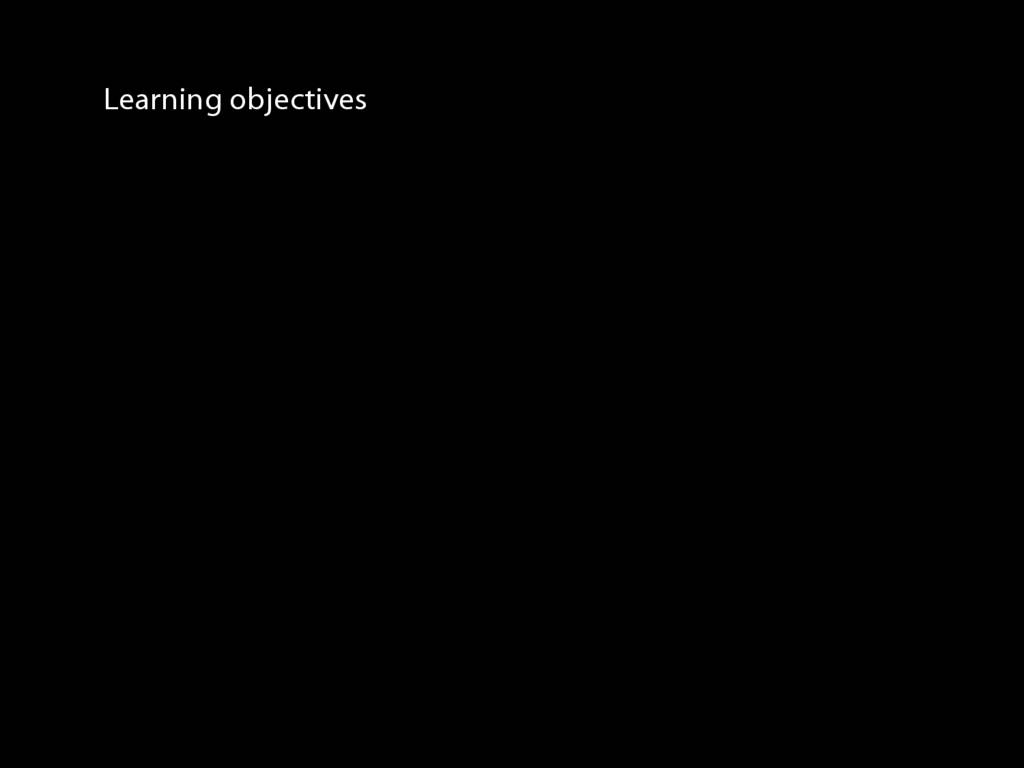
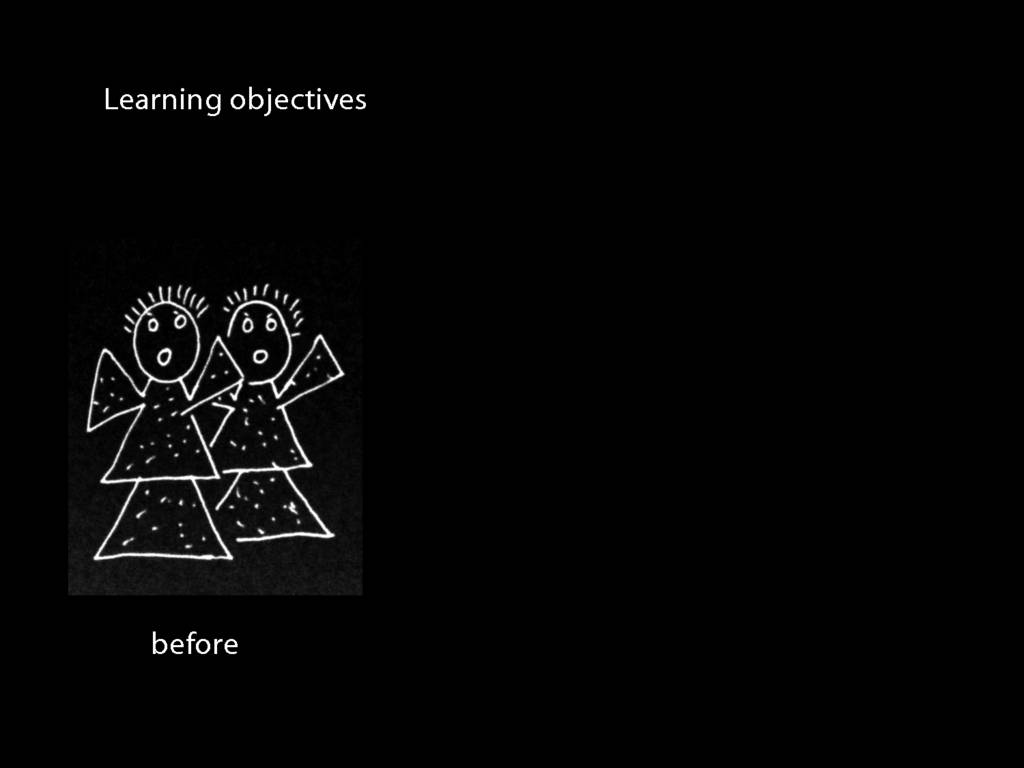


Counterexamples
\section{Counterexamples}
\emph{Reading:} §2.5
\section{Counterexamples}
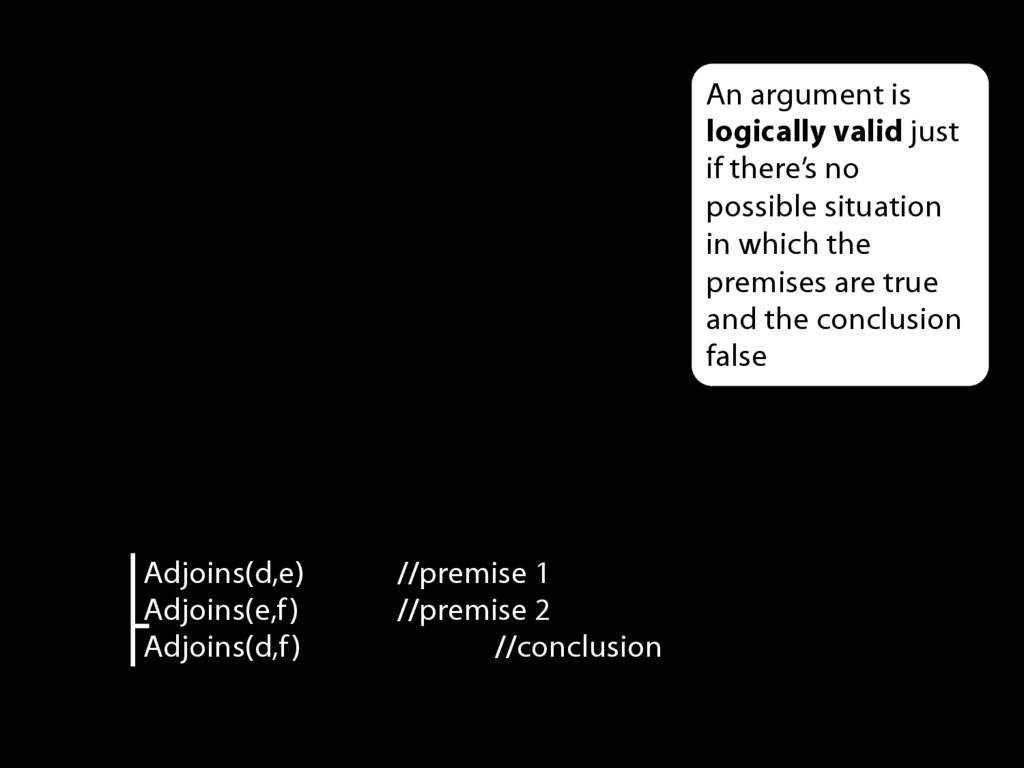
A \emph{counterexample} to an argument is a possible situation in which its premises are T and its conclusion F.
There are no counterexamples to a logically valid argument.
If an argument is not valid, then there is a counterexample to it.
To show that an argument is not logically valid, we specify a counterexample to it.
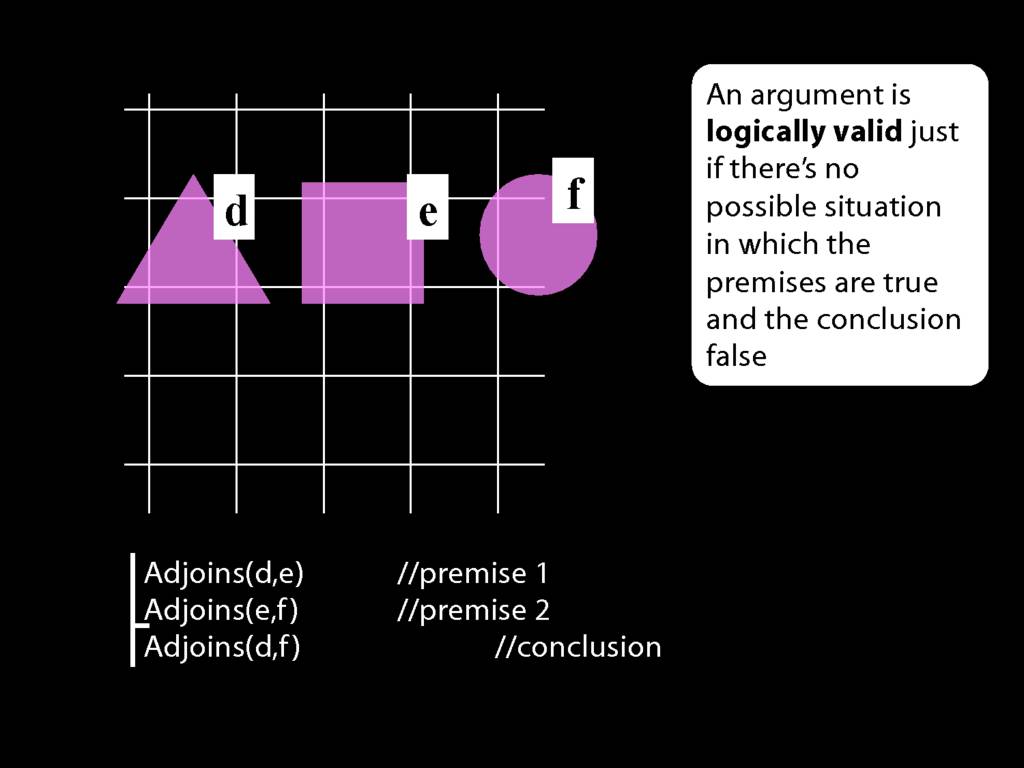

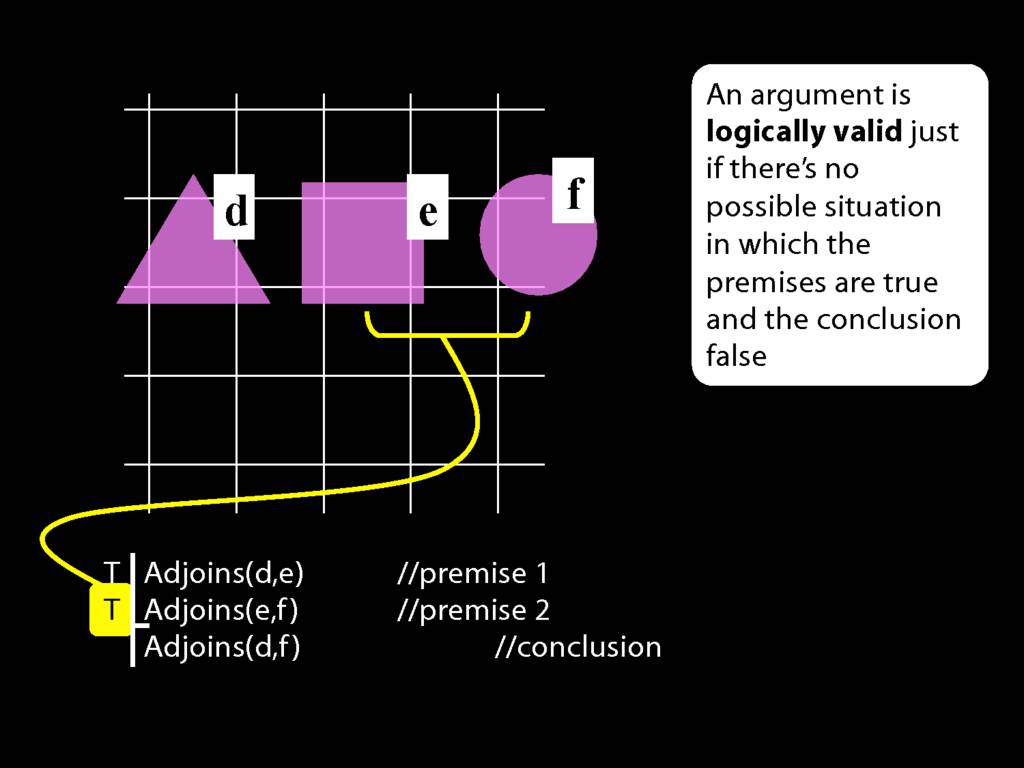
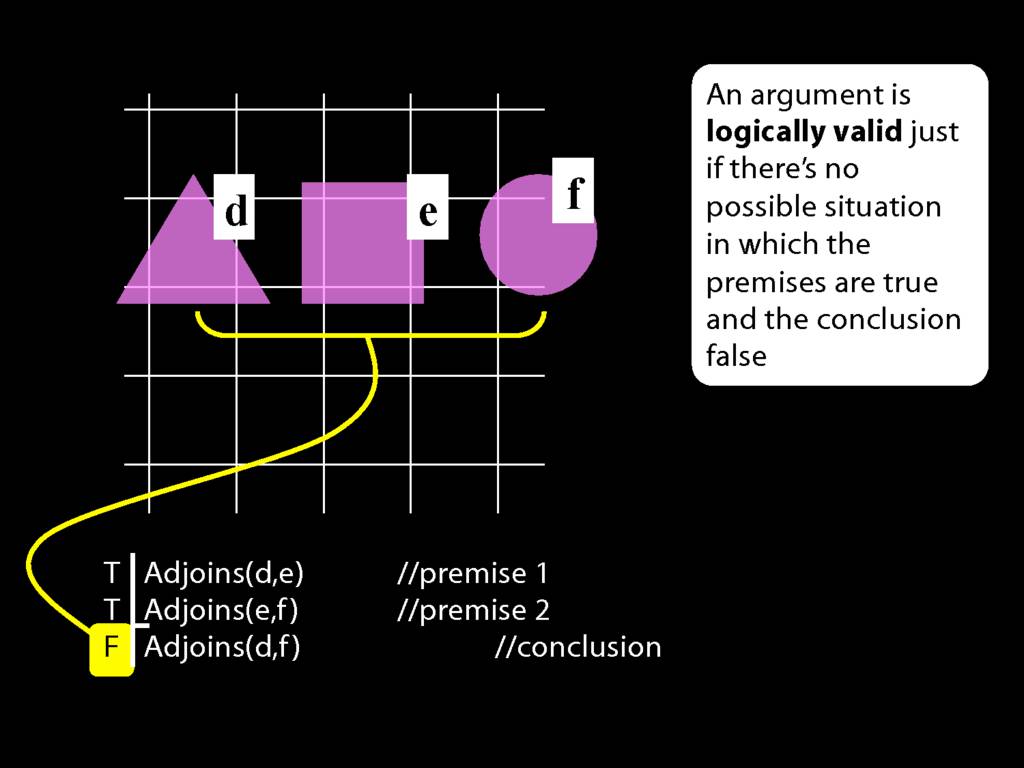
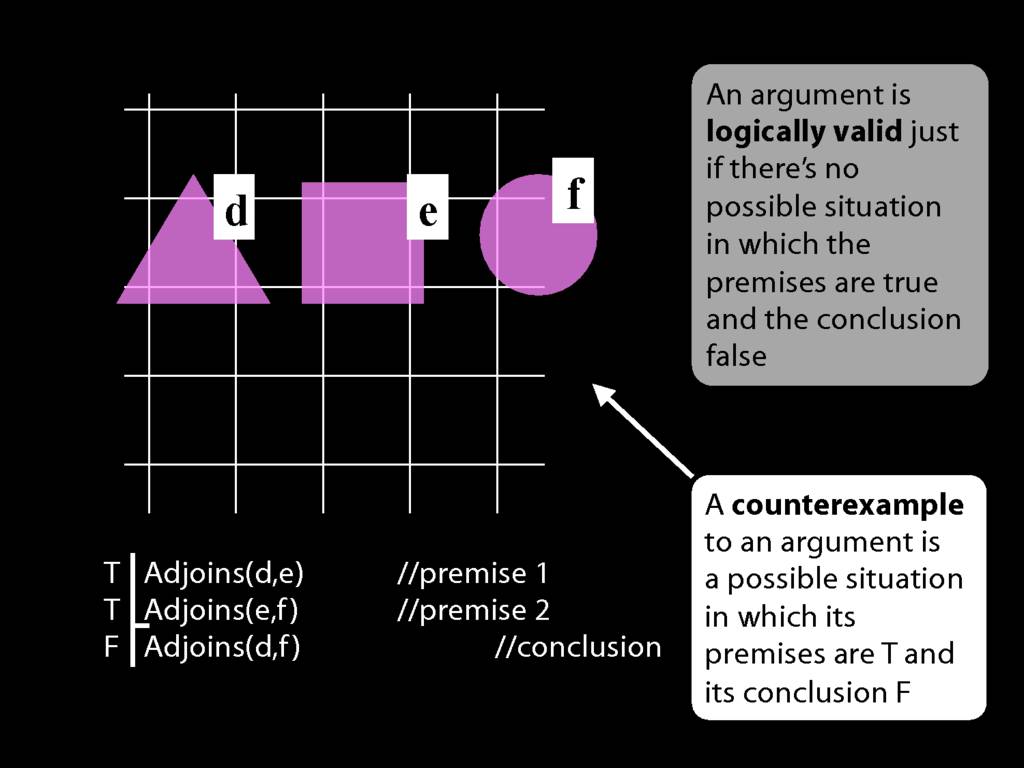
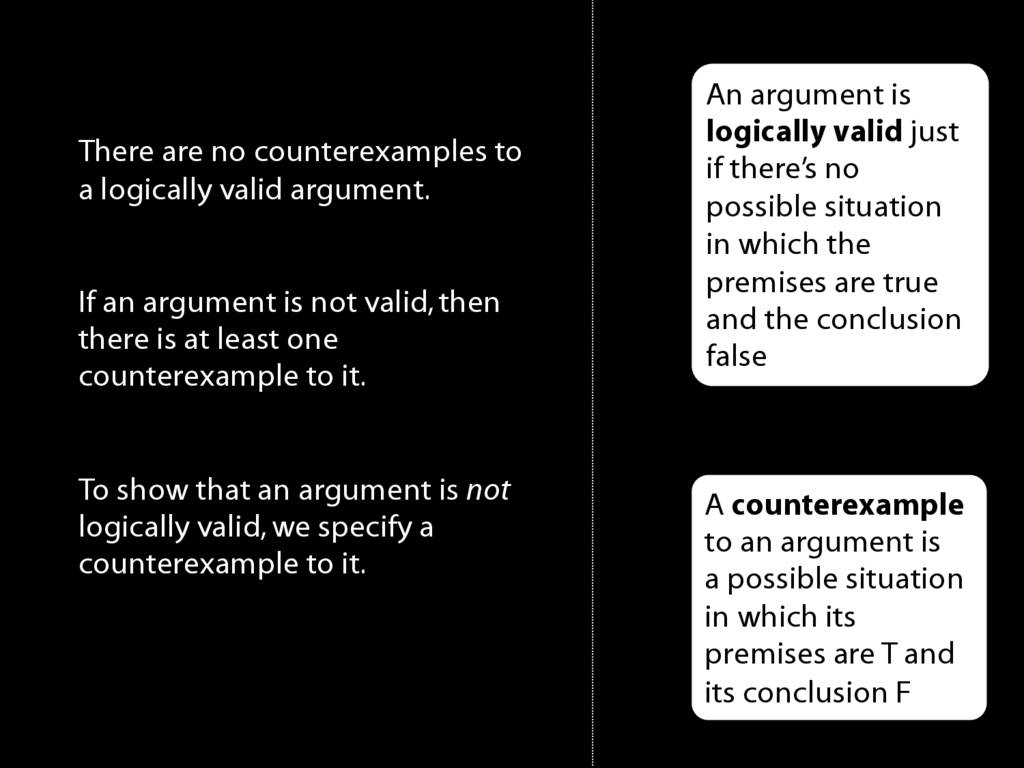
https://logic-ex.butterfill.com/ex/create/from/SameShape(a,b)/to/SameSize(a,b)
Let’s see how to create counterexamples in this in logic-ex.
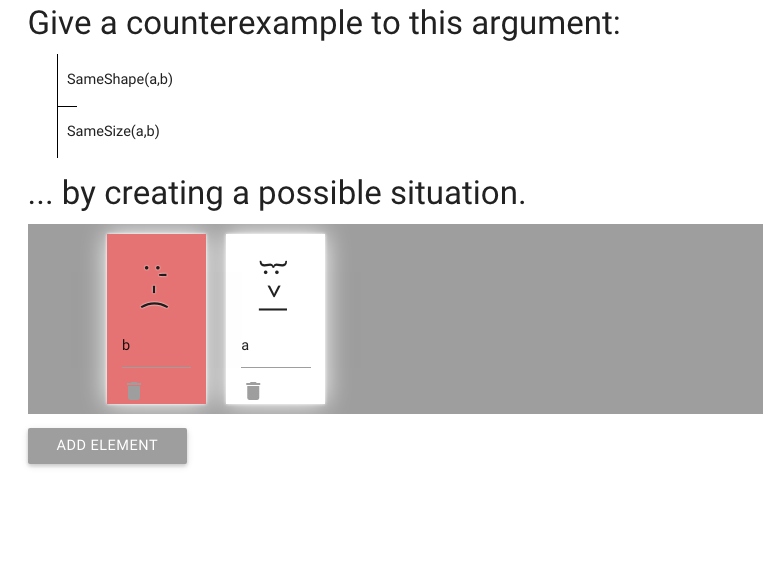
We have to create a counterexample to an argument.
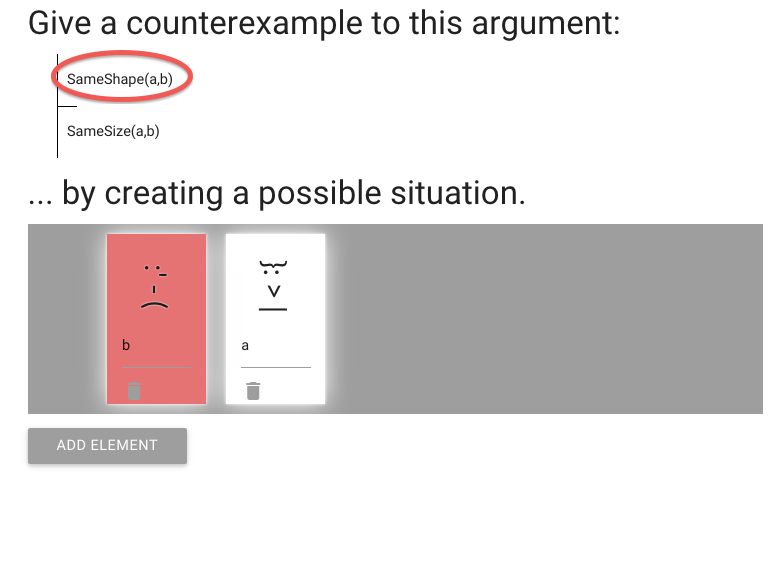
So the premise must be true ...
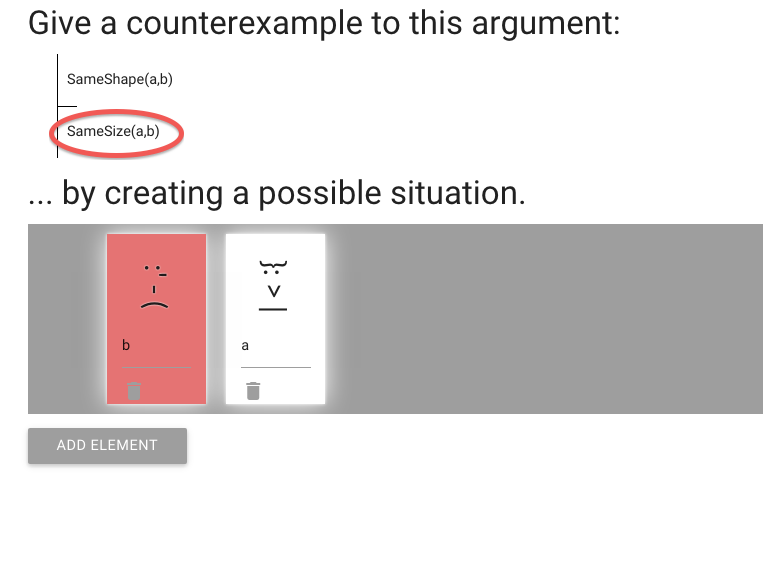
... and the conclusion must be false.
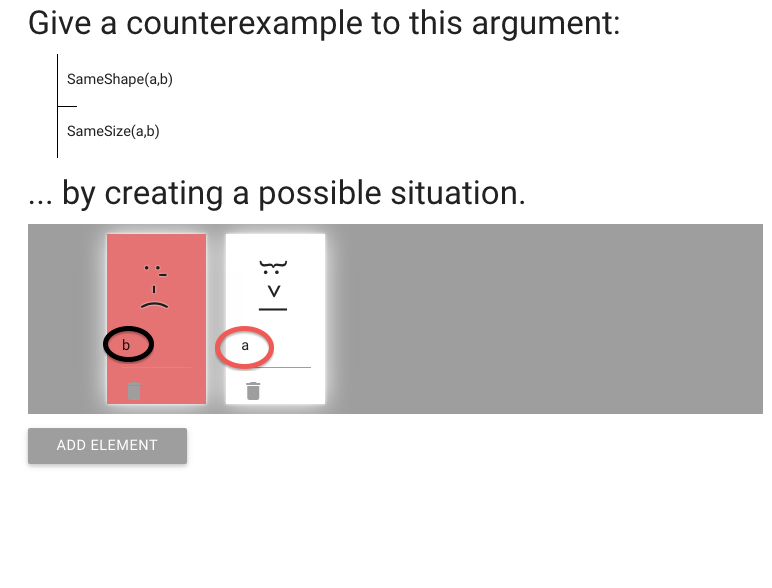
I already put the names in; without having things named ‘a’ and ‘b’
the sentences would not be true or false in our possible situation.
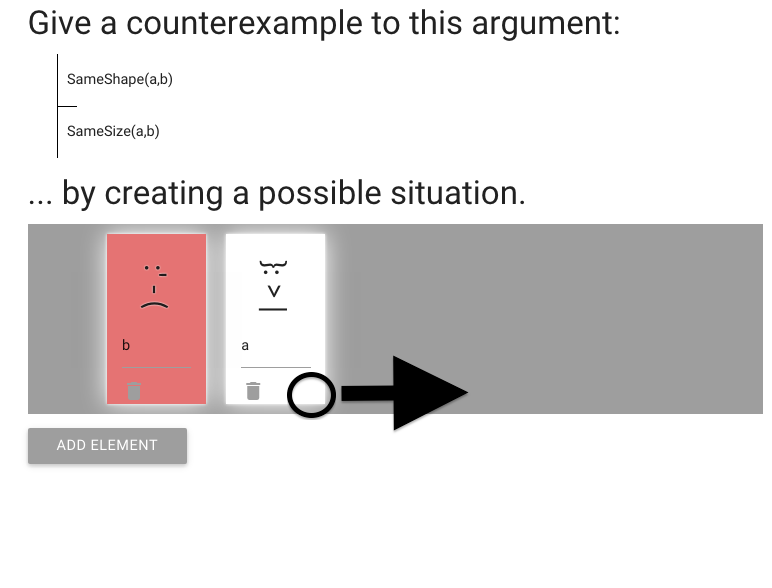
We need to make the conclusion false.
At the moment it’s true because a and b are the same size.
So let’s change the size of a.
Do this by dragging the corner to stretch her.

Now a is wider.
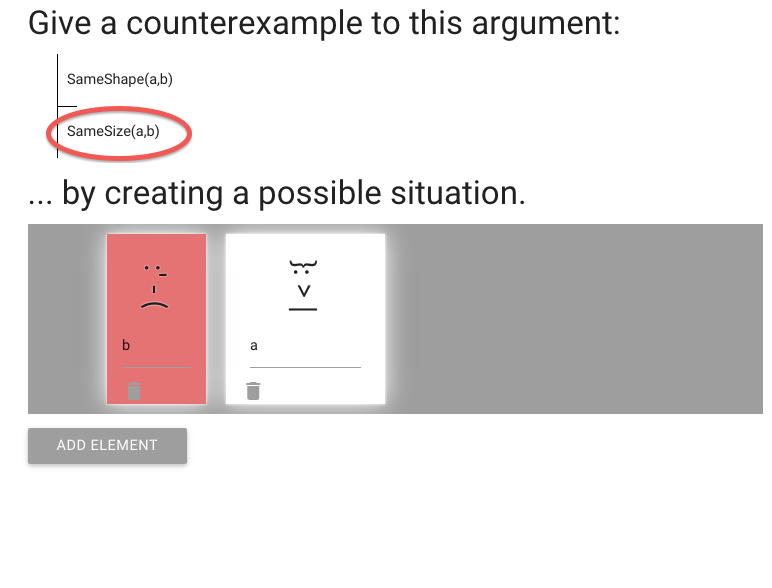
This makes the conclusion false, as we wanted.
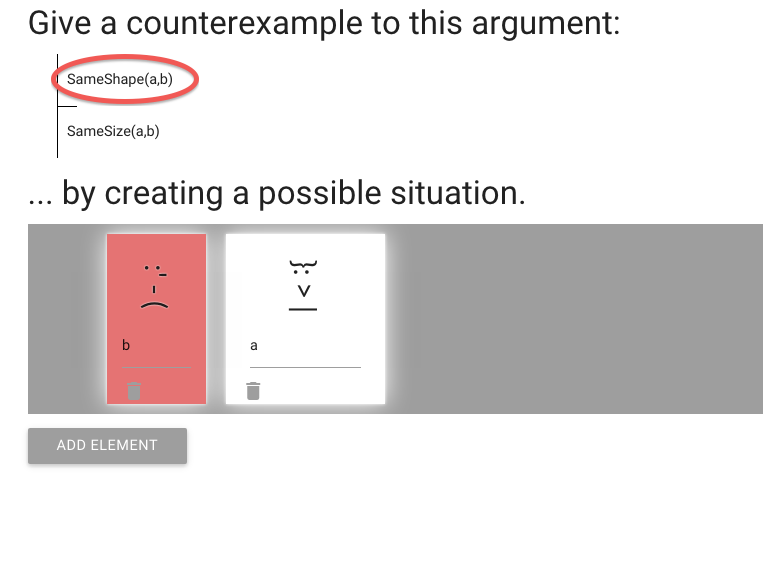
But now the premise is false too.
(This is often the problem with creating counterexamples.)
What can we do?
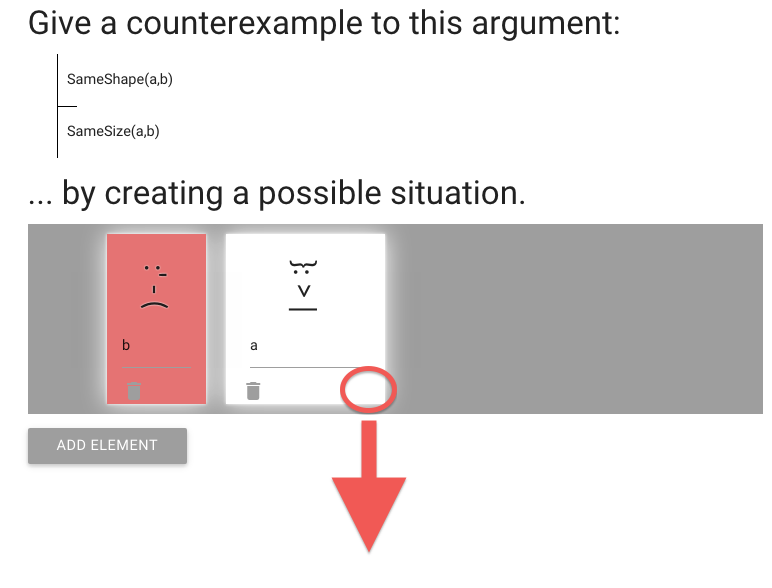
Let’s make a taller as well by stretching her down.
Do this by dragging the corner.
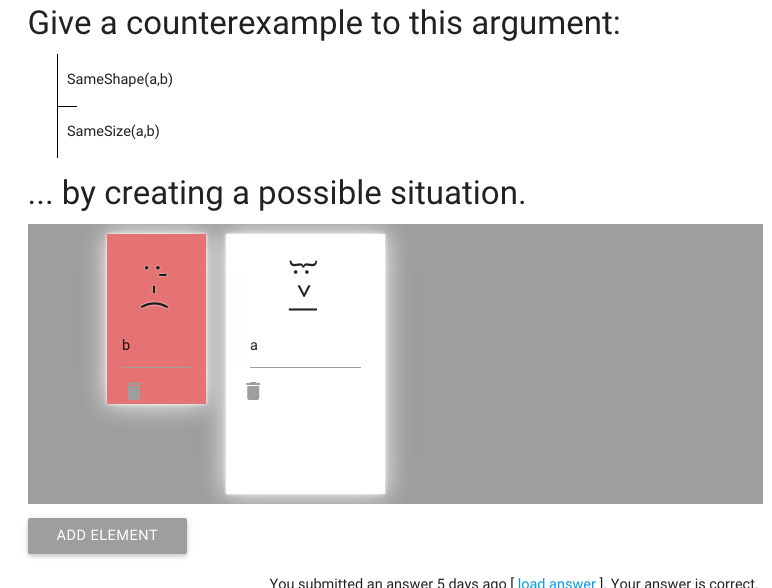
Now a is both wider and taller than b.
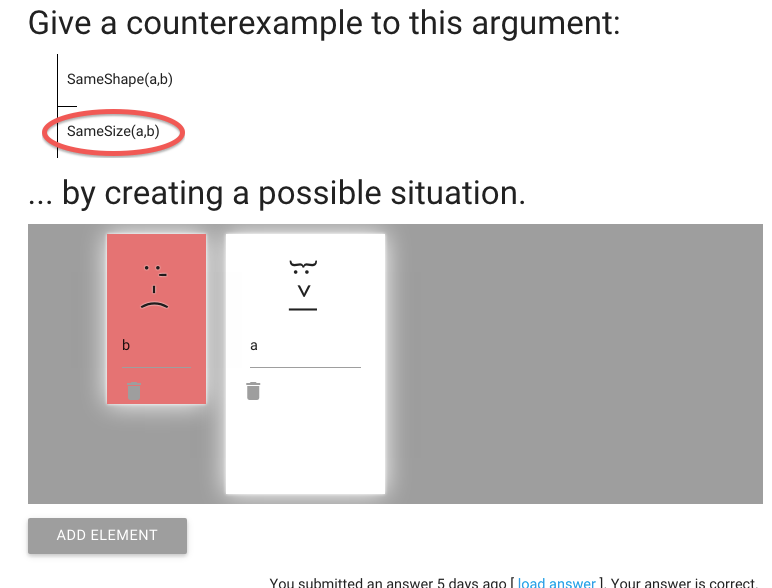
So the conclusion is still false ...
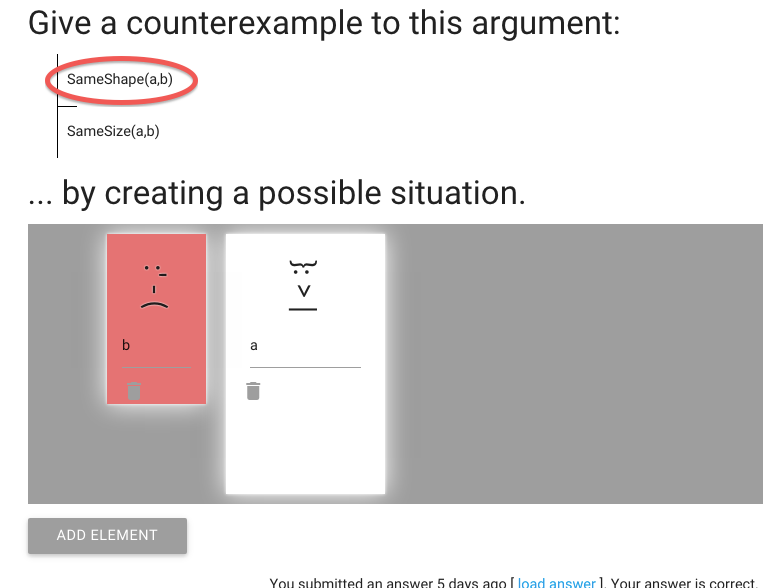
... but now the premise is true, just as we wanted.
A counterexample to an argument is a possible situation in which its premises are true and its conclusion is false.
2.8, 2.10, 2.12, 2.21
2.8, 2.10, 2.12, 2.21

Soundness
\section{Soundness}
\section{Soundness}

An argument is \emph{sound} just if it is logically valid and its premises are true
Whether a sentence is true may change as the world changes.
The same applies to whether an argument is sound.
Whether an argument is logically valid not does change as the world changes.
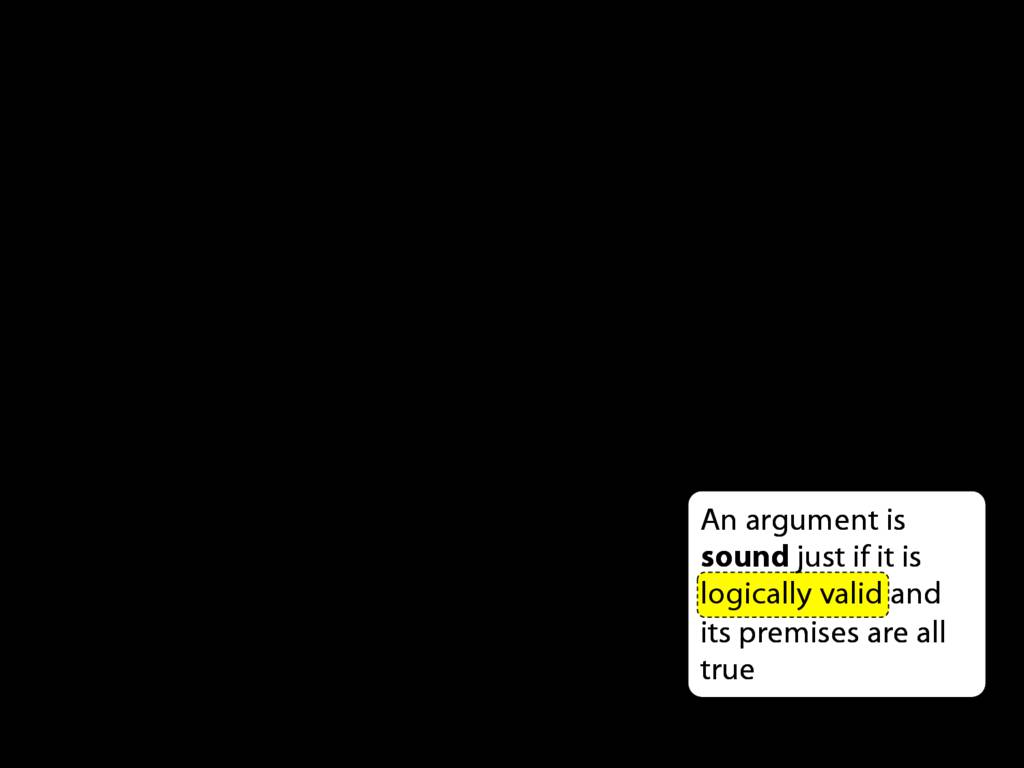
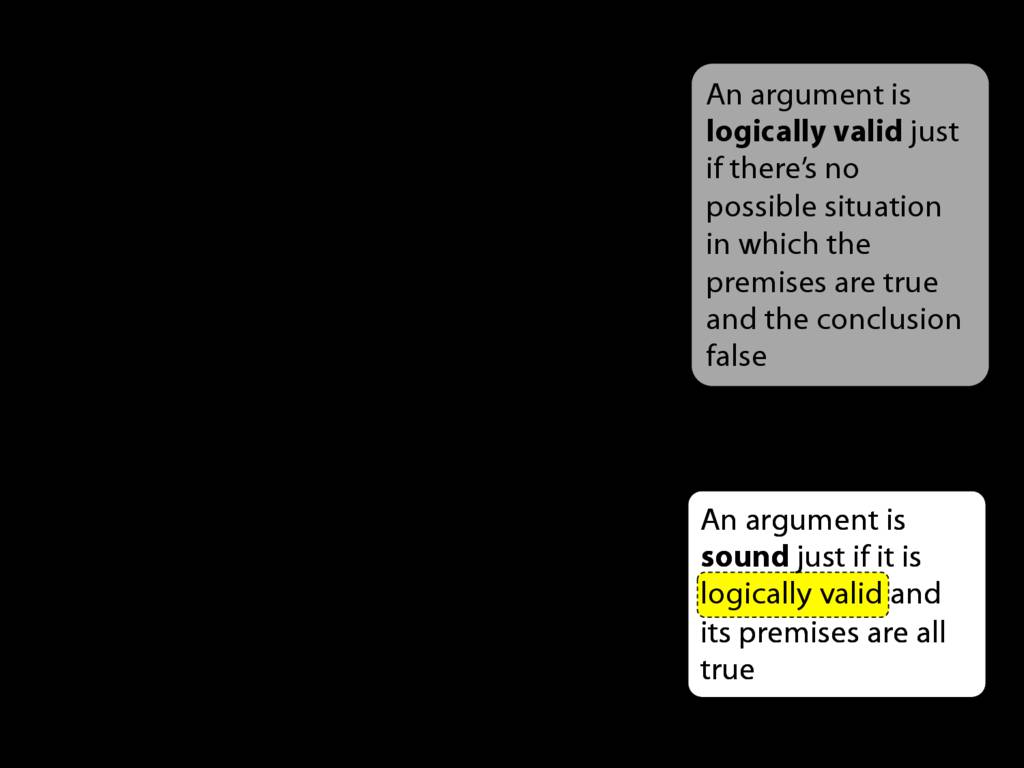
| | 1. | All cats are grey | |
| | 2. | Catmando is grey | |
| | 3. | Catmando is a cat |
‘Catmando, Joint leader of the Official Monster Raving Loony Party from 1999 to 2002.’
This argument isn’t valid so of course it won’t be sound.
Let’s fix that

| | 1. | All cats are grey | |
| | 2. | Catmando is a cat | |
| | 3. | Catmando is grey |
‘Catmando, Joint leader of the Official Monster Raving Loony Party from 1999 to 2002.’
Now the argument is valid, but is it sound?
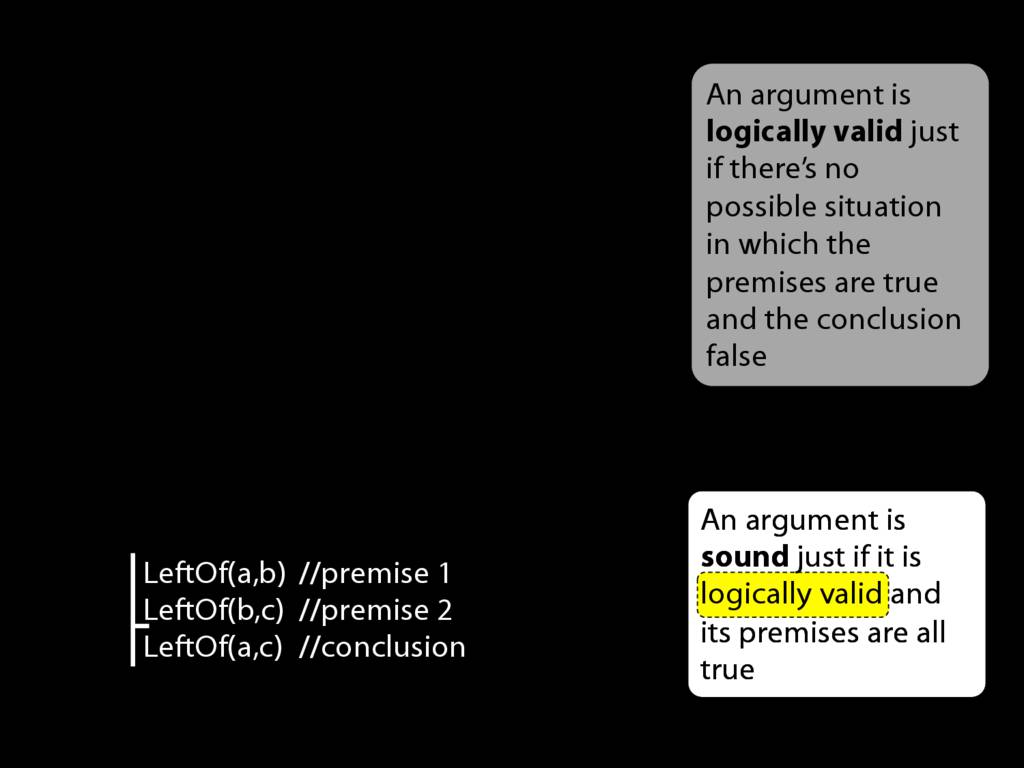
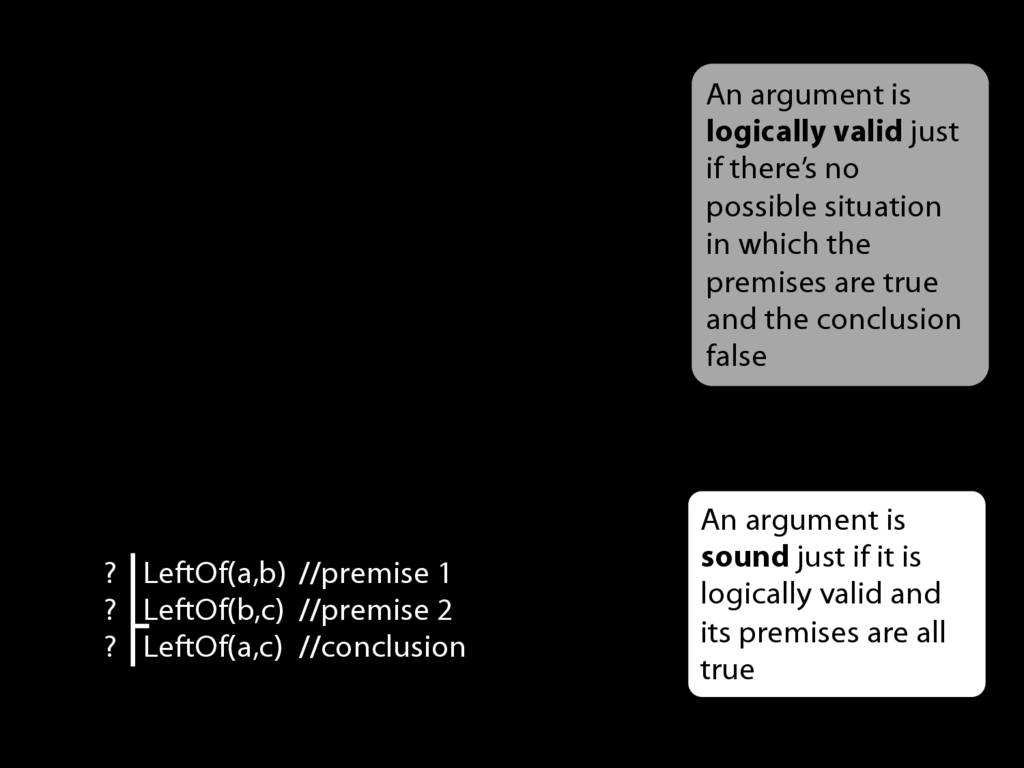
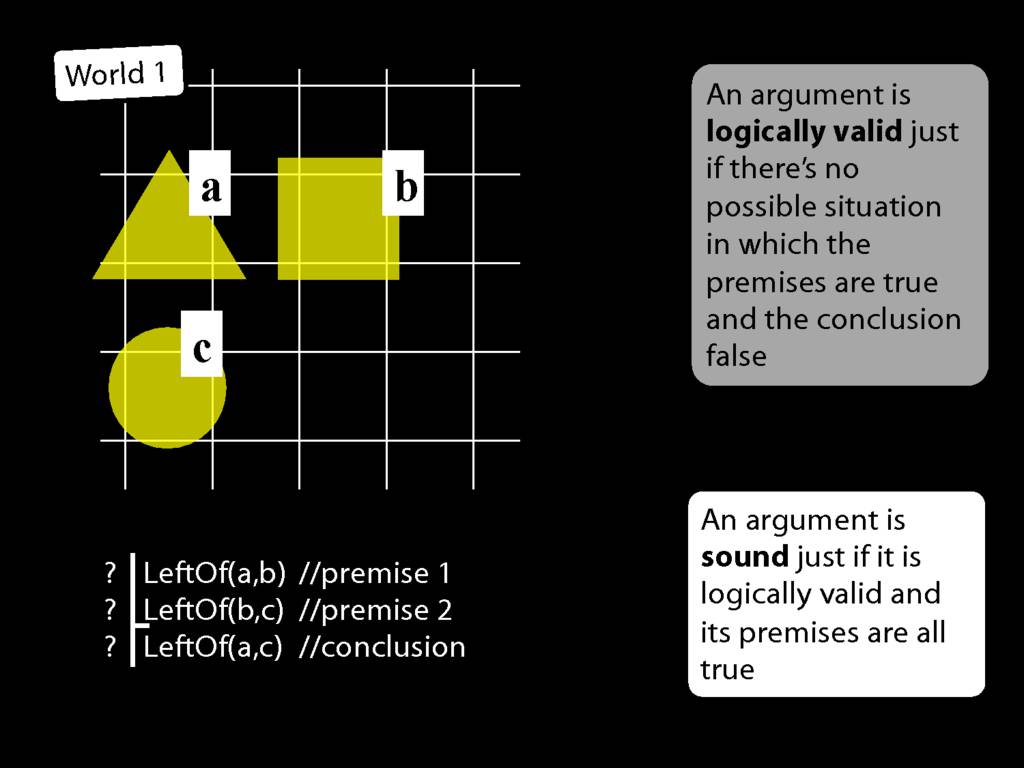
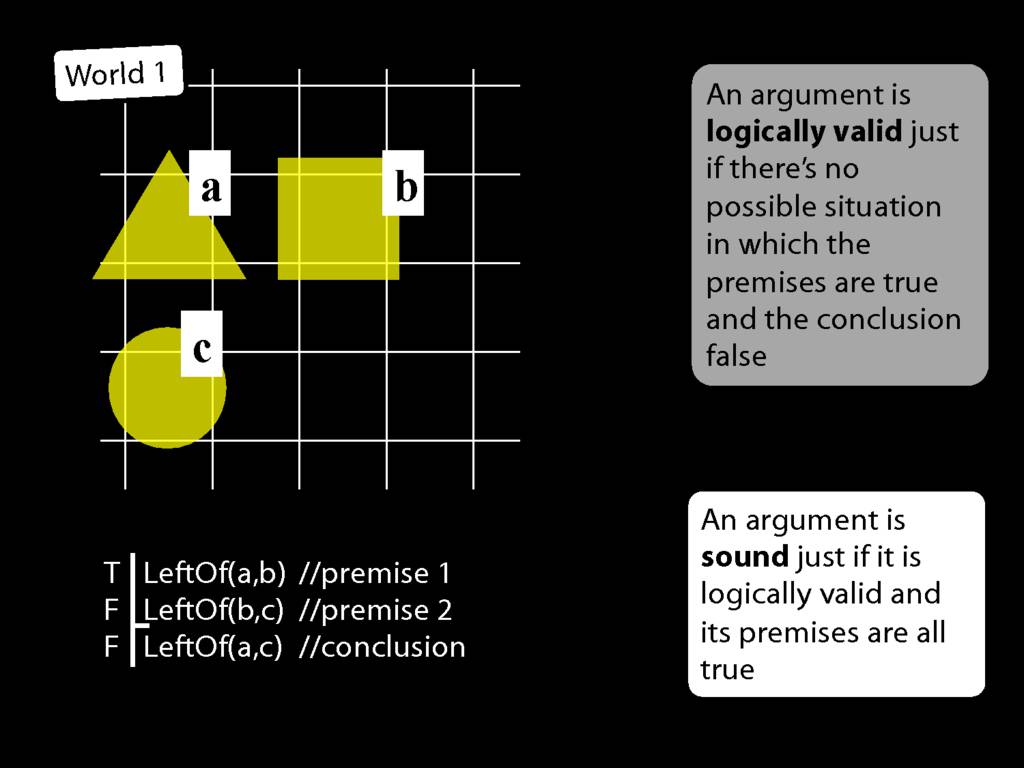
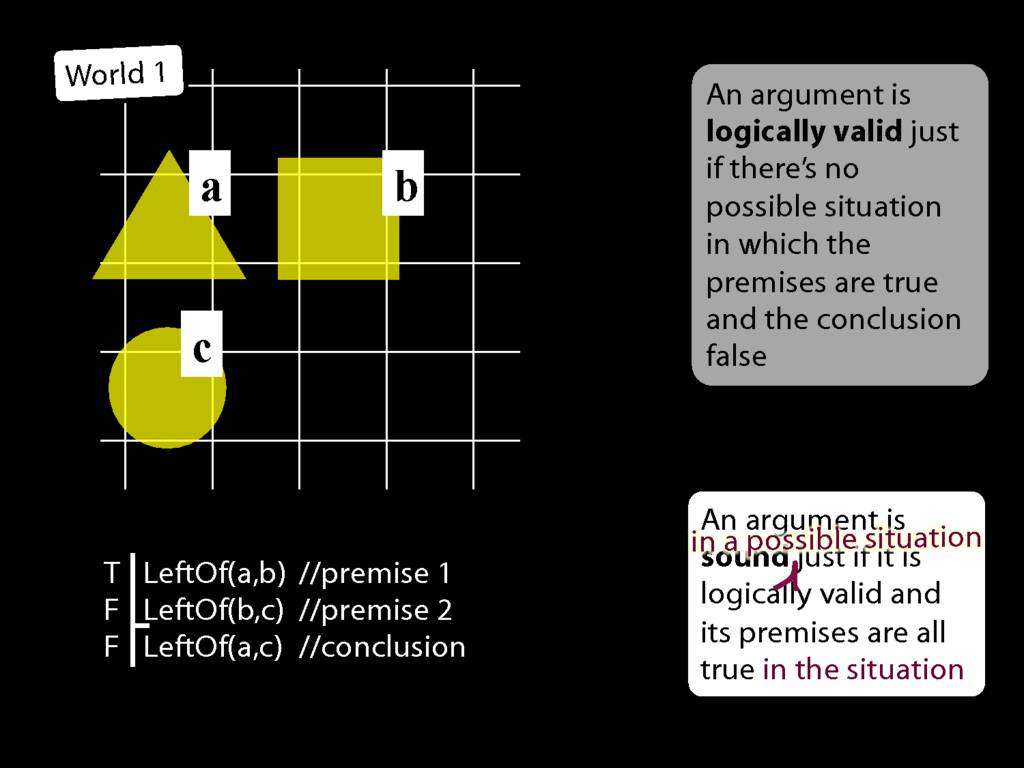
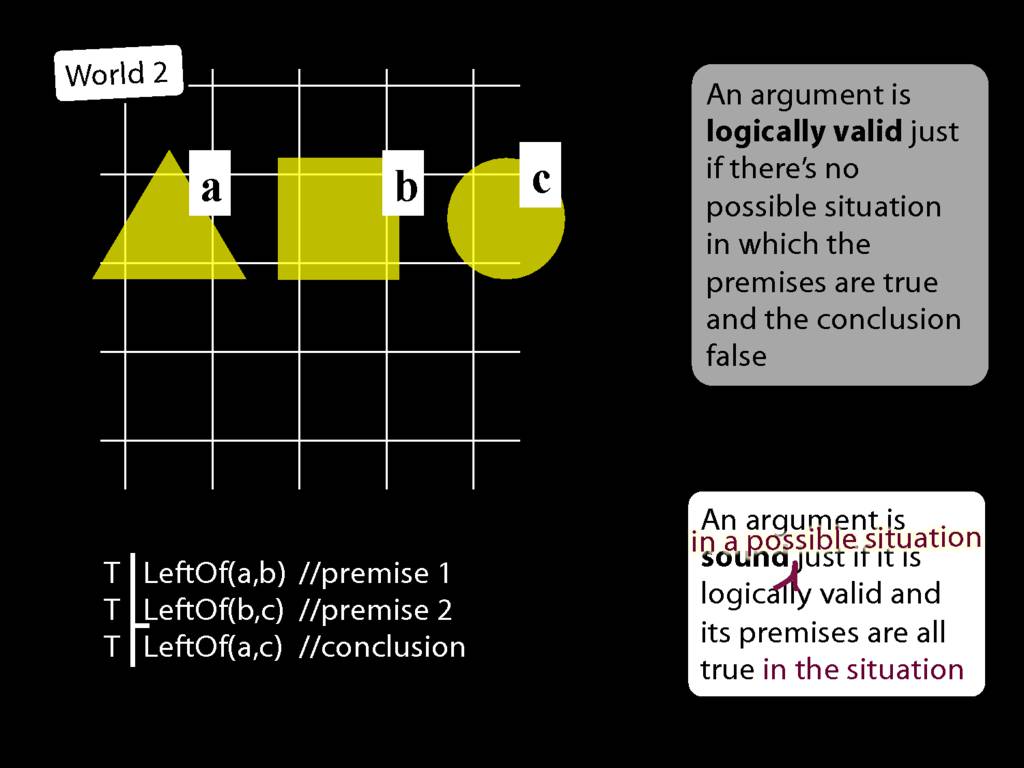
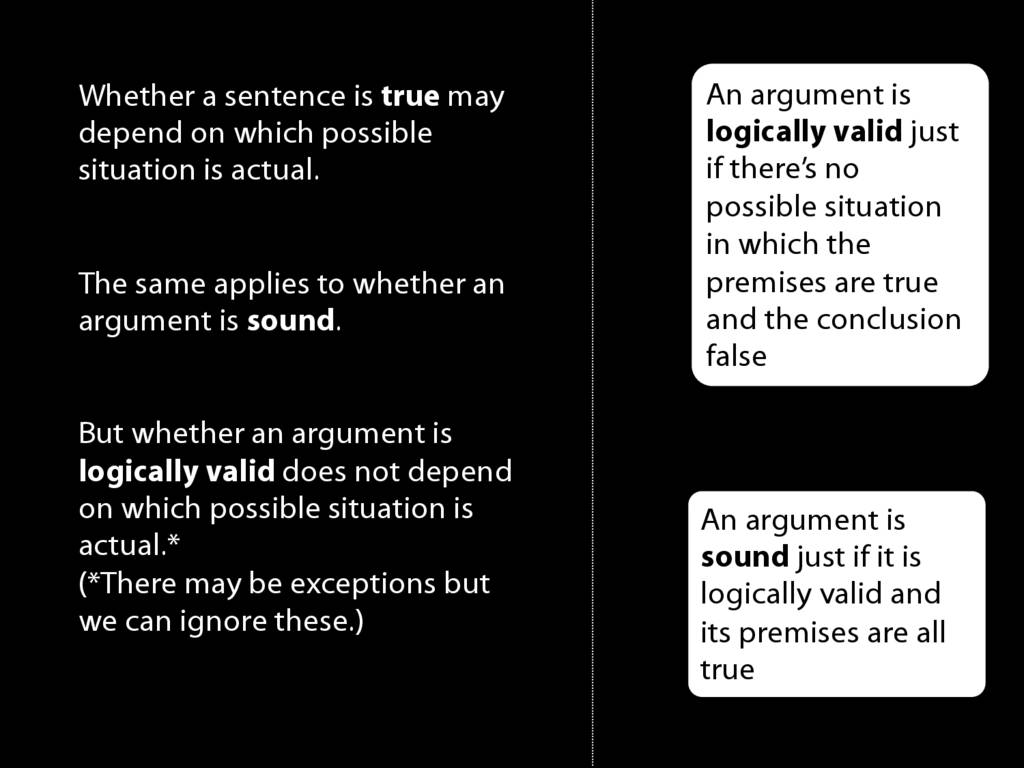

Identity
\section{Identity}
\emph{Reading:} §2.2
\section{Identity}
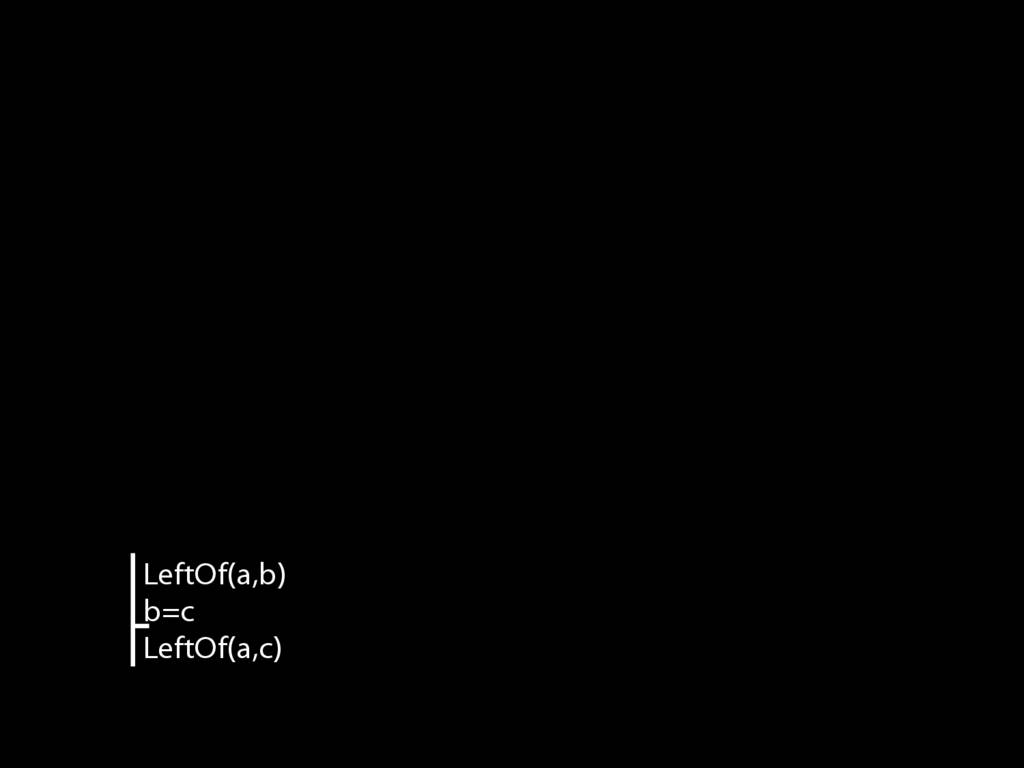
Here’s an argument involving identity. Let’s see if it’s valid.
Principle: If b=c then whatever is true of b is also true of c.
Principle: a=a is never false
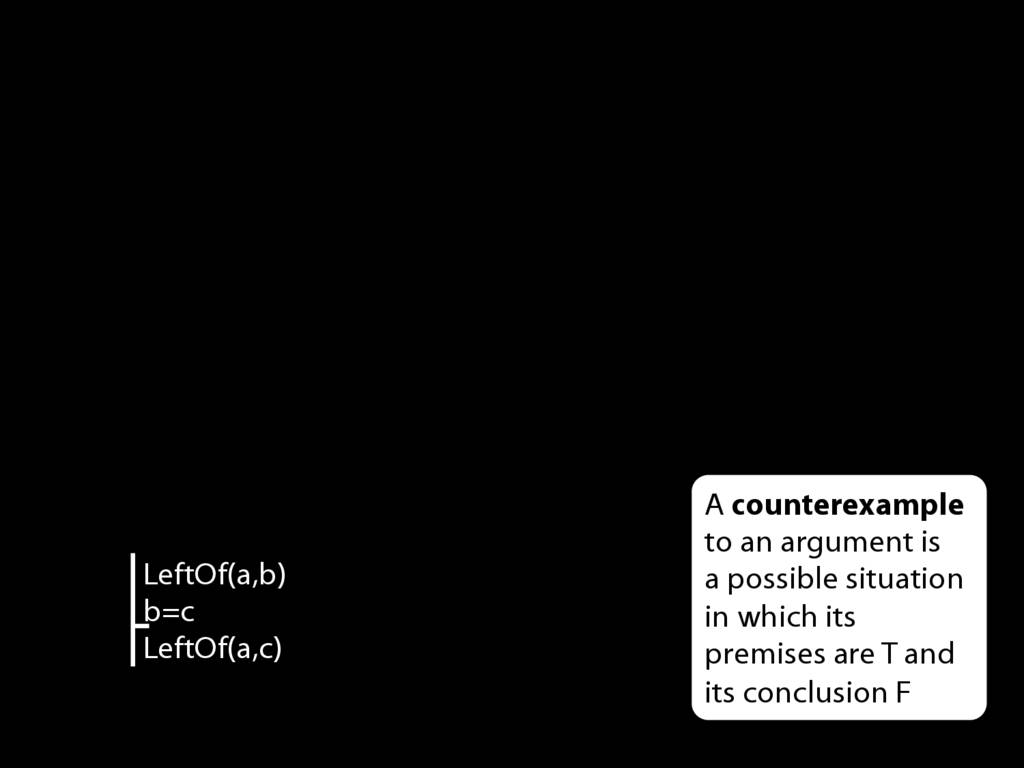
Suppose we want to find a counterexample. So we need to make make the premises true. Let’s see if we can make them true without making the conclusion true.
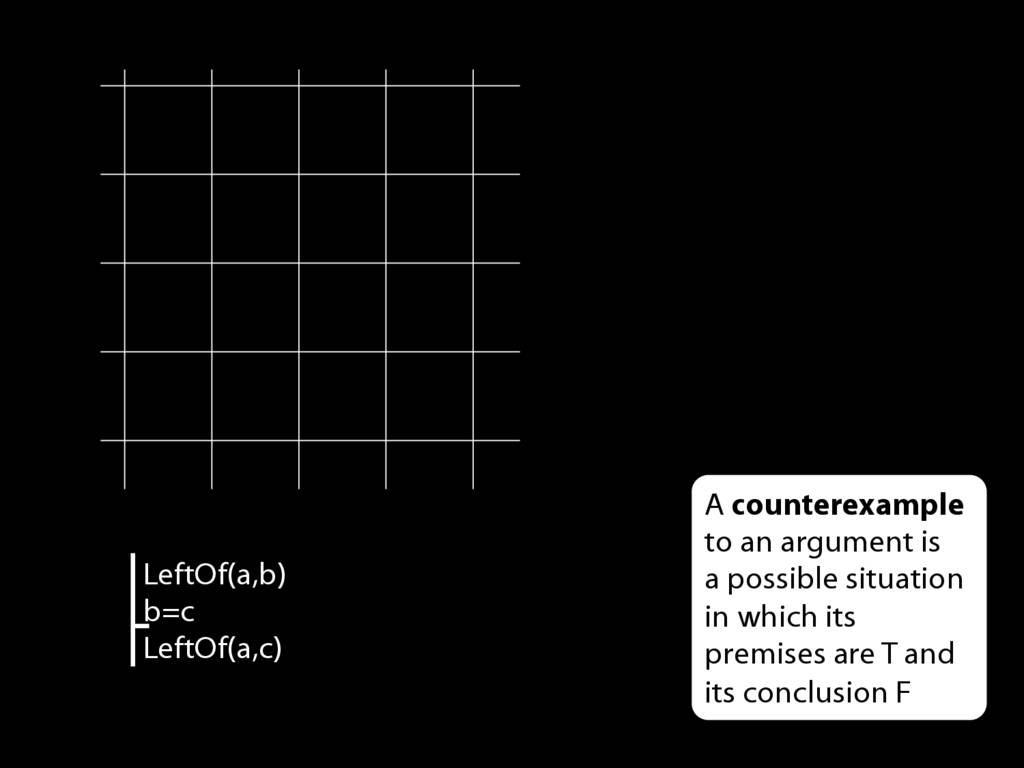
Start with an empty world.
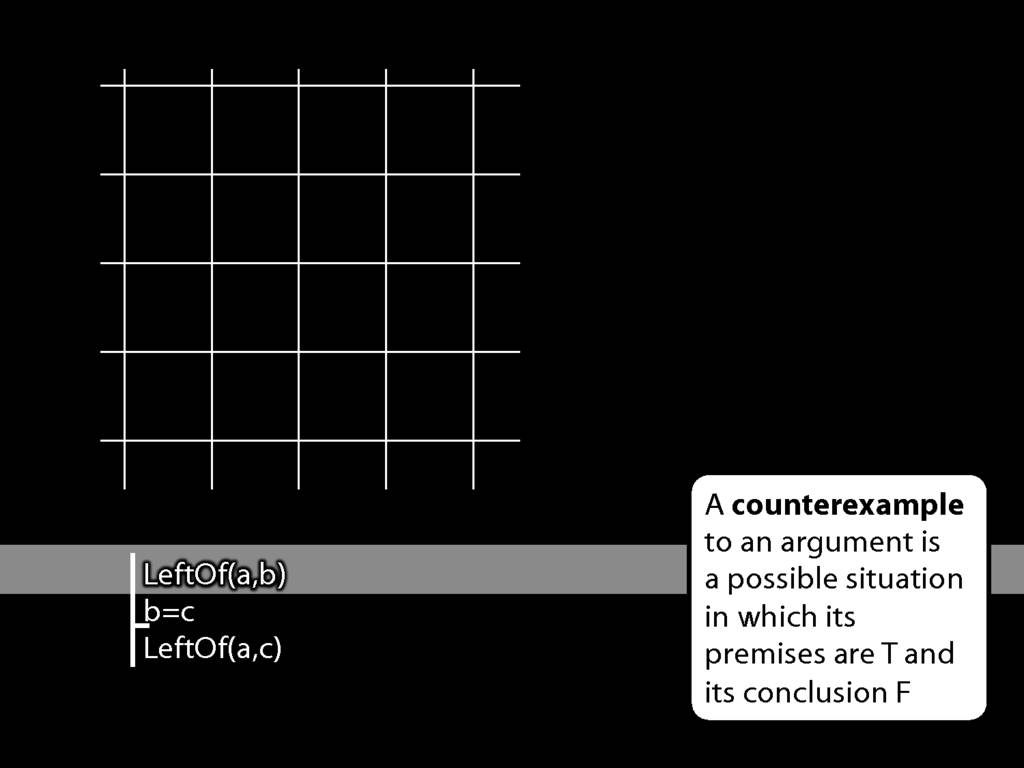
Consider the first premise
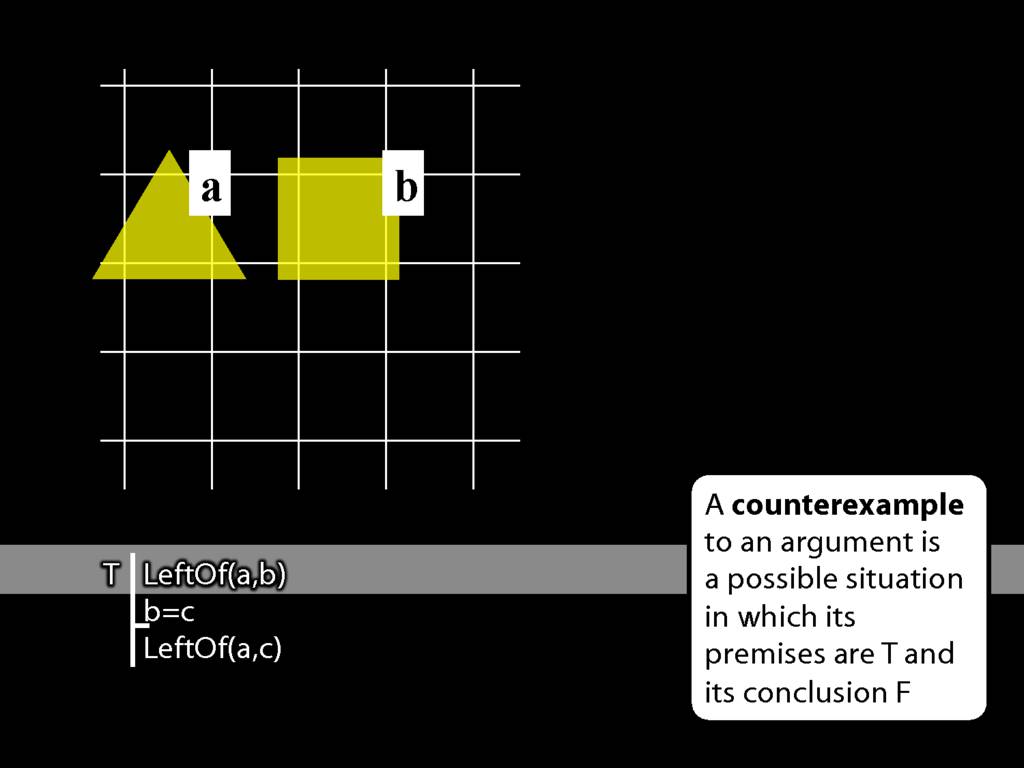
We want the first premise to be true so we have to put a to the left of b.
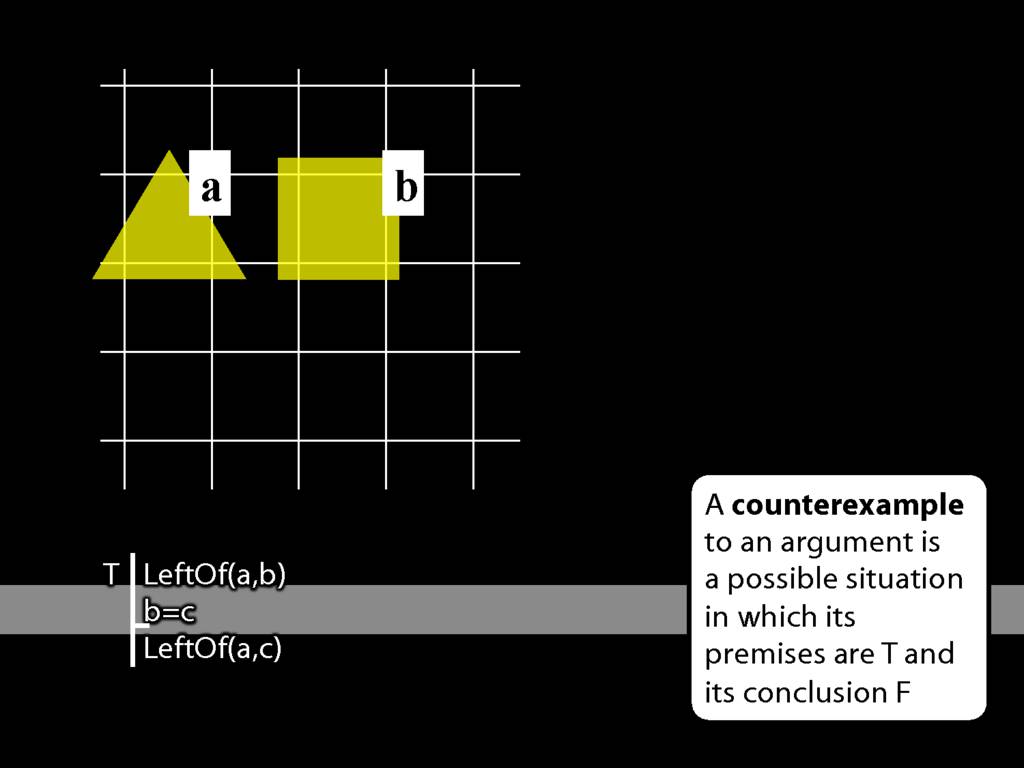
What about the second premise? So far the truth-value of the second and third premises are undefined because the name ‘c’ does not yet designate any object in this situation.
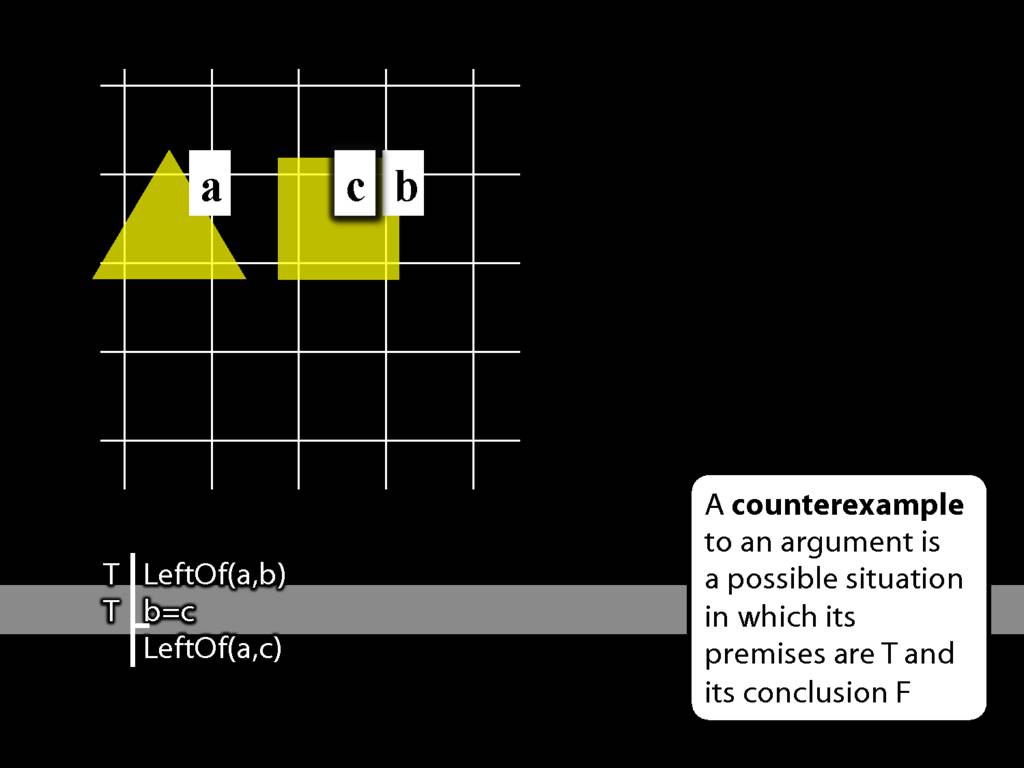
Want the second premise to be true so we have to label the b object c as well.
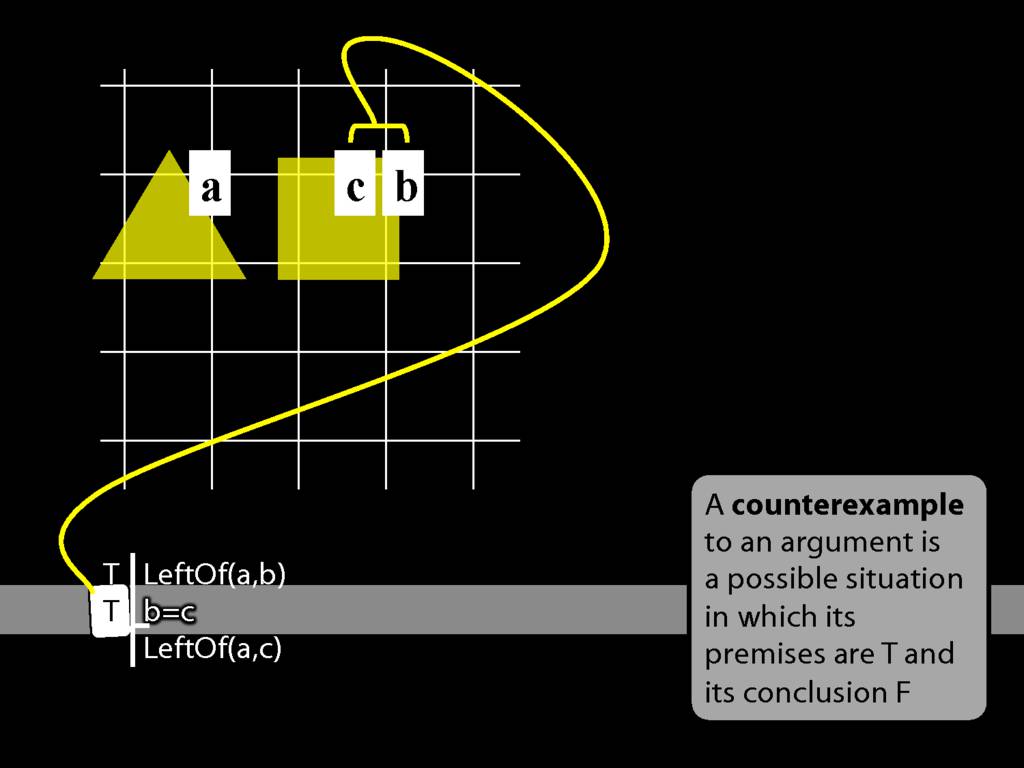
This is what b=c requires--that one and the same object have both labels.
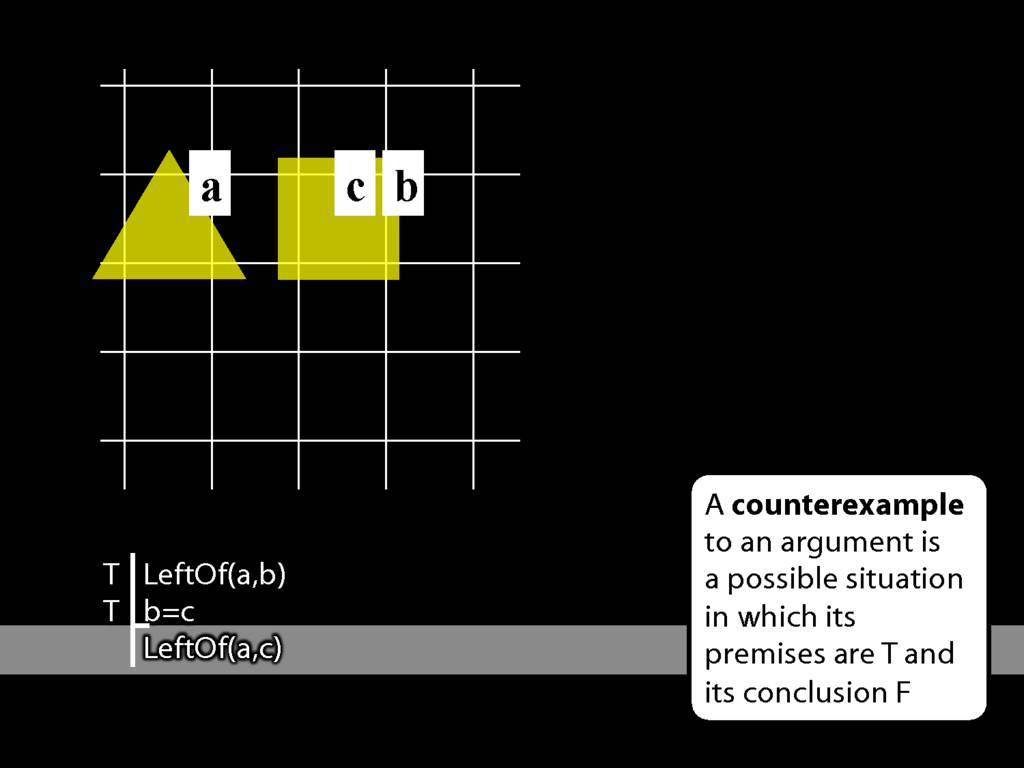
Now, what about the conclusion?
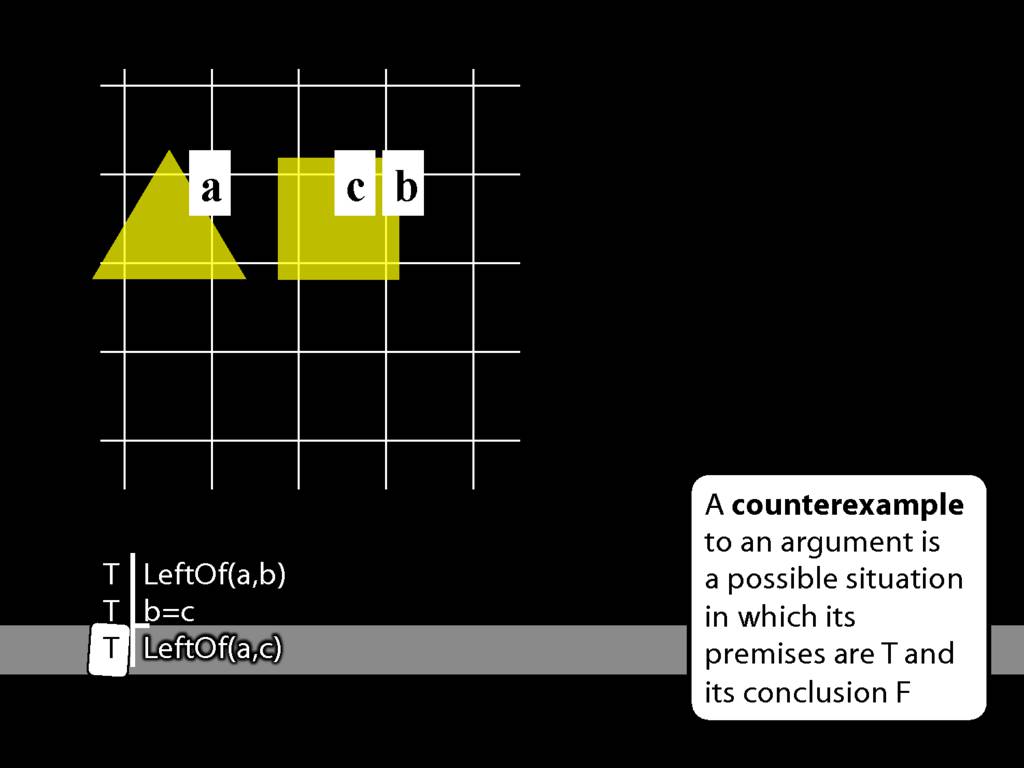
Having made the premises true, the conclusion turns out to be true as well.
This is sort of an informal proof that the argument is valid. If you think about what is involved in making the premises true, you can see that it guarantees the truth of the conclusion as well.
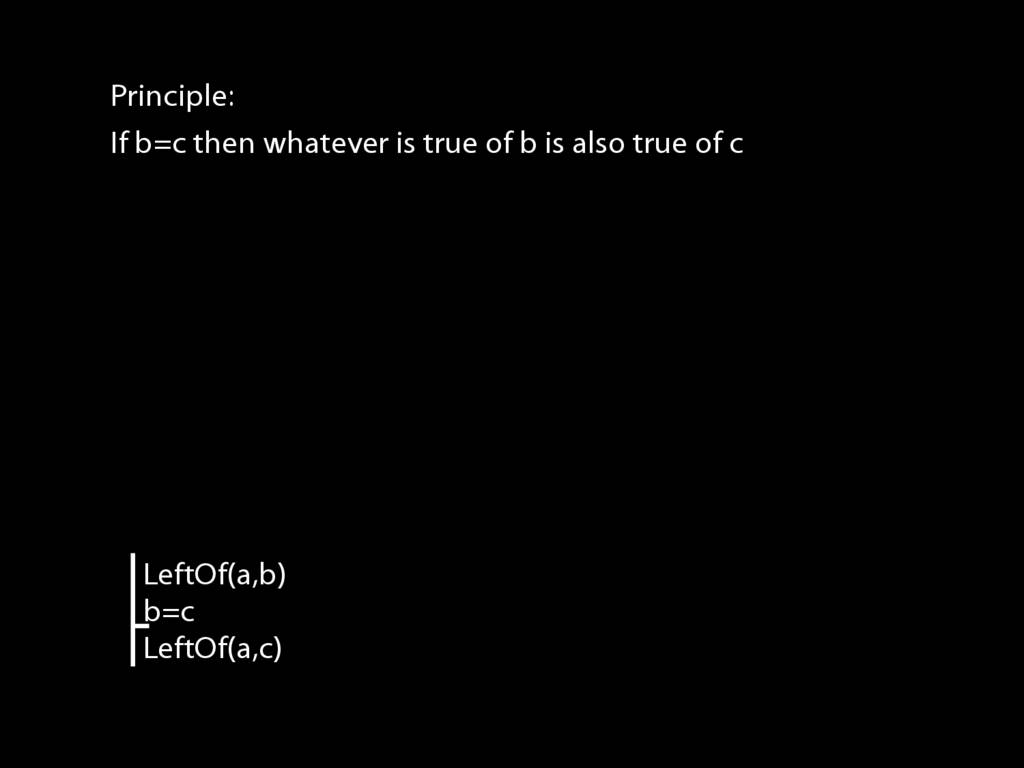
As far as the logic of identity goes, all you need to know are two principles.
This first principle.
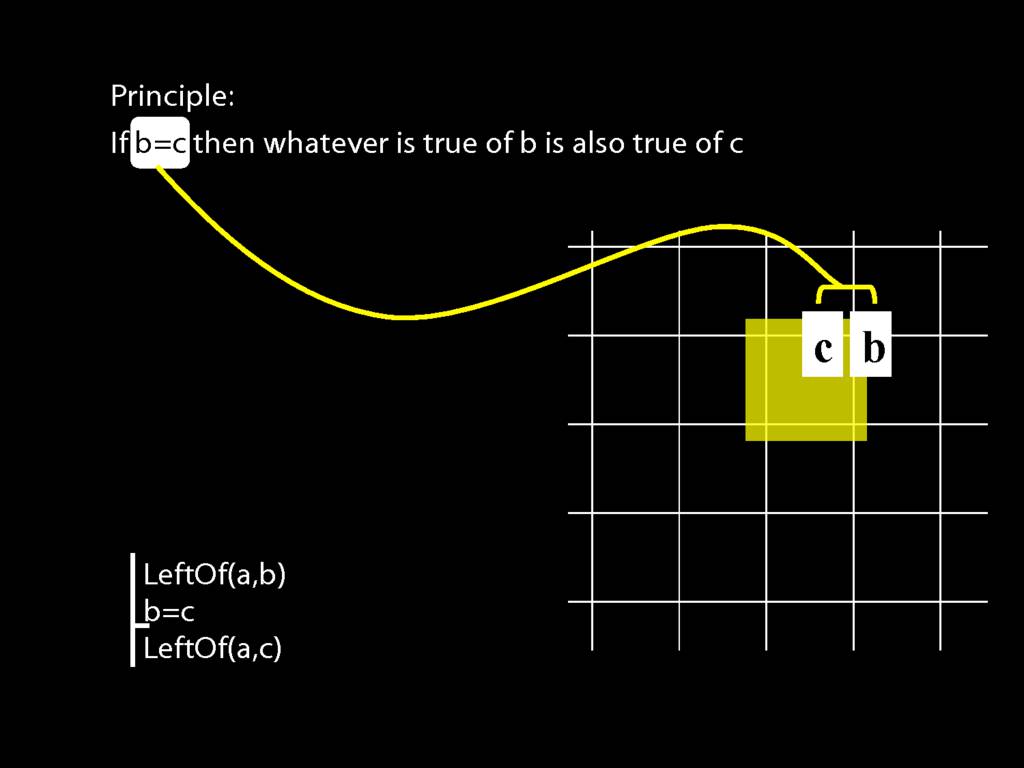
You can see that this principle must be true from the meaning of identity: b=c requires that one and the same object have both labels.
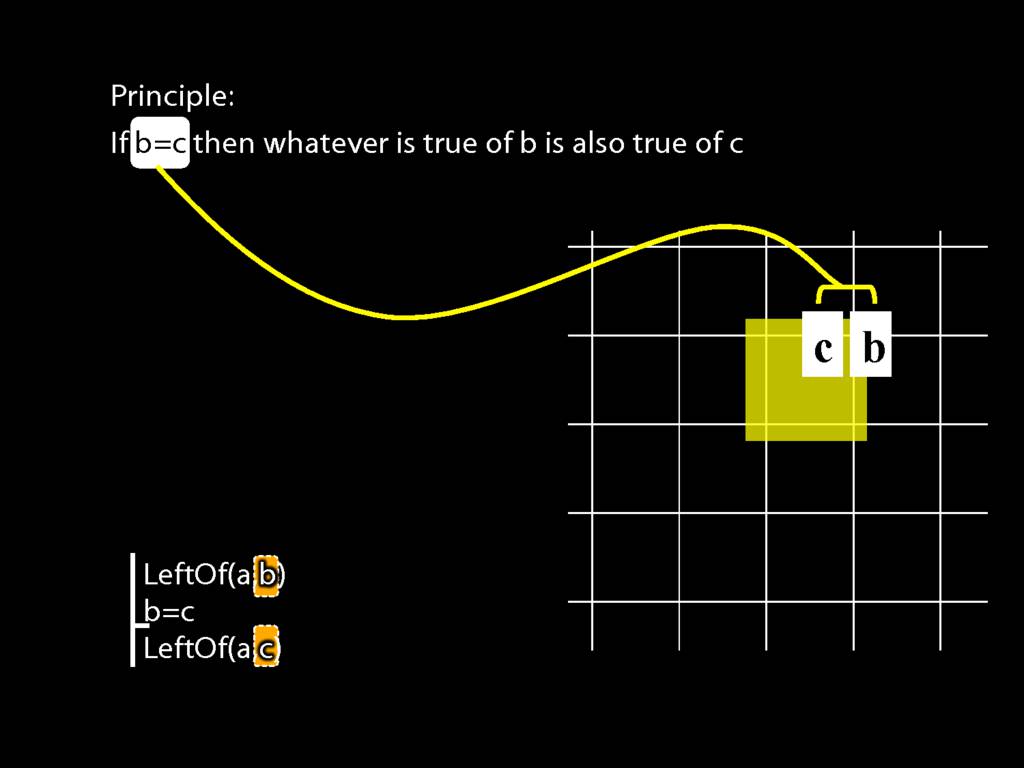
And this first principle is exactly what you need to prove the argument we were just looking at.
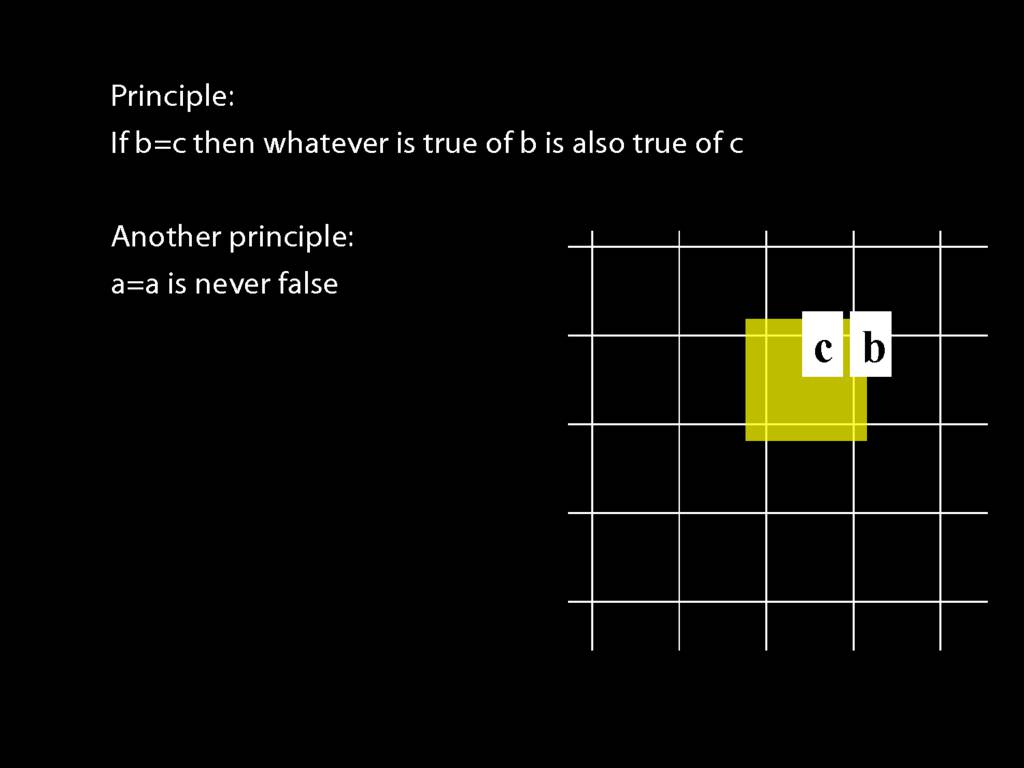
The second principle says, roughly, that everything is identical to itself.
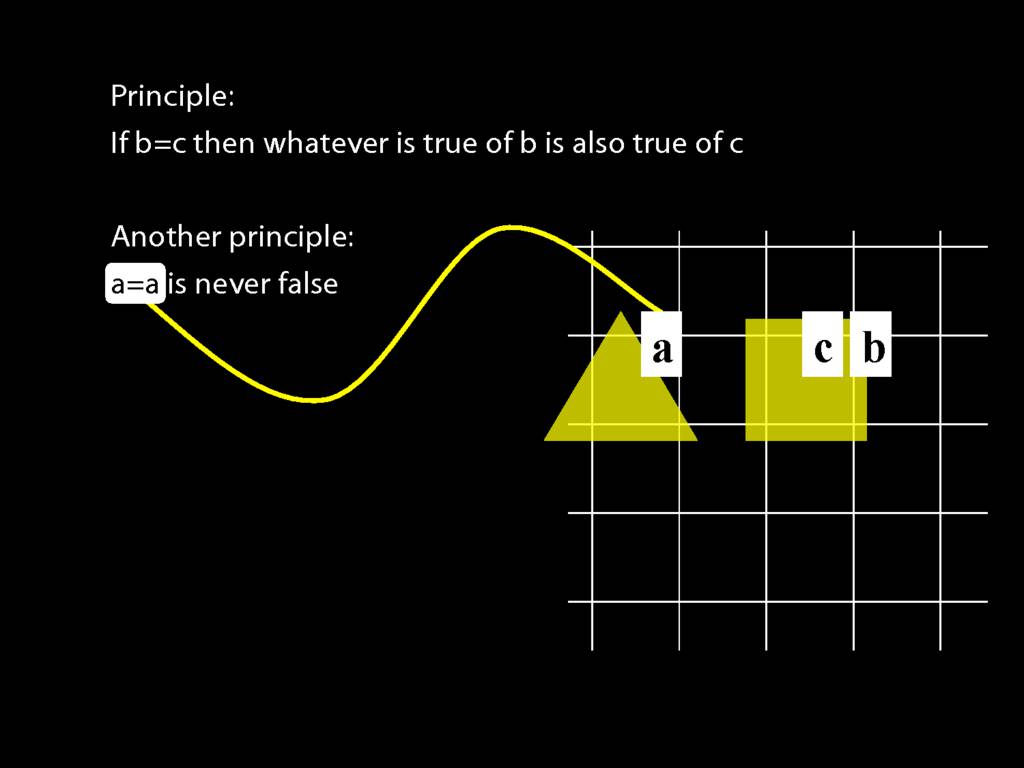
You can see that this principle must be true from the meaning of identity: a=a requires only that one and the object named 'a' be named 'a', which you can't really avoid. (In case you're thinking there's a tricky issue about what happens if nothing is named 'a', well done. In our system of logic, we rule that possibility out by stipulation to keep things simple.)
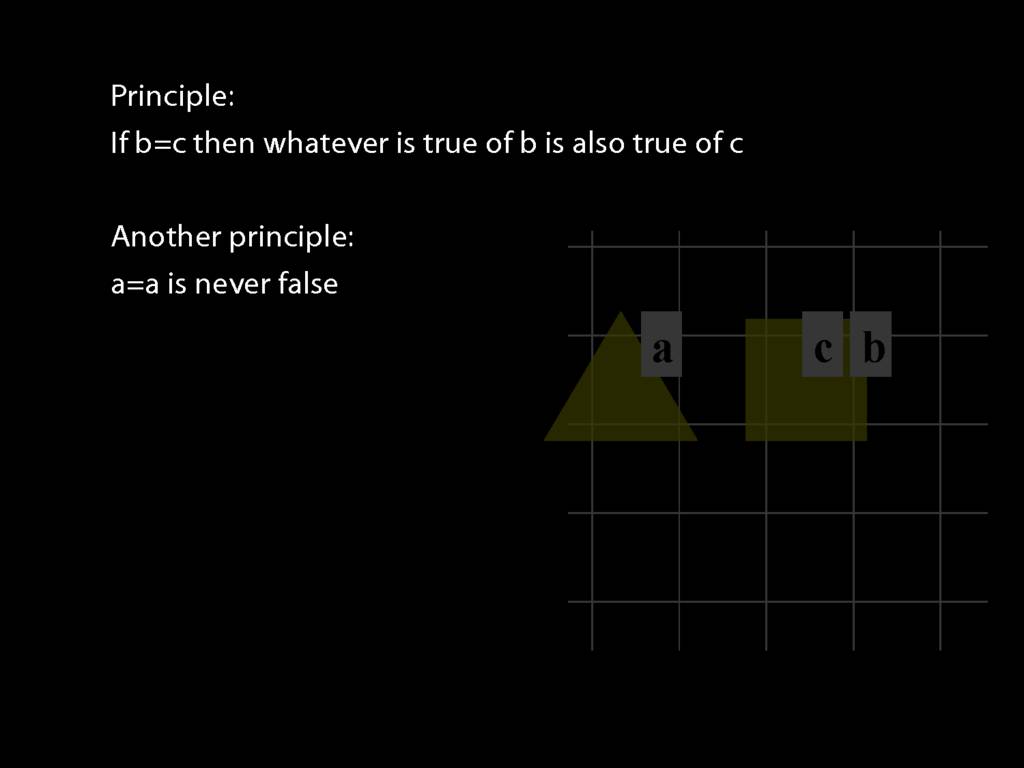
These principles are all you need to understand the logical notion of identity. They allow you to do things like prove that identity is a symmetric and transitive relation.
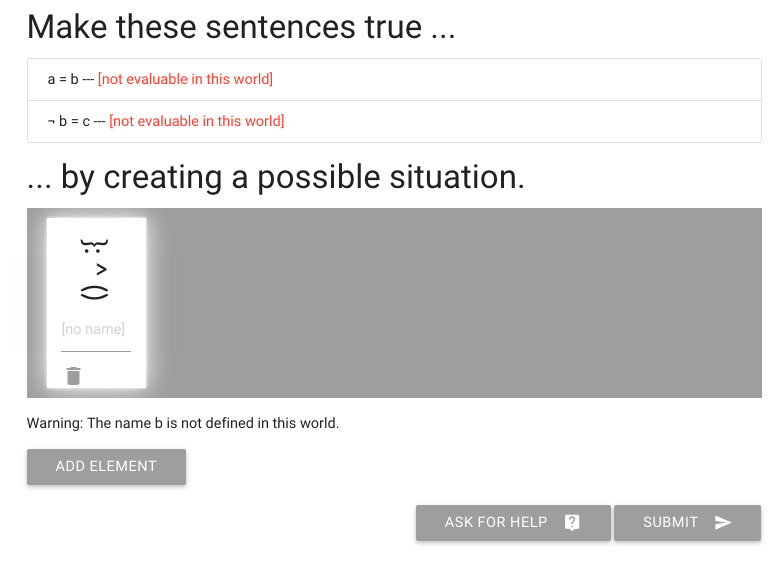
I want to show you quickly how to work with identity in logic-ex.
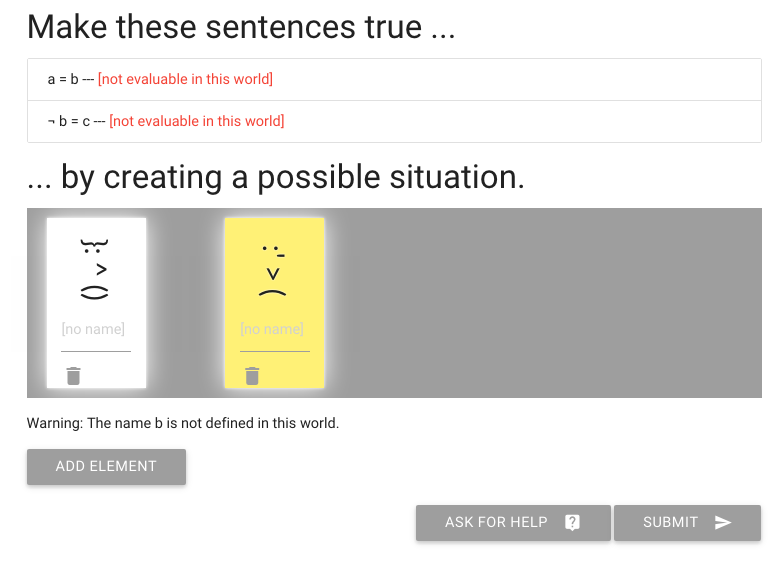
Let’s add a person to the possible situation

Here I’ve added some names
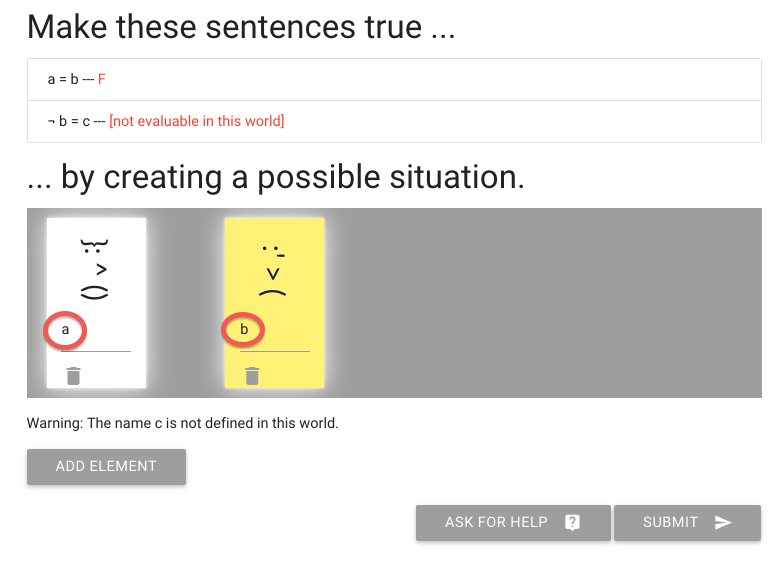
I’ve called one person ‘a’ and the other ‘b’.
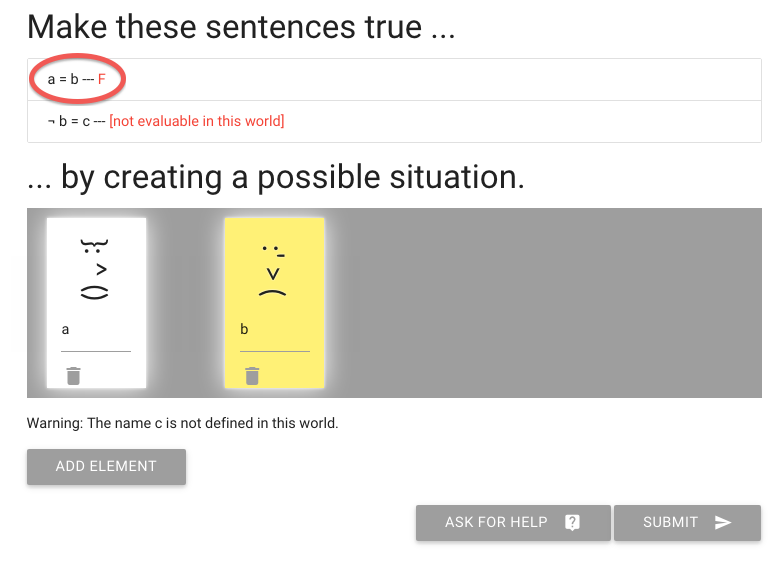
Of course this makes the first sentence false, not true.
How do I make it true?
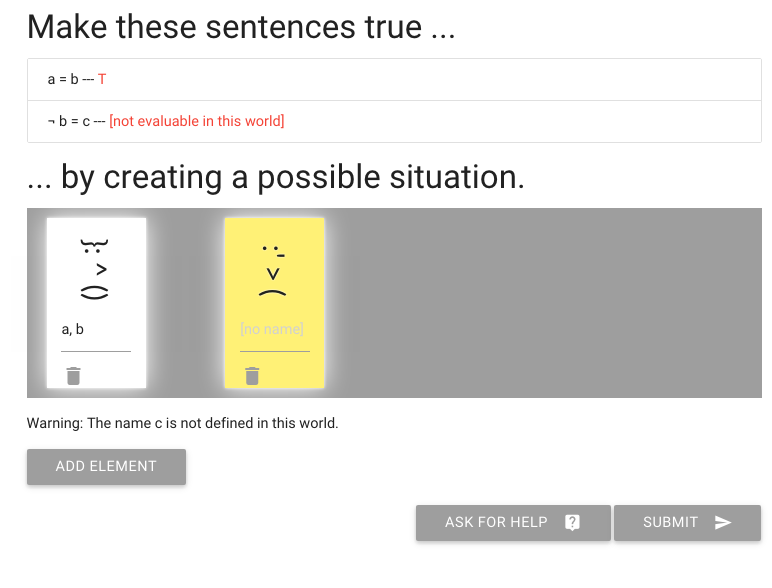
Like this ...
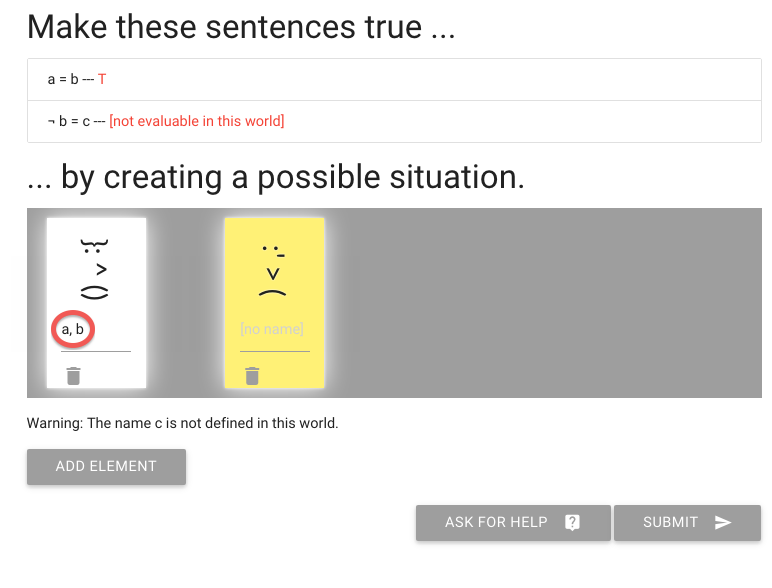
I’ve given one person both names.
To give more than one name to a person, simply type multiple names
separated by commas or spaces (or both), just as I’ve done here.
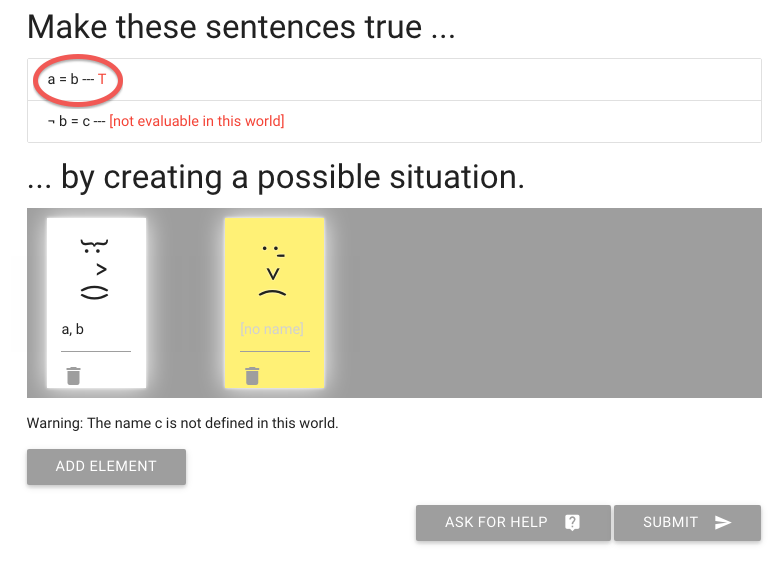
And this makes the sentence ‘a=b’ true, of course.
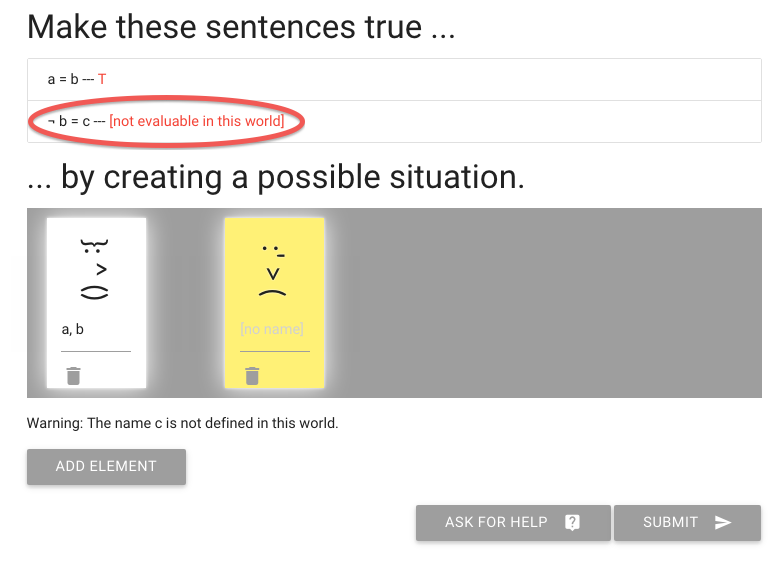
But what about the next sentence, ‘not b=c’?
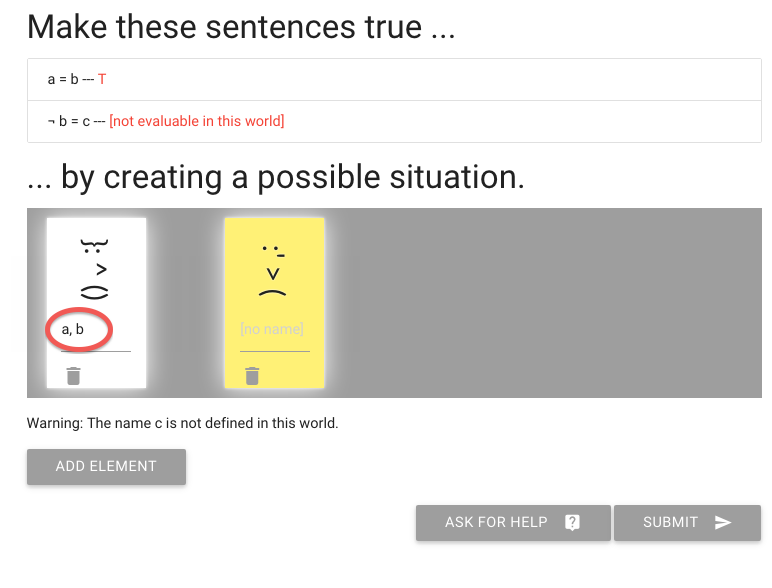
To make this true or false, I need to give someone the name c.
I’m going to add that to the person already known as ‘a’ and ‘b’.
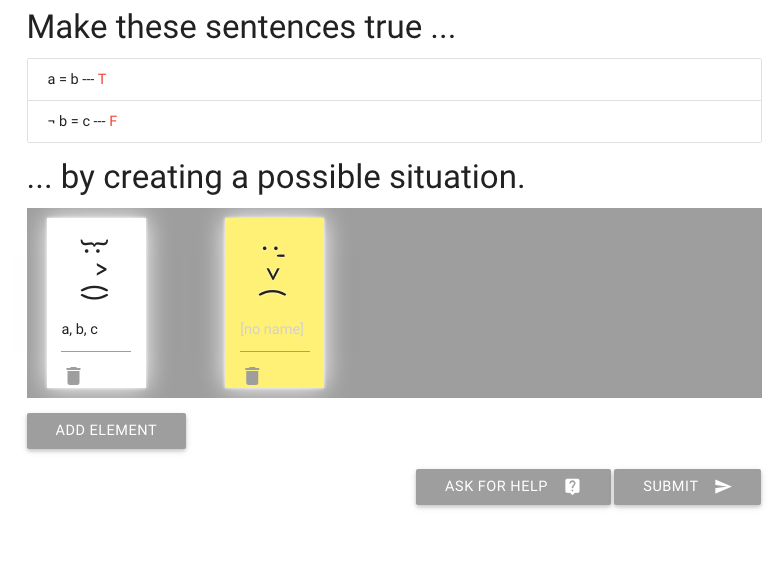

So here you see one person has all three names
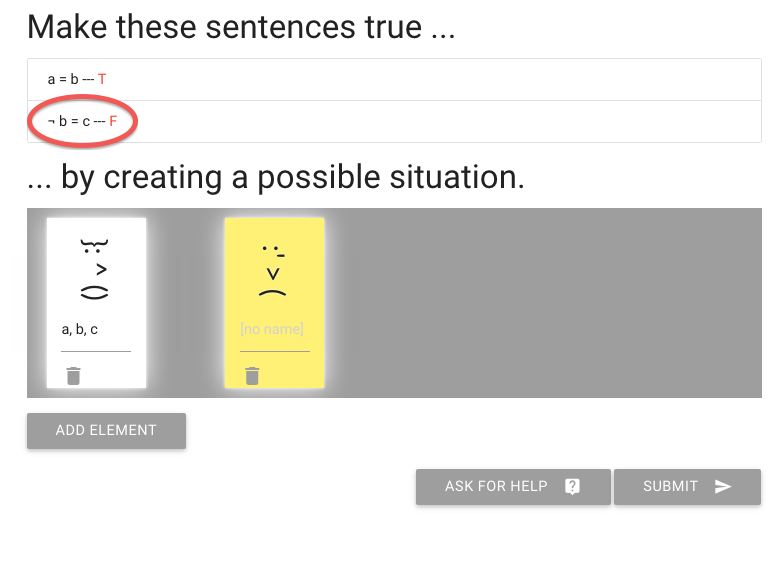
Of course this means the second sentence, ‘not b=c’ is false.
We need to make that true.
How are we going to do that?
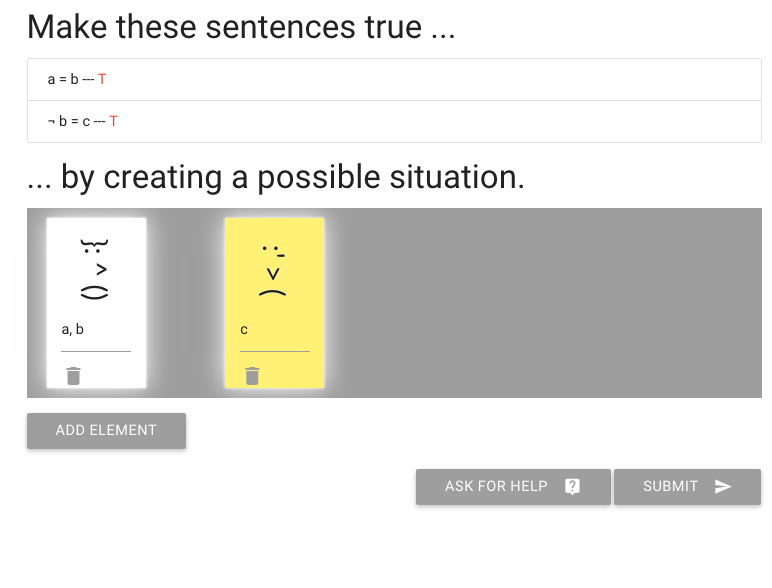
Let me re-arrange the names.
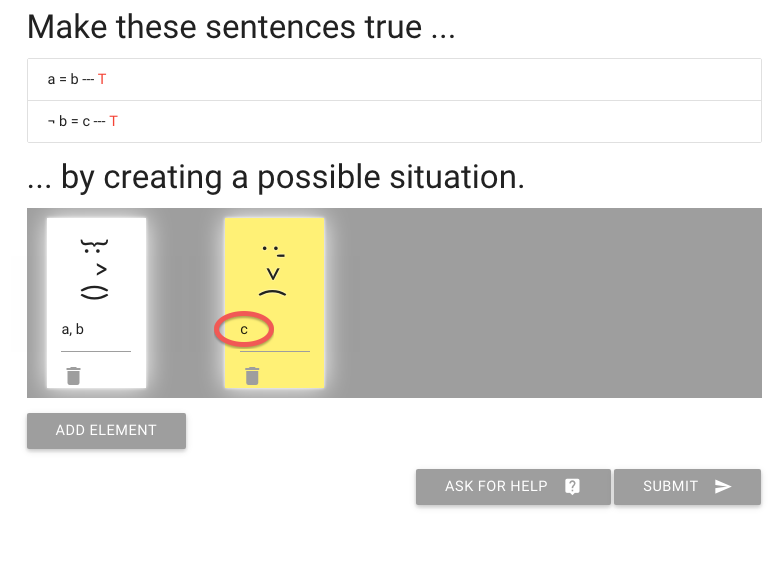
You see that I’ve named the other, yellow person c.
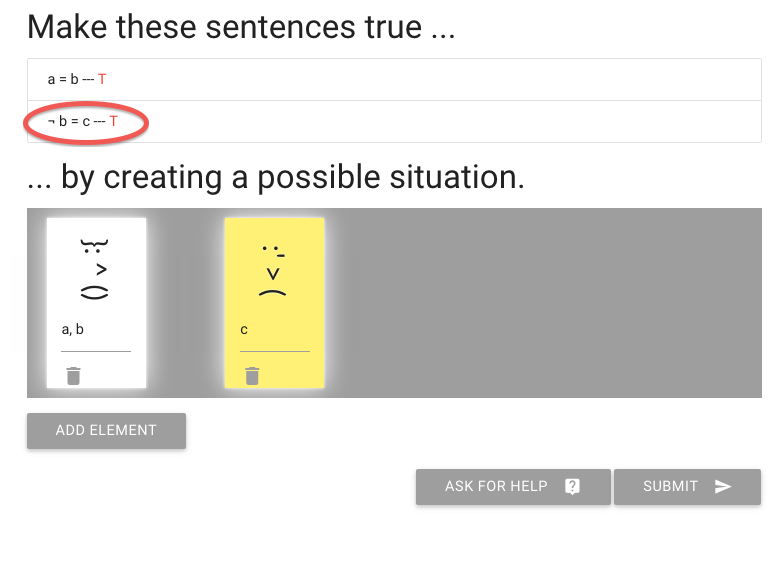
And this is enough to make the second sentence true.
2.5, 2.6

Formalizing Arguments
\section{Formalizing Arguments}

Over the vacation you and I were labouring on a farm and at one point we were herding the pigs.
Just as we almost had them secure, one of them ran off up the lane.
We closed the gate on the others and ran off behind it.
After a short sprint we came to a fork in the road.
I said, not very insightfully, either it went up the left fork or the right fork.
You said, It didnt' go up the left fork.
So we concluded that it went up the right fork and ran off after it.
Our exchange is an argument in the sense that we're interested in.
It has two premises and a conclusion.

How can we formalise this argument?
We could introduce a name for the pig and predictates for its actions.
But we don't need to introduce names and predictates.
In the case of this argument, we can formalise it just using letters for sentences.

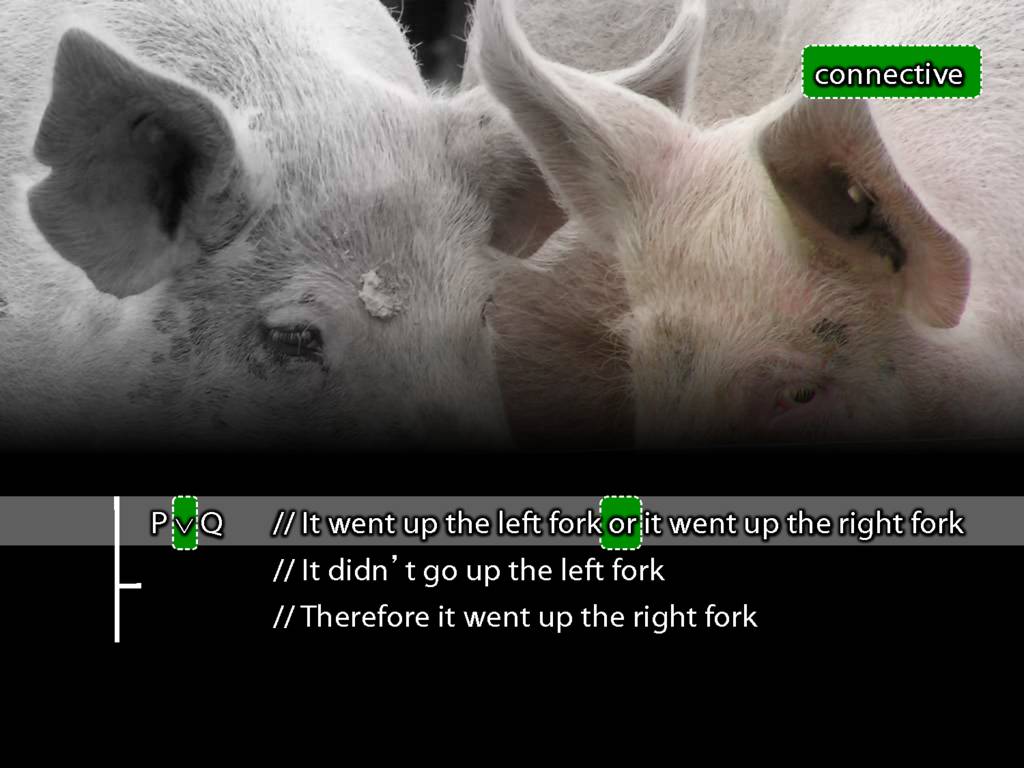
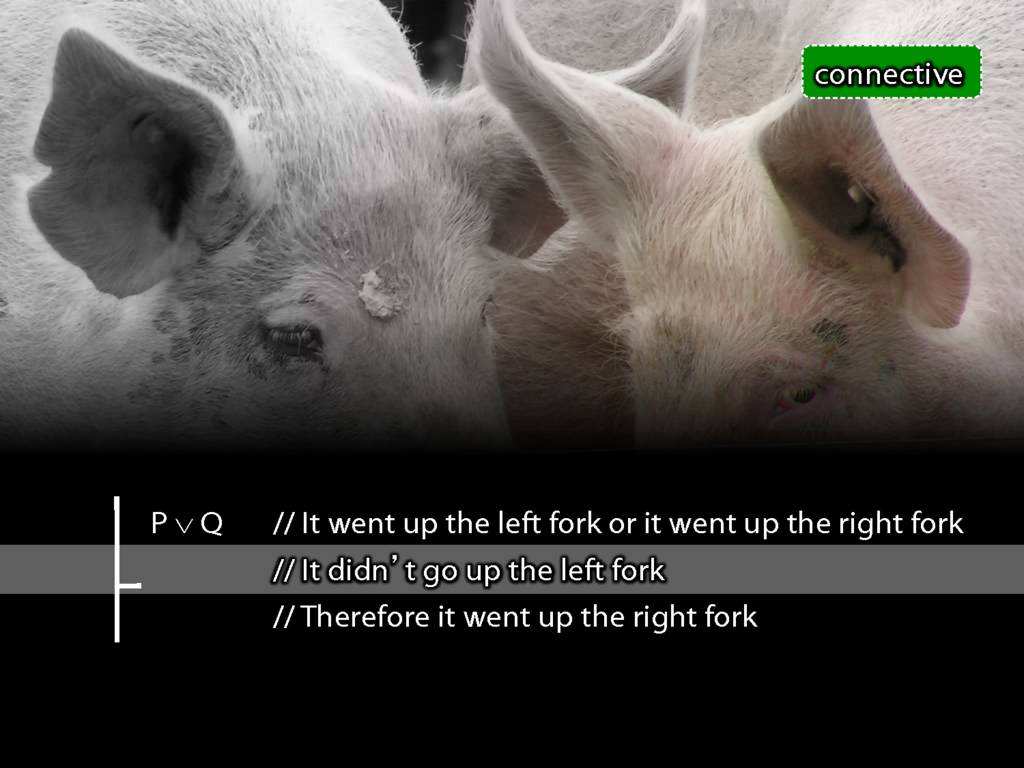
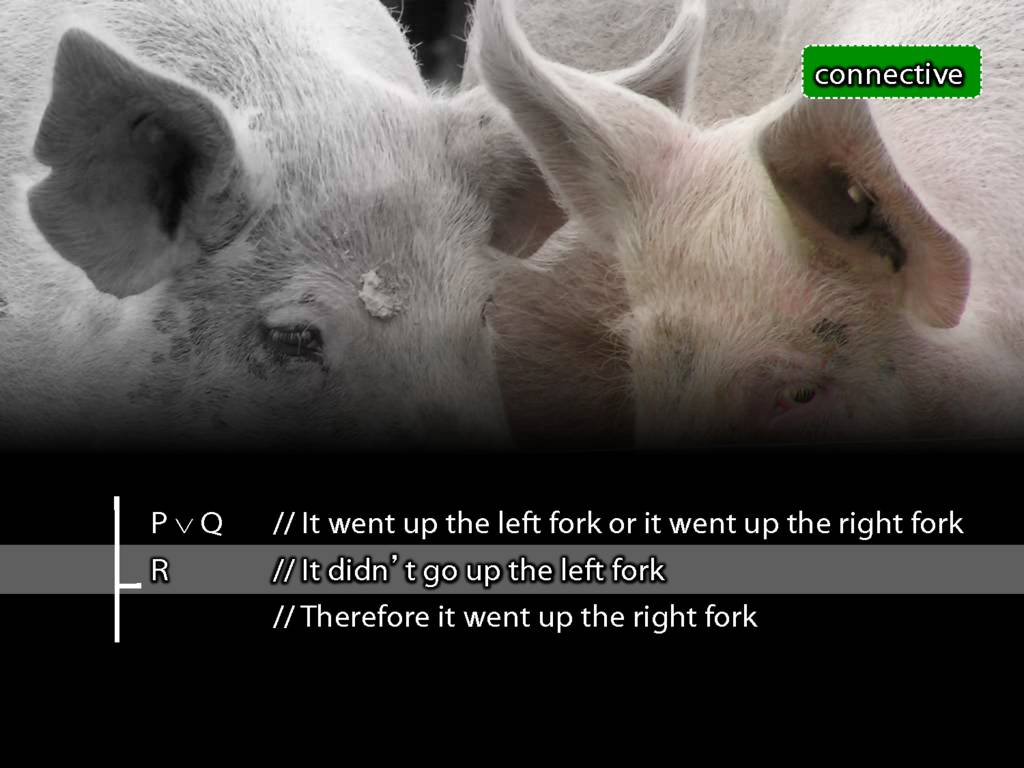
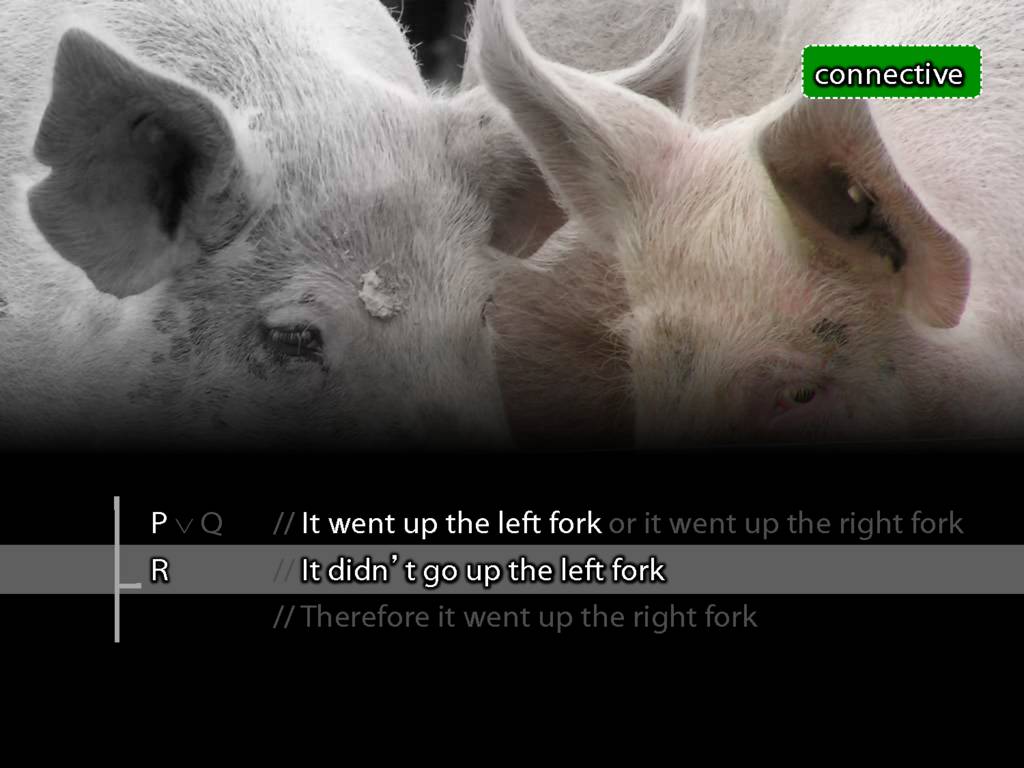
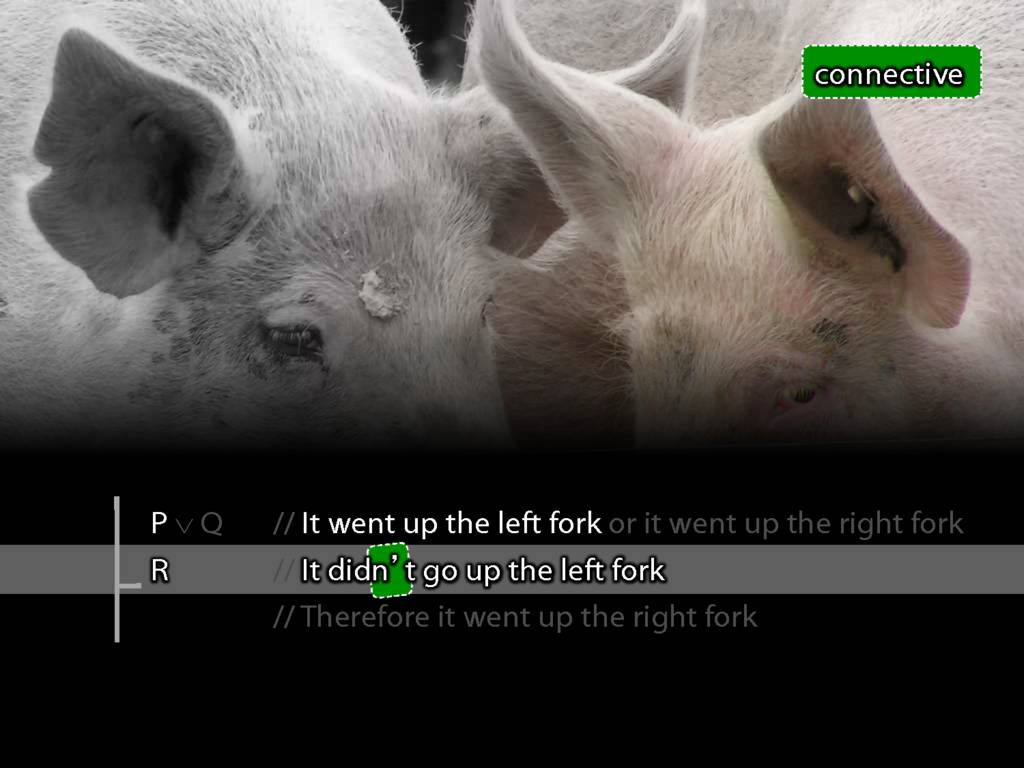
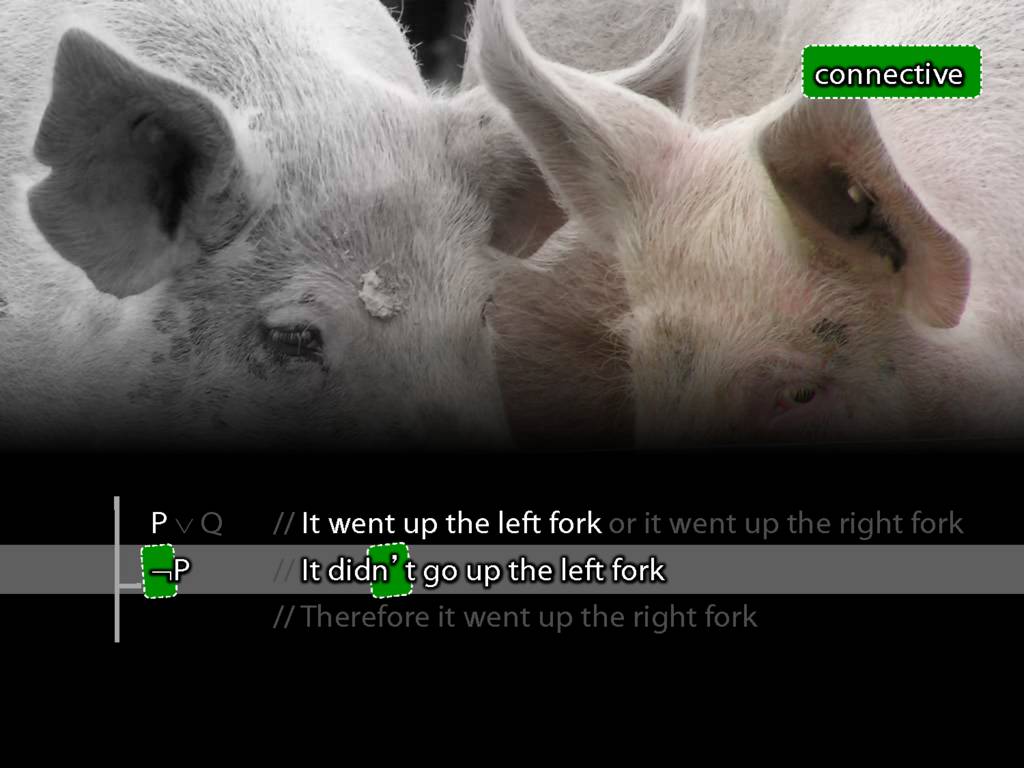
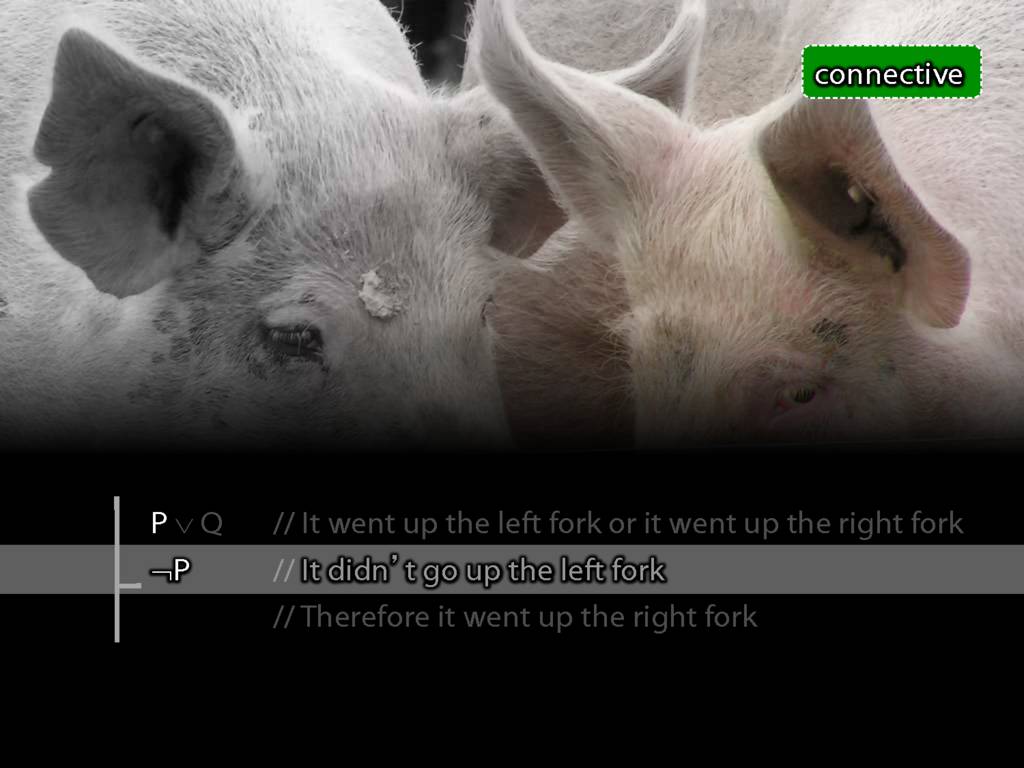
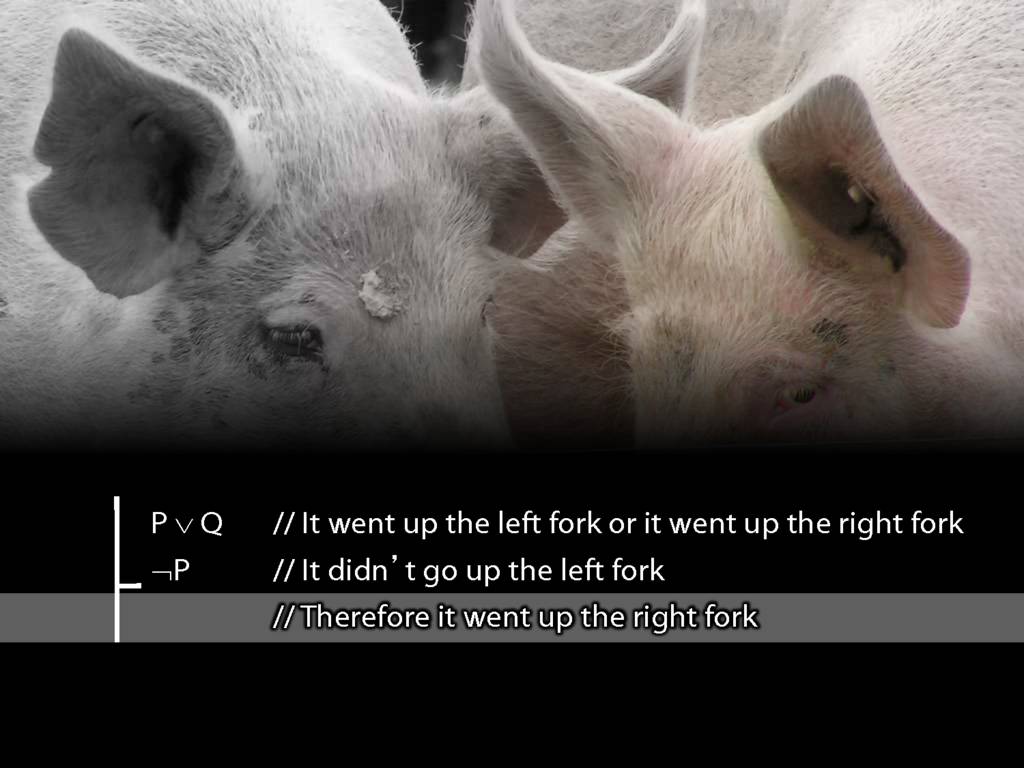
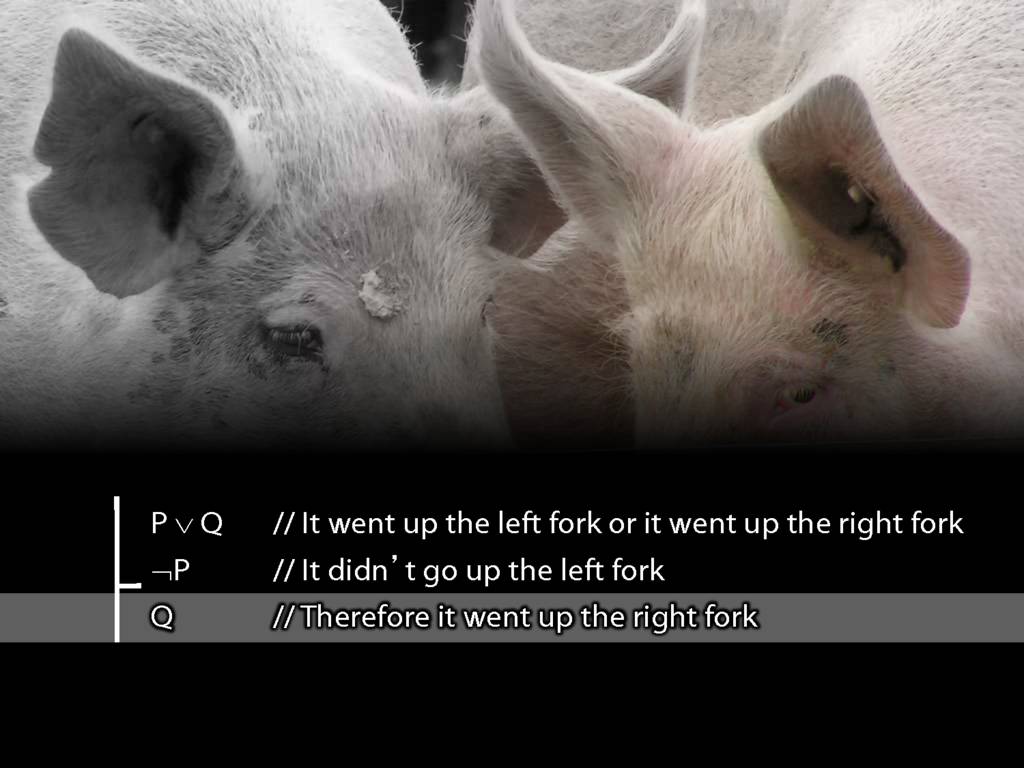
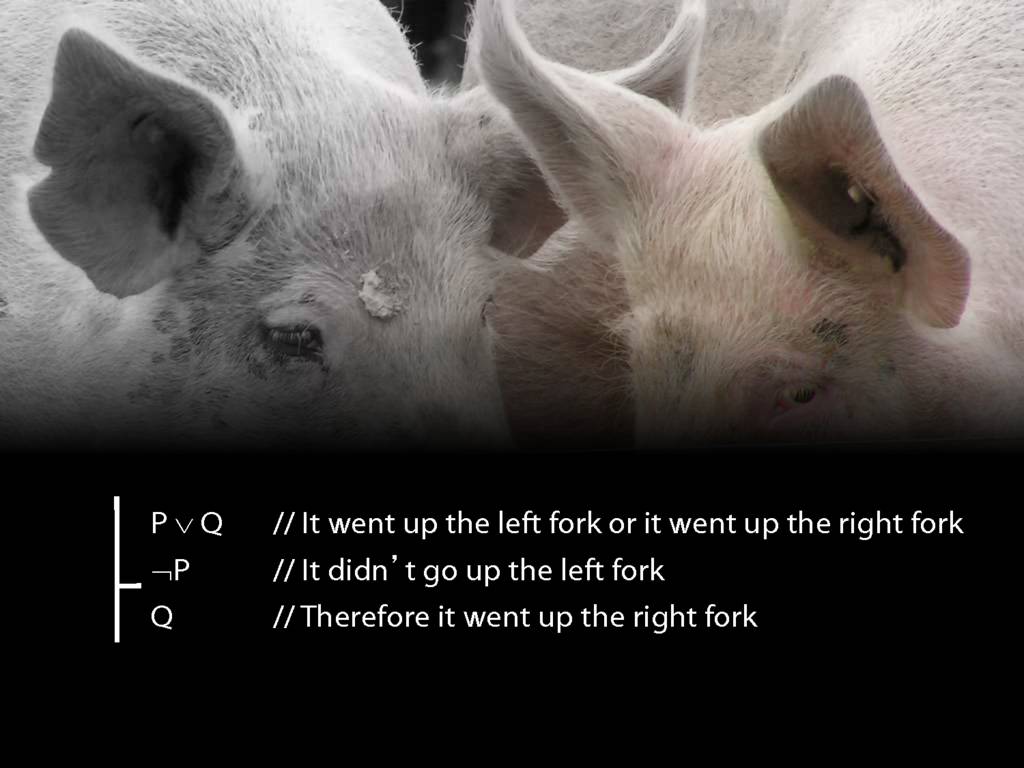

Sentence Letters
\section{Sentence Letters}
\section{Sentence Letters}

Recall this argument about Ayesha and John.

The sentence 'Square(b)' occurs twice, once as part of the first premise, and once as the conclusion.

The sentence 'Square(a)' also occurs twice, once as part of the first premise, and once in the second premise.
And there are no other sentences in this argument.
So we can represent this form of argument in a much more general way ...

... by using letters to stand for sentences instead of names and predicates.
Why is this more abstract representation useful?
We don't want to consider arguments one-by-one. We want to be able to
say things about a large number of arguments. The use of sentence letters lets us talk abou a much larger class
of arguments, all of which are valid in virtue of having this form.

But how far can we go with sentence letters?

Consider this argument. There are three atomic sentences.

So if we wanted to represent it using sentence letters only, we'd have to have three different sentence letters.
But now we have lost what is interesting about this form of argument.
After all, any argument with two premises and a conclusion has the form P, Q therefore R.
There's nothing interesting we can say about all arguments with *this* form.
So where an argument exploits identity, we can't capture what's logically interesting about its form using sentence letters.

The same is true where an argument exploits quantifiers ... this is something we'll get to later in the course.







Truth Tables
\section{Truth Tables}
\emph{Reading:} §3.1, §3.2, §3.3
\section{Truth Tables}
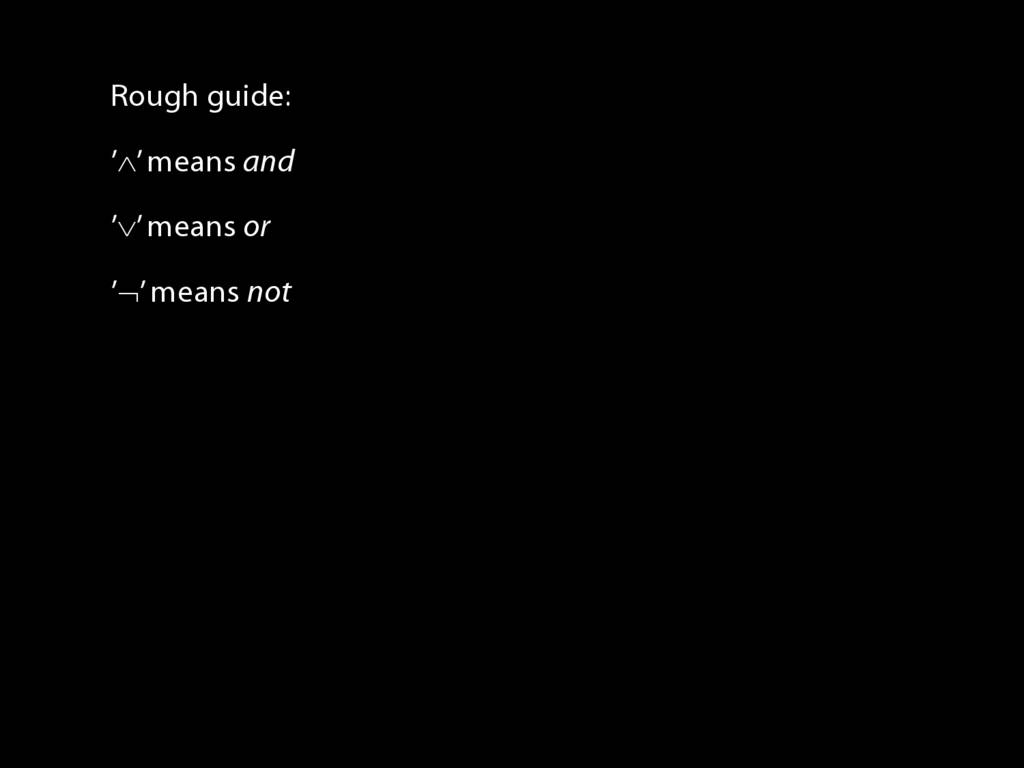
Here's a rough guide to what the connectives mean.
Rough guide:
`$\land{}$' means and
`$\lor{}$' means or
`$\lnot{}$' means not

Why do we need more than this rough guide?
Consider the sentence 'I love logic or I love chocolate'.
If I were to say this to you, and it turned out that I loved logic and chocolate both,
you might think I had mislead you by saying 'or'. And that might lead you to think
that the English sentence is false, and that 'or' sentences are false when the two sentences
they conjoin are both true. That is, the English 'or' is exclusive.
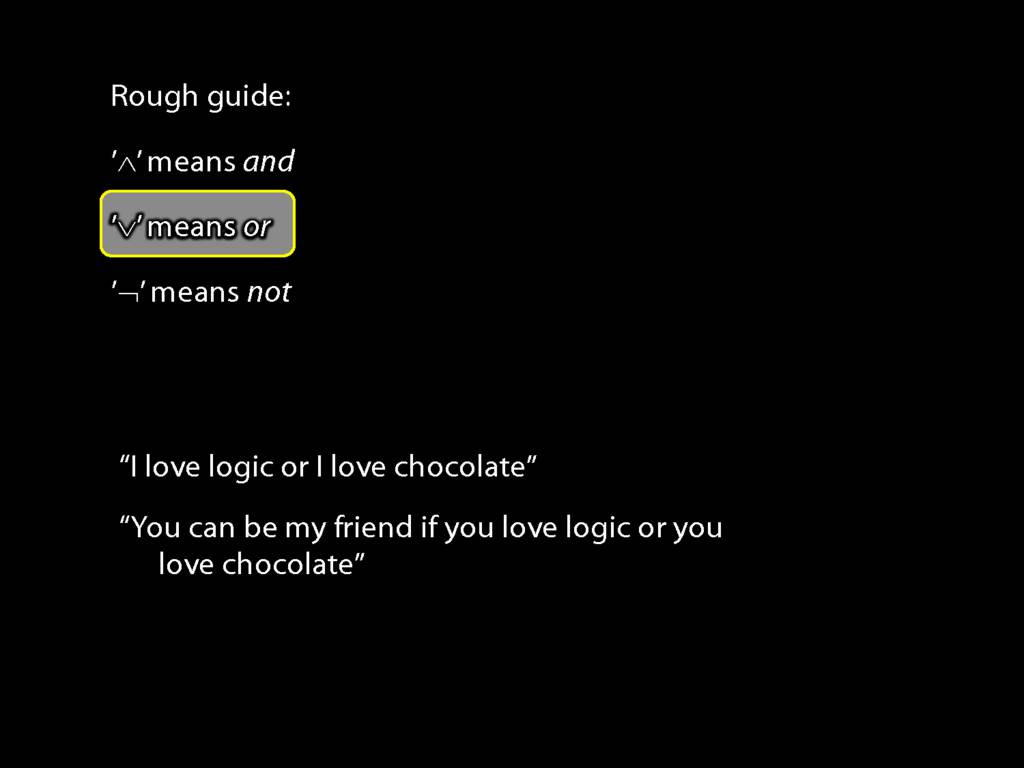
But now consider a different example. You say to me, 'You can be my friend if you love logic or chocolate'.
Then, as before, it turns out that I love both.
In this situation you're not going to deny me friendship. You're not going to say I haven't meet the criterion you specified.
No, if I love both then I'm doubly your friend.
This tells us that an English sentence involving 'or' is true when the two sentences
conjoined are both true. That is, the English 'or' is inclusive.
But now we seems to have contradictory urges. One case urges us to say that the English 'or' is exclusive
(false when the things conjoined are both true), the other case urges us to say the opposite.
Now the truth is probably that the English 'or' is neither inclusive nor exclusive but much more complex still.
The point of introducing a formal language is to avoid all this complexity.
Not because there's anything wrong with the English 'or'--on the contrary, it's complexity is a wonderful thing for communication.
But our concern is not communication but logic.
Now if we define our symbols just by invoking the meanings of English words, we won't succeed in avoiding the complexity of
natural languages like English. We will have merely replaced one sign with another.
This is why we need more than the rough guide
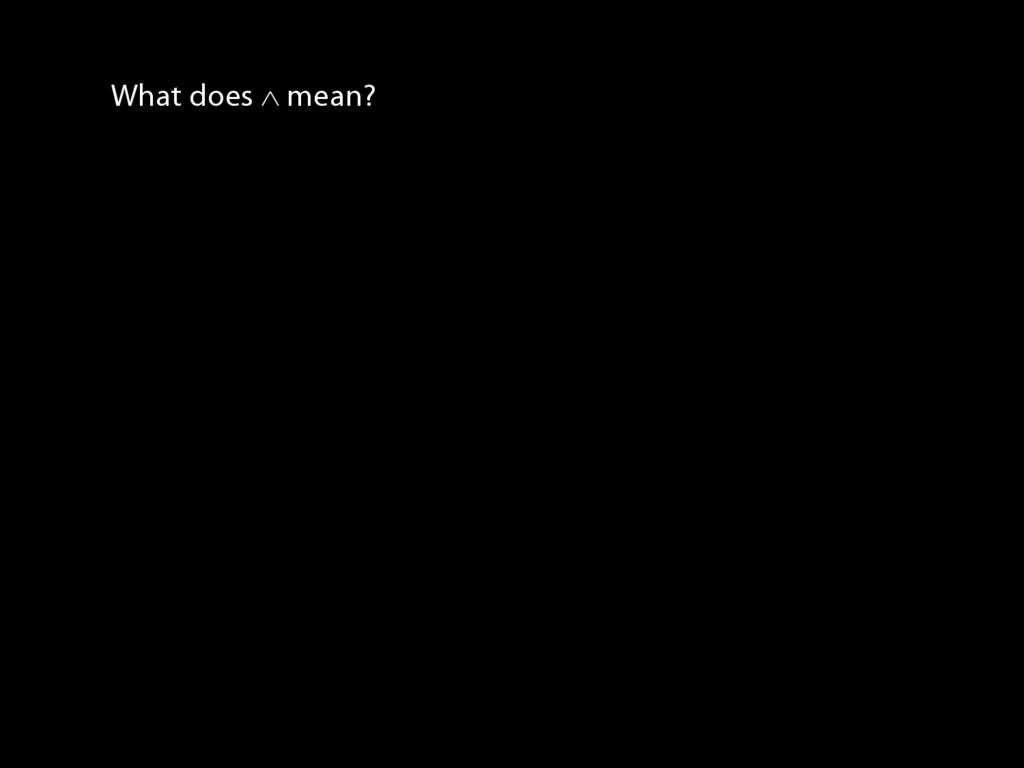
So what does a symbol like ∧ mean?
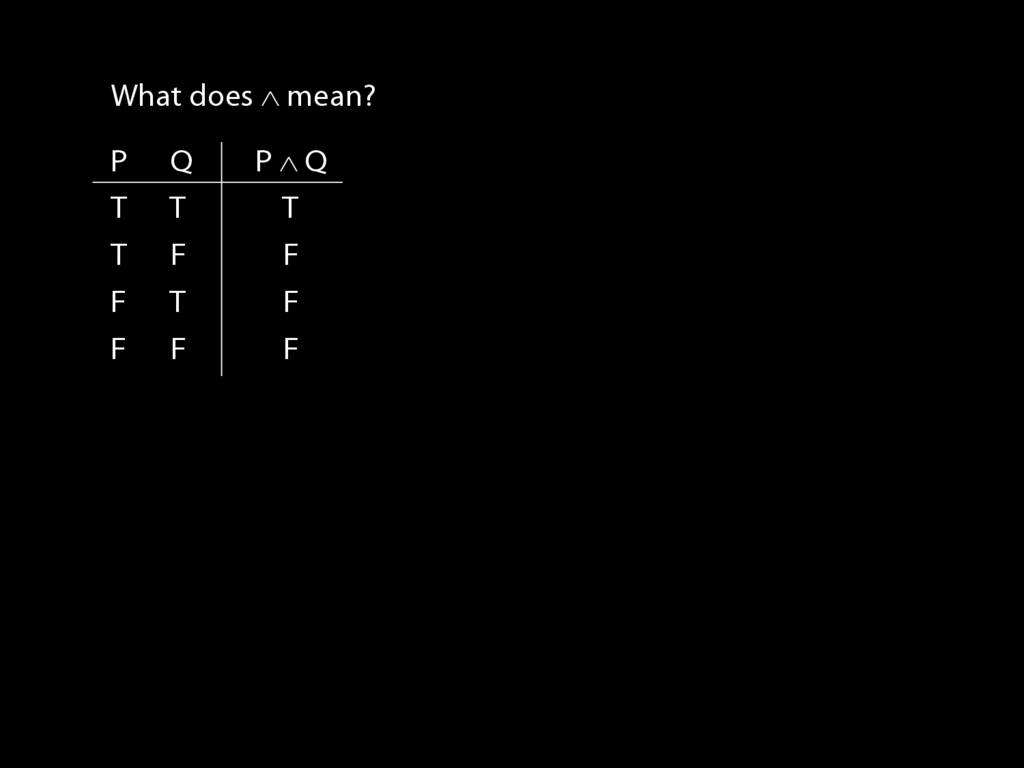
The answer is given by a truth table.
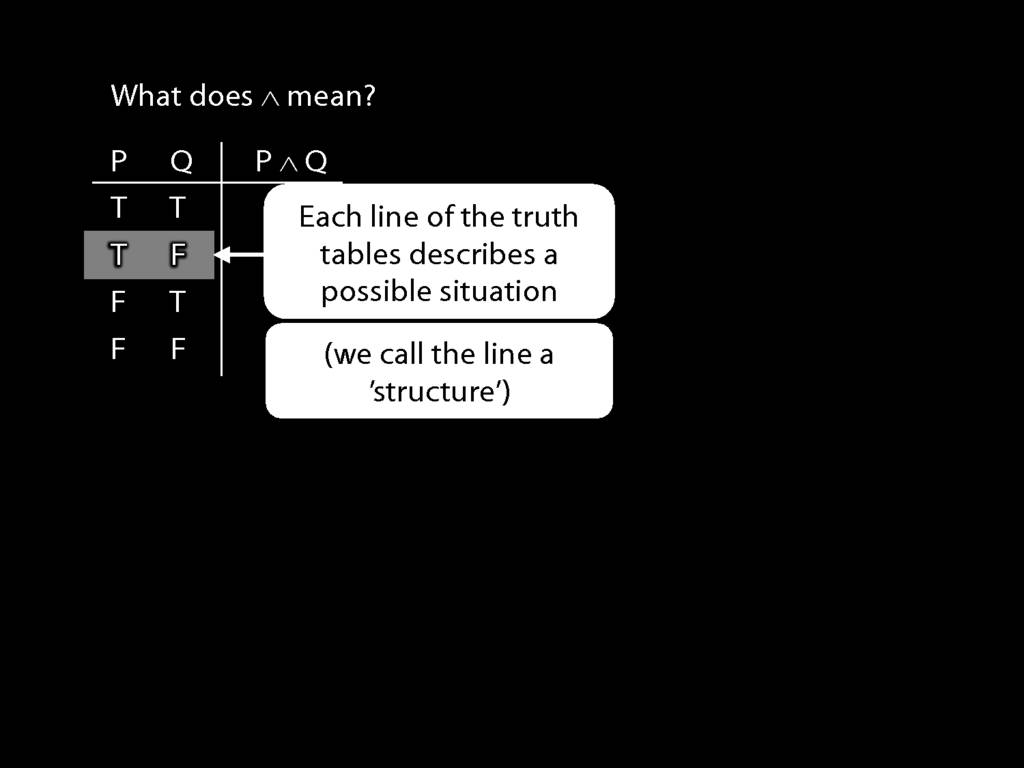
Each line of the truth table describes a possible situation.
For instance, this line of the truth-table describes the situation where P is true and Q false.
(Strictly speaking, this is not a possible situation but a whole class of possible situations.)
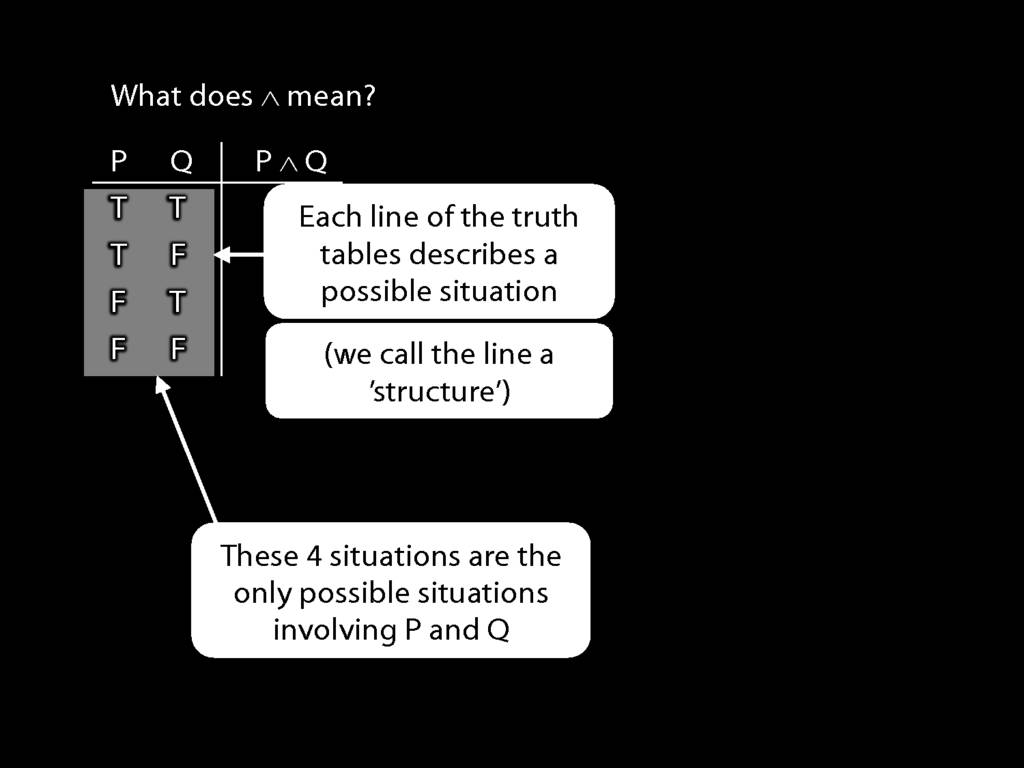
Insofar as we are interested in sentences involving sentence-letters and certain connectives,
we need only distinguish possible situations in which the sentence-letters of interest have different truth values.
This means that if we are concerned with two sentence letters, there are only four kinds of possible situation that we
need to consider.
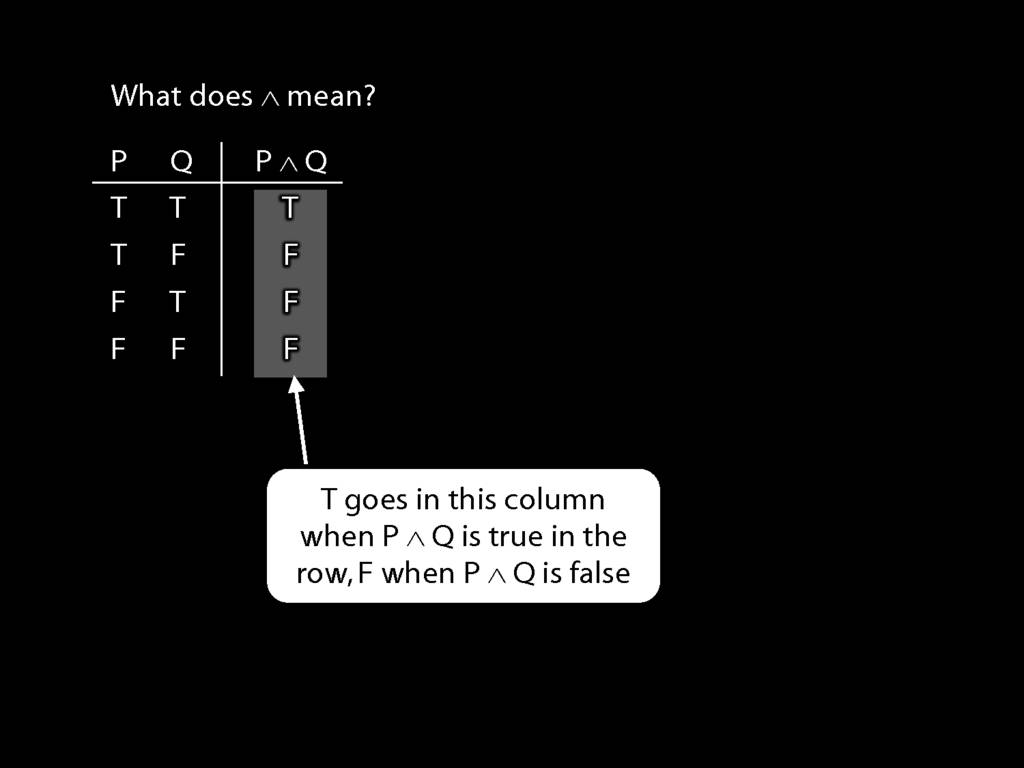
The Ts and Fs in this column tell us whether the sentence is true or false.
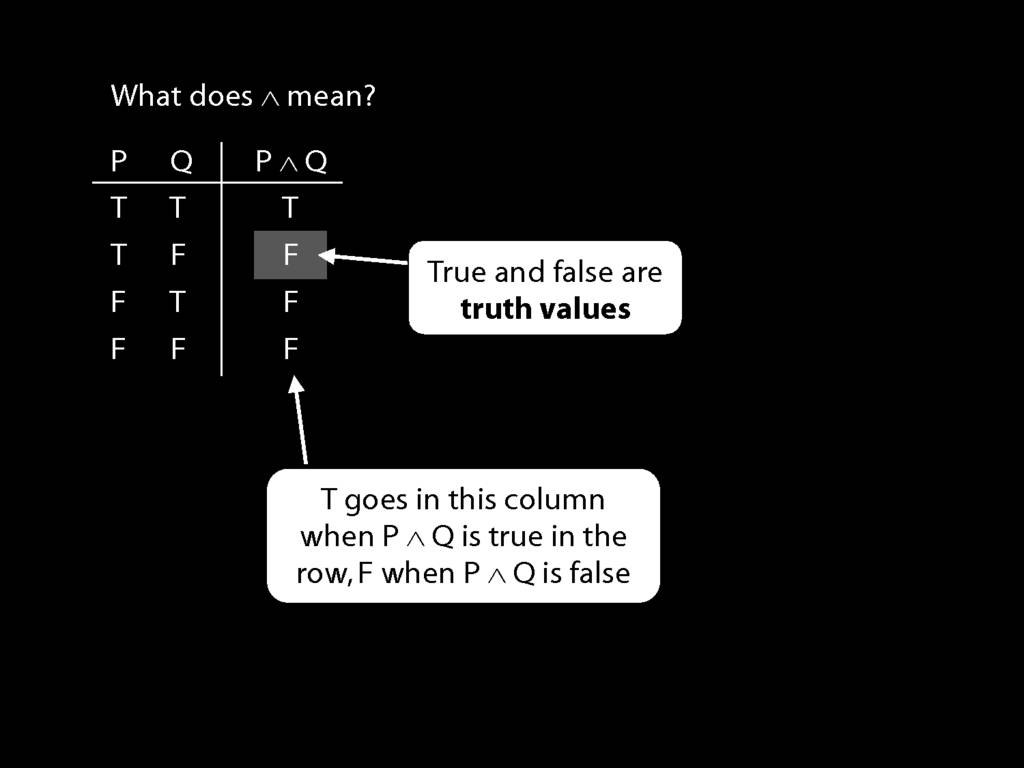
So, for example, we are told that P∧Q is false when P is true and Q false.
These true and false are called truth-values.
To illustrate, suppose I ask you, What is the truth-value of P∧Q in this row (the second row)? What would you say?
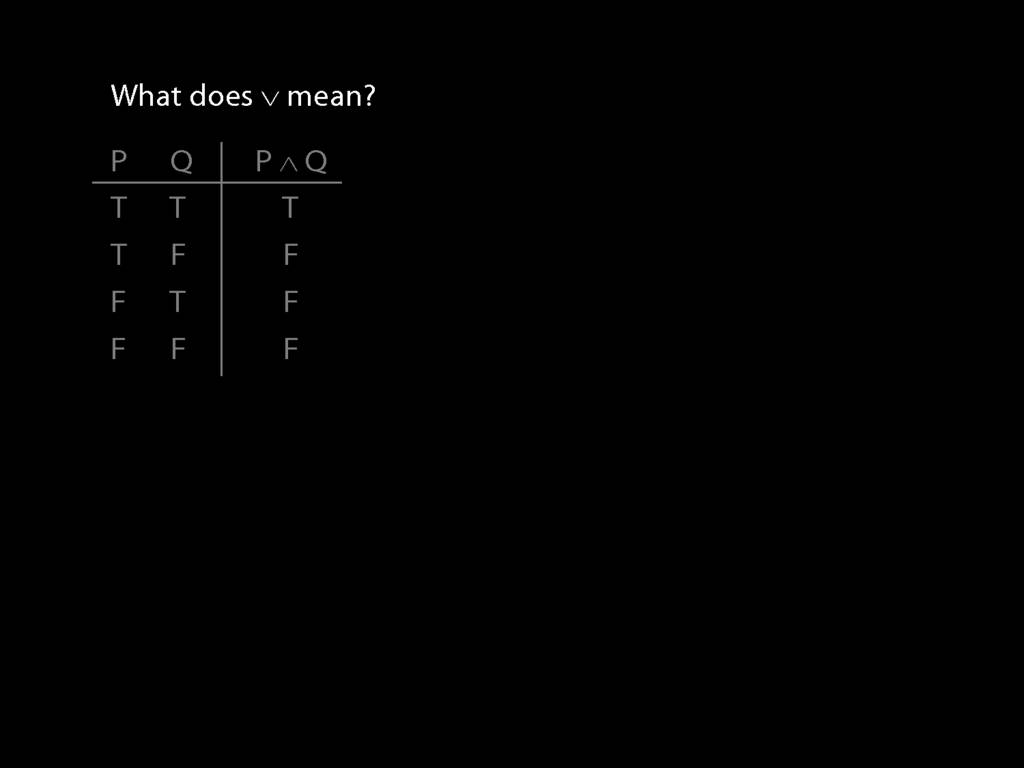
What does ∨ mean?

The answer is given by another truth table.

Let's return to the English sentence about loving chocolate or logic.
Imagine that instead of 'or' we had the logical symbol for disjunction, ∨.

Then 'I love logic' is P, and ...

... 'I love chocolate' is Q.

Now what happens if they are both true?

The truth-table tells us that their disjunction is also true.
So specifying meanings by invoking truth-tables means we don't have to worry about
the complexities of natural languages like English.
Note that the truth-tables are stipulations.
You can't argue that it is wrong to put a T in the first row of this truth-table.
The truth-table is a stipulation about the meanings of the symbol.
The point of a formal language is that it is a thing of our creation.
We are free to make whatever stipulations we like about it.
By contrast, we can't make stipulations about a natural language like English,
because natural languages have lives of their own.
In the case of natural language, meaning has to be discovered, not stipulated.

Finally, what do we say about the meaning of our symbol for negation, ¬?
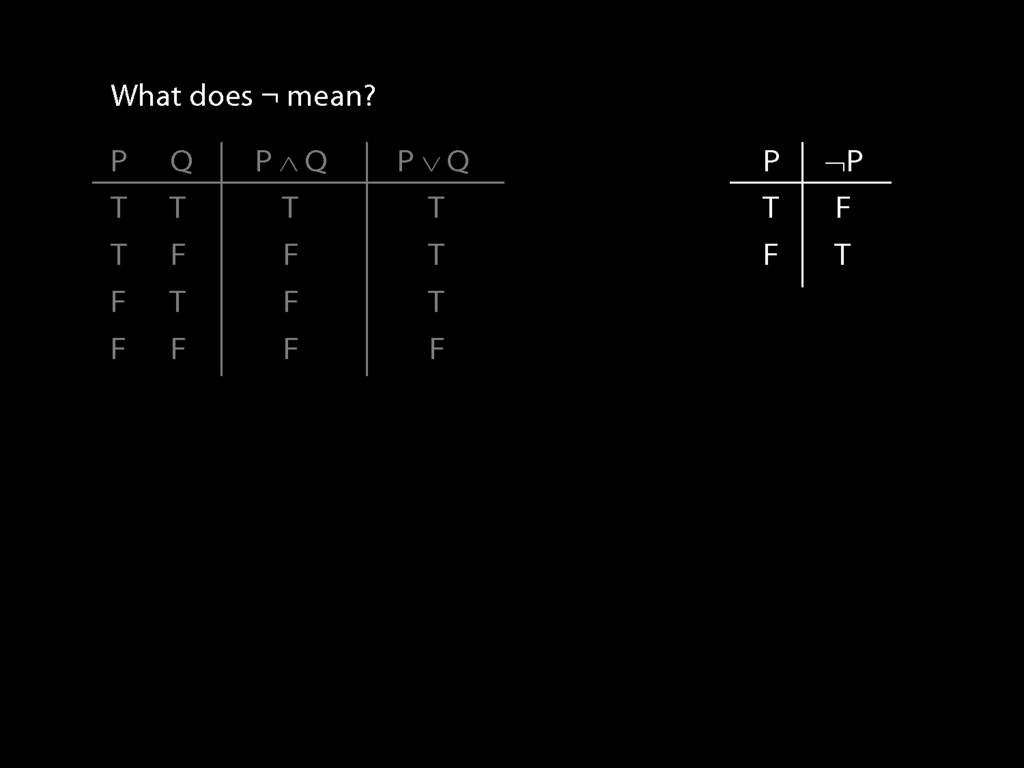
The truth-table specifying its meaning is very simple; it takes true to false and false to true.
3.1, 3.2
3.5, 3.7
3.1, 3.3
3.5, 3.7

Complex Truth Tables
\section{Complex Truth Tables}
\section{Complex Truth Tables}
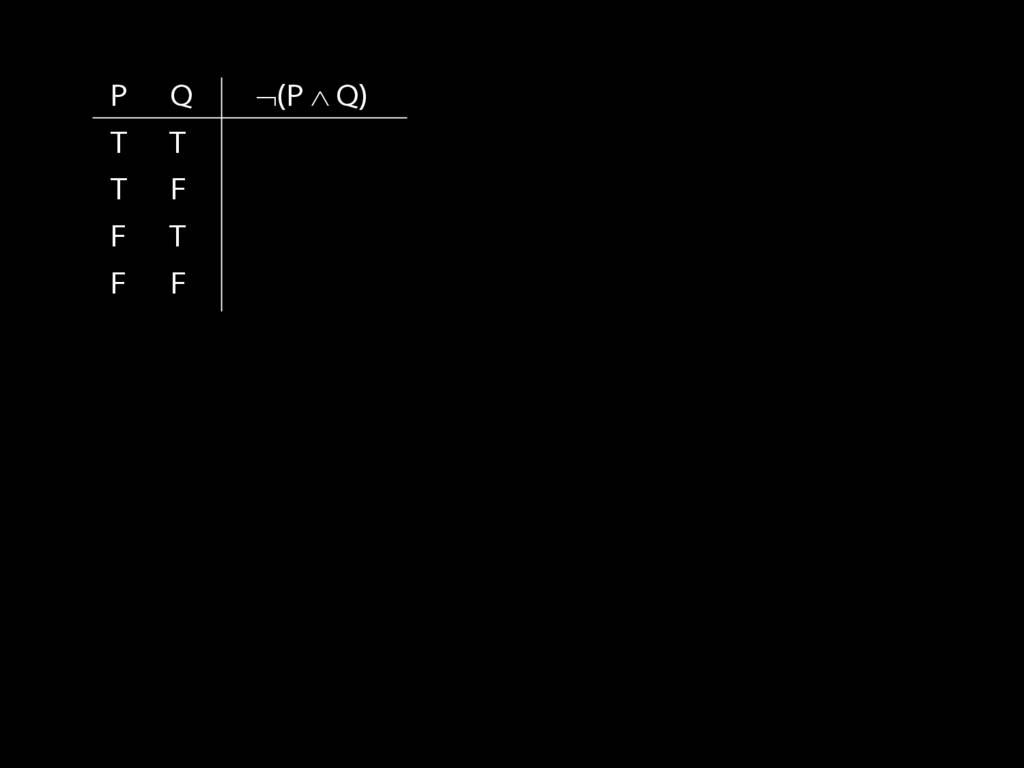
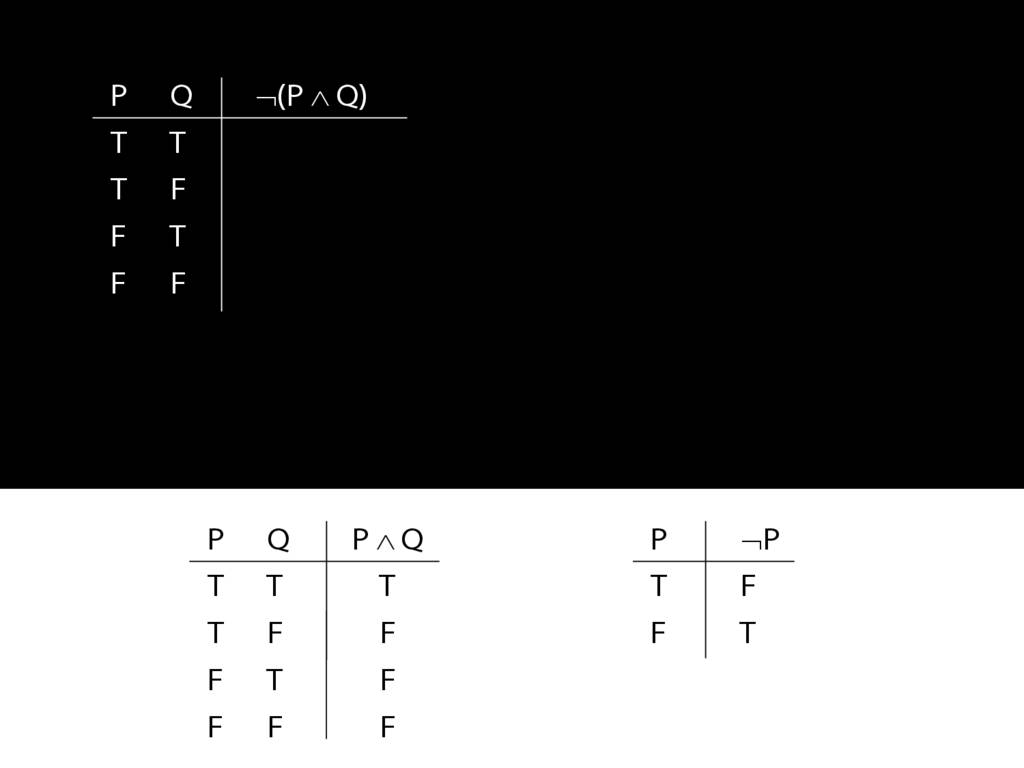
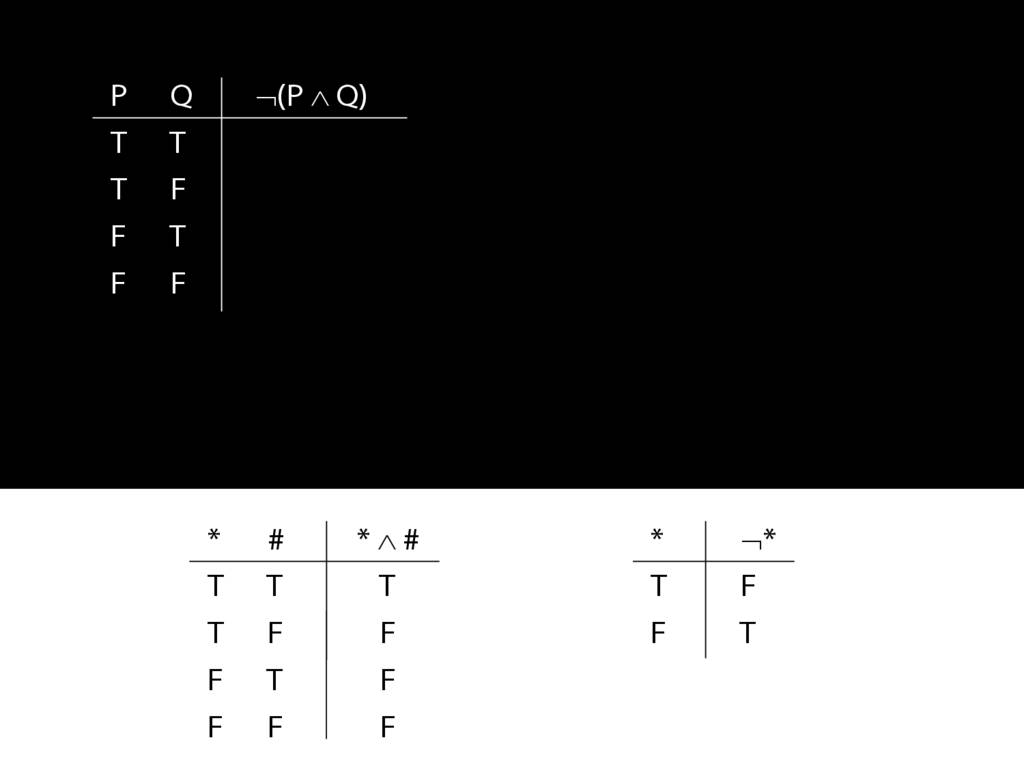
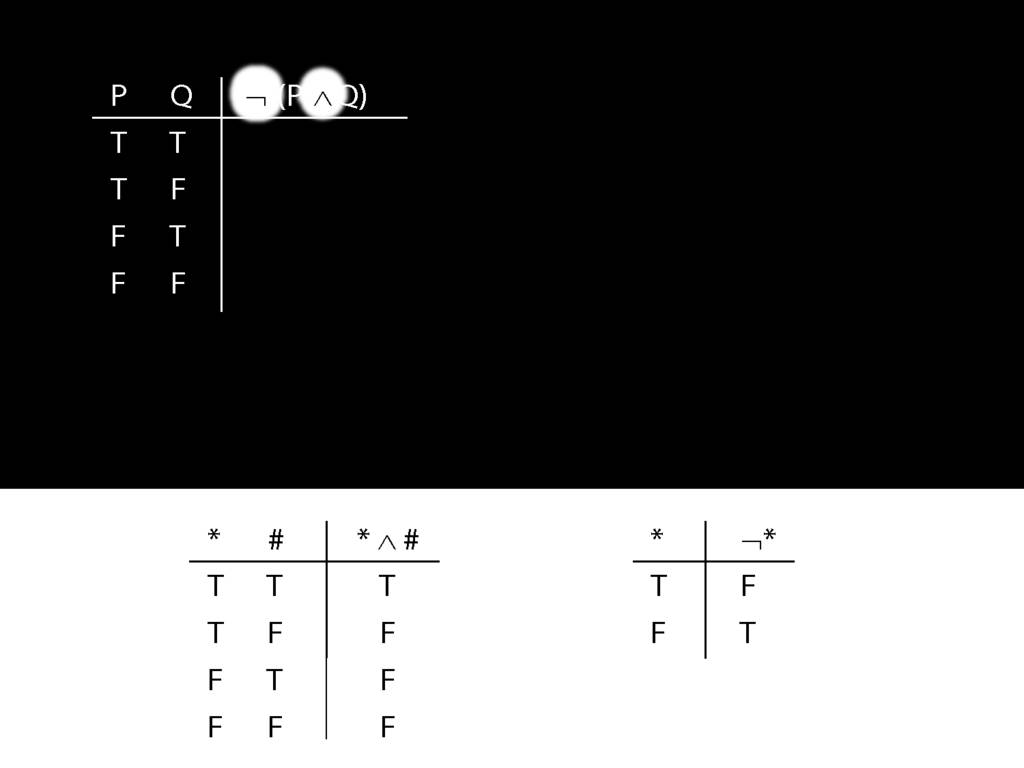
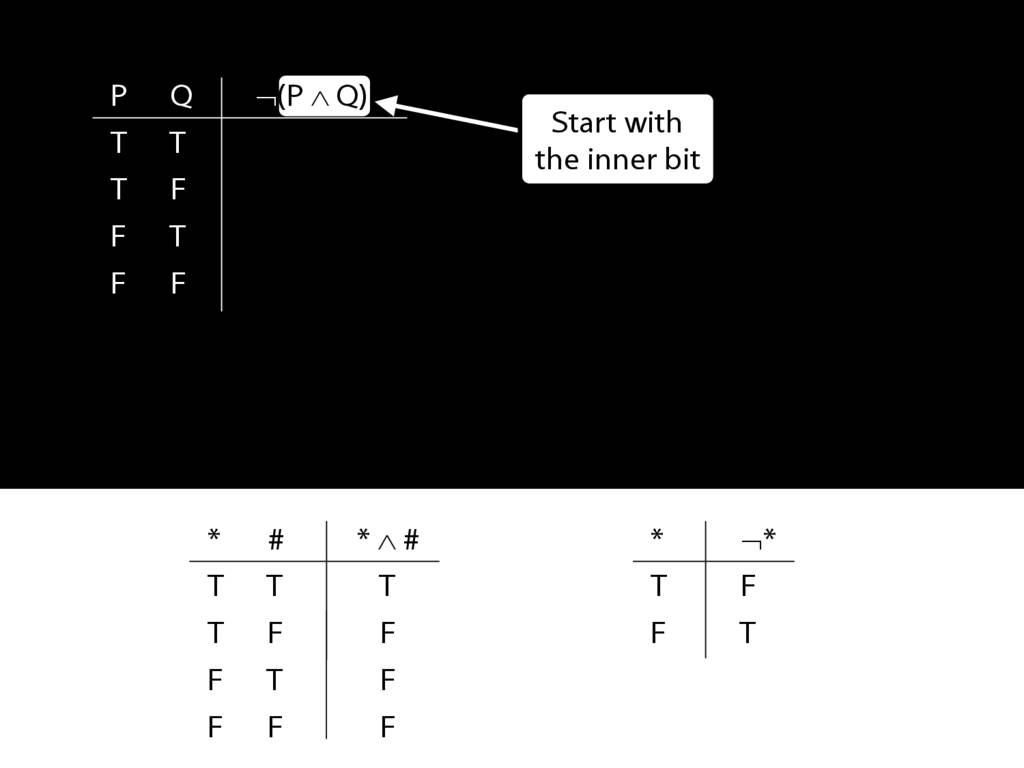
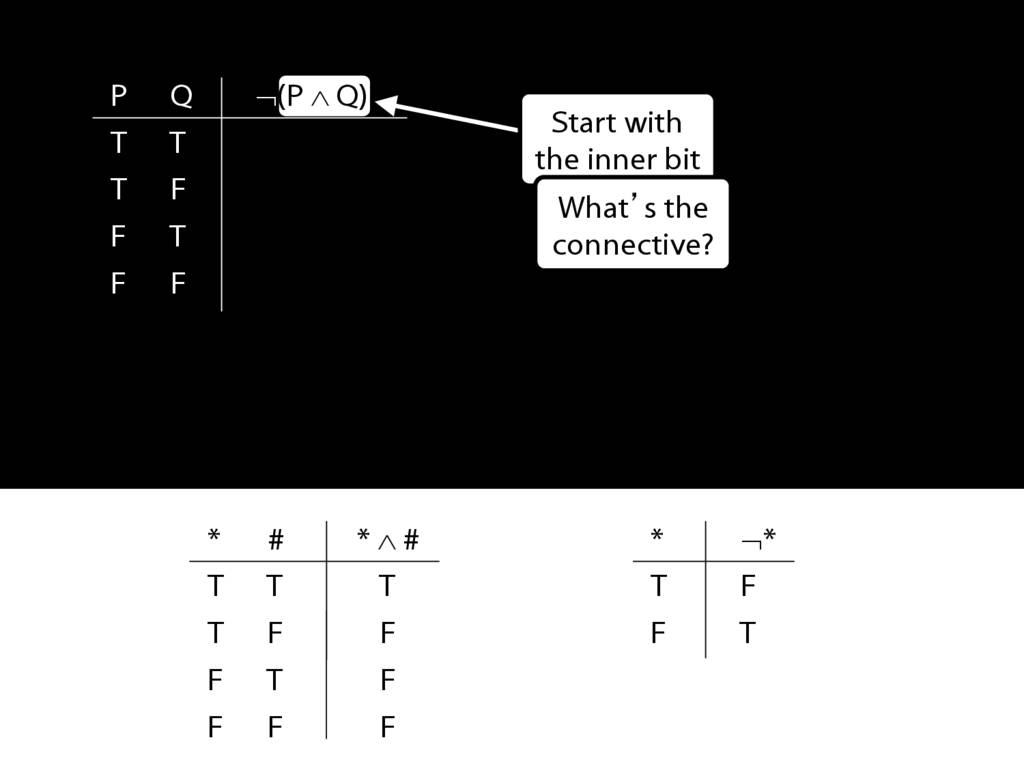
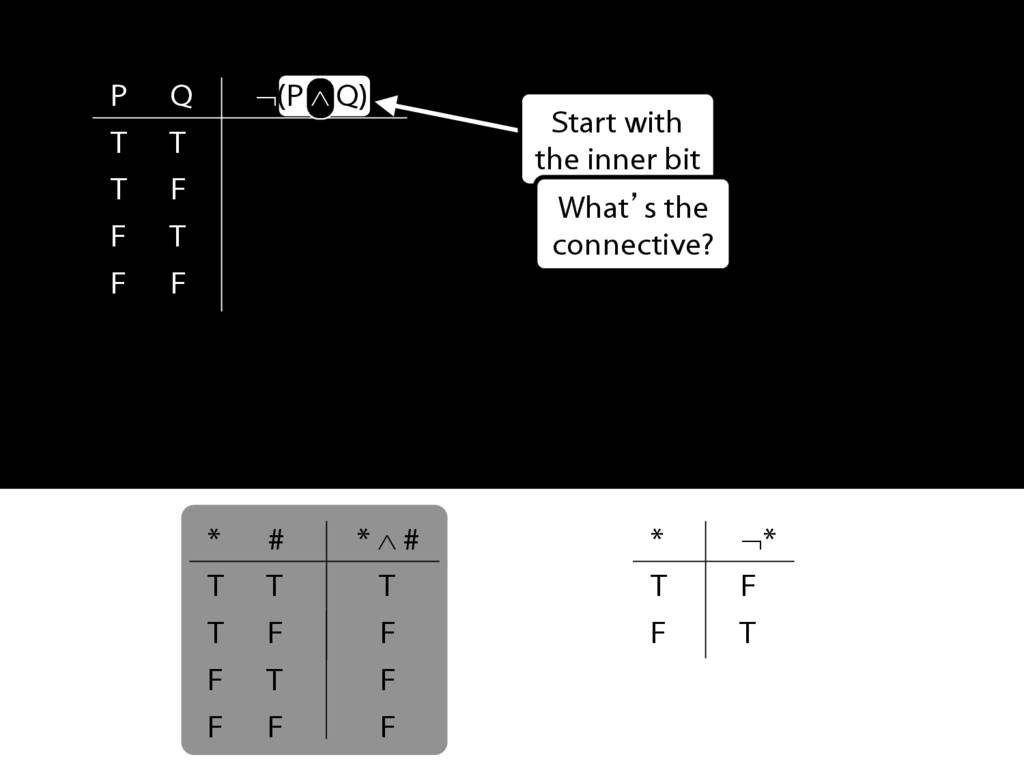
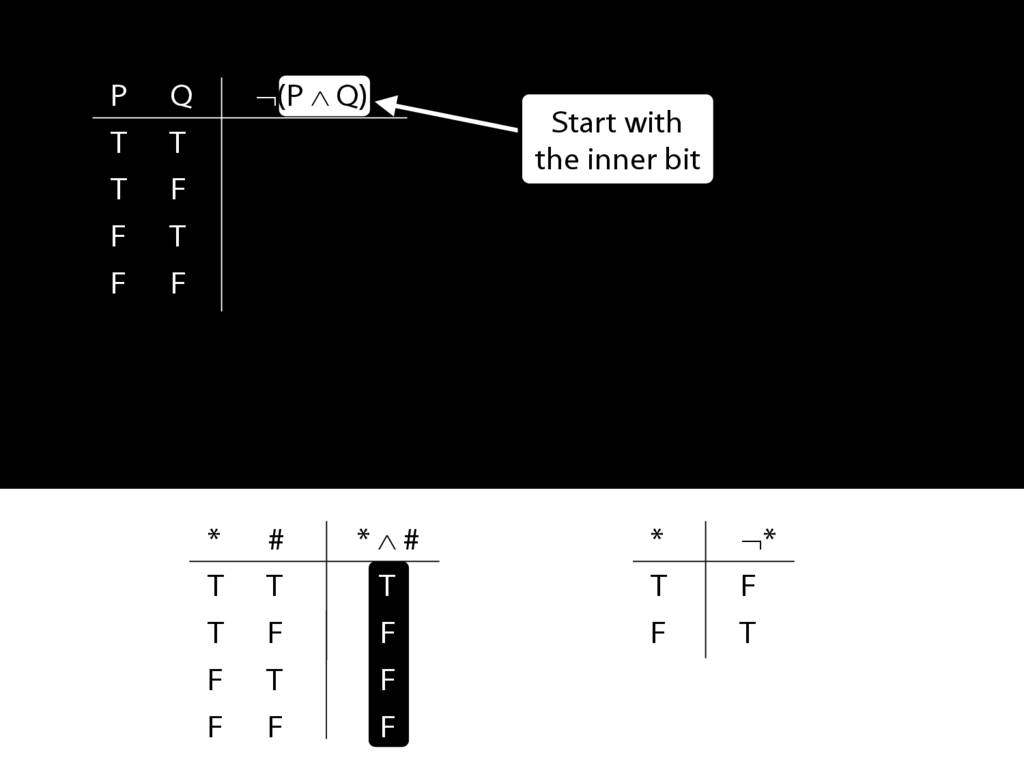

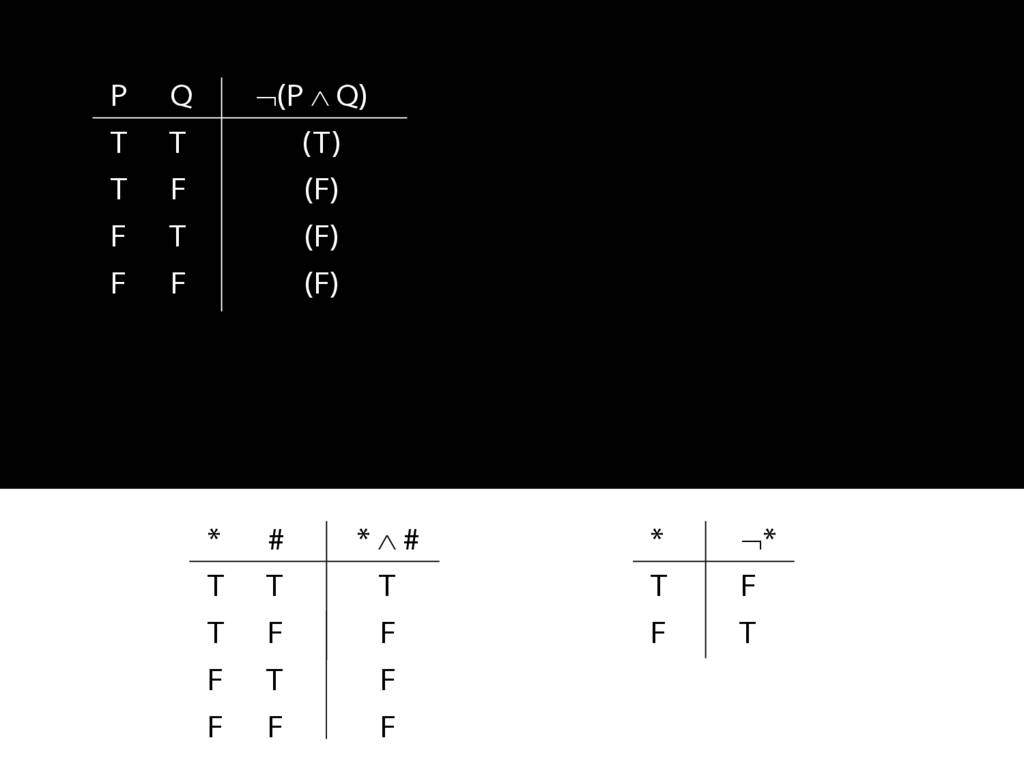
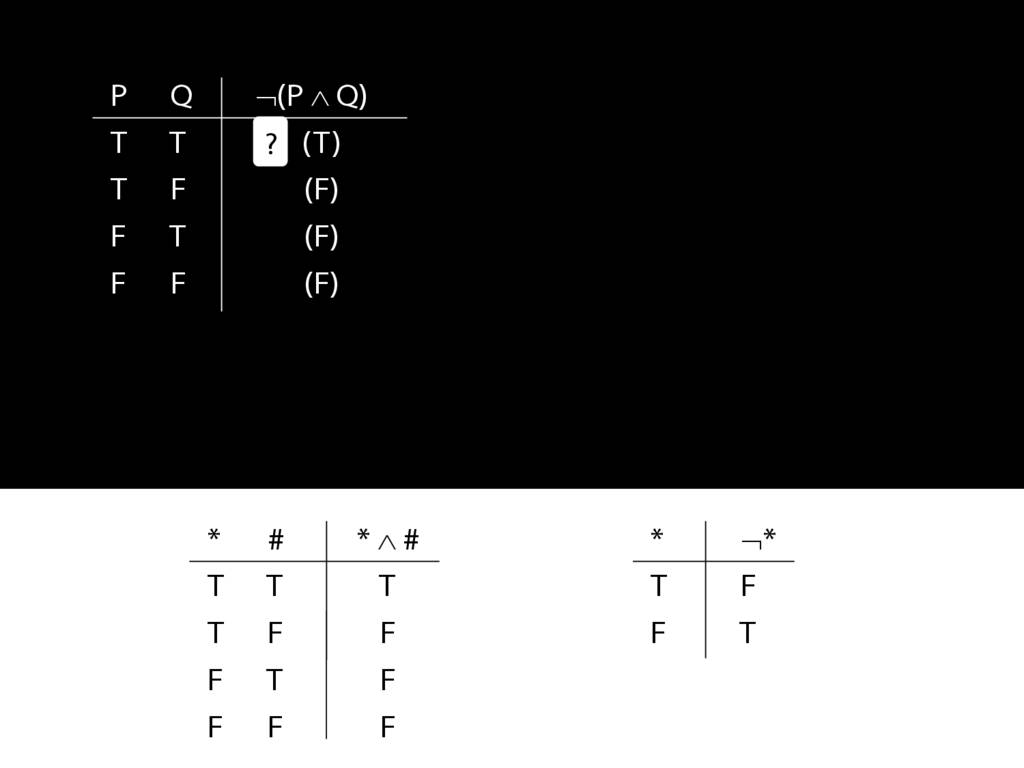
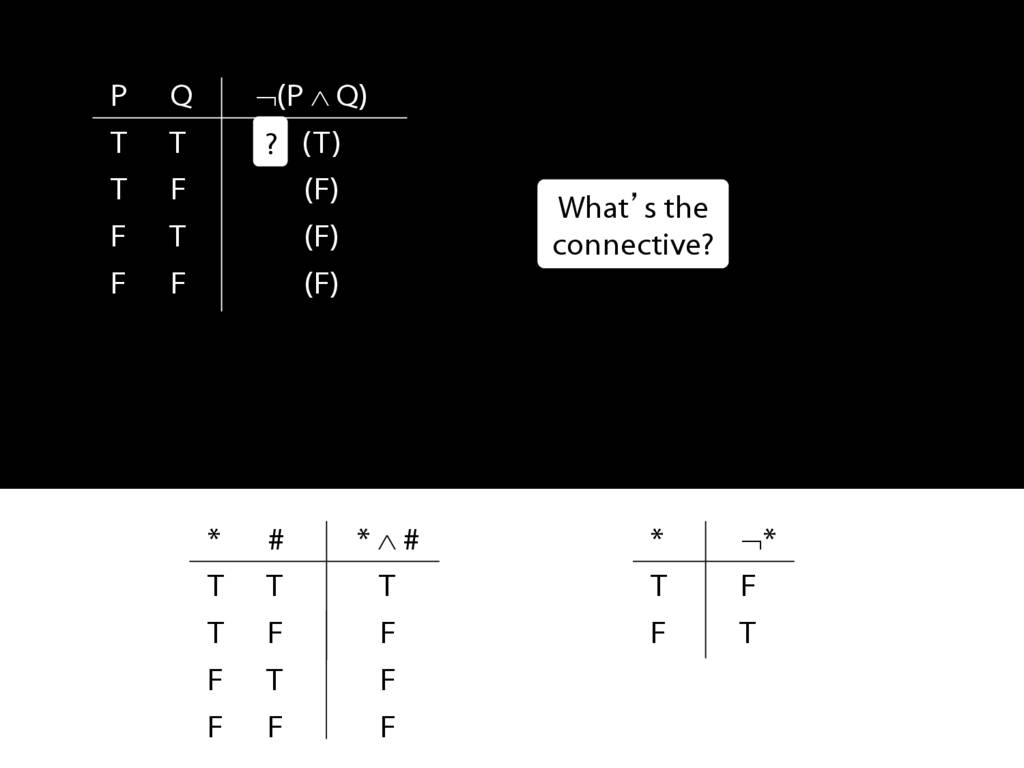
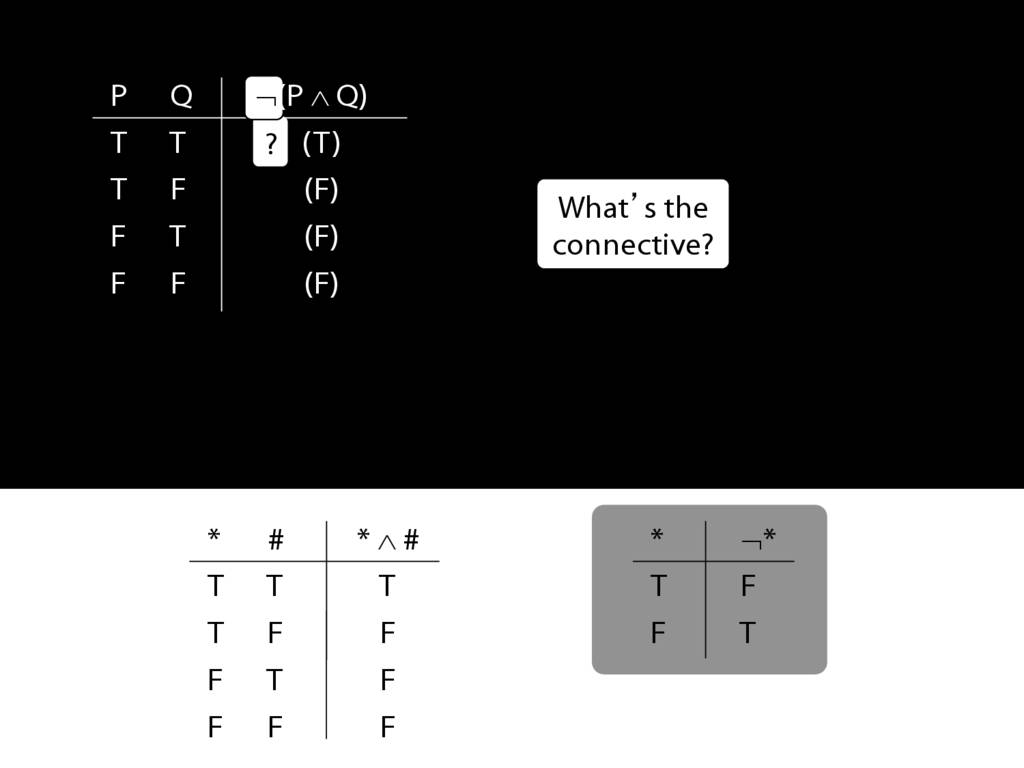

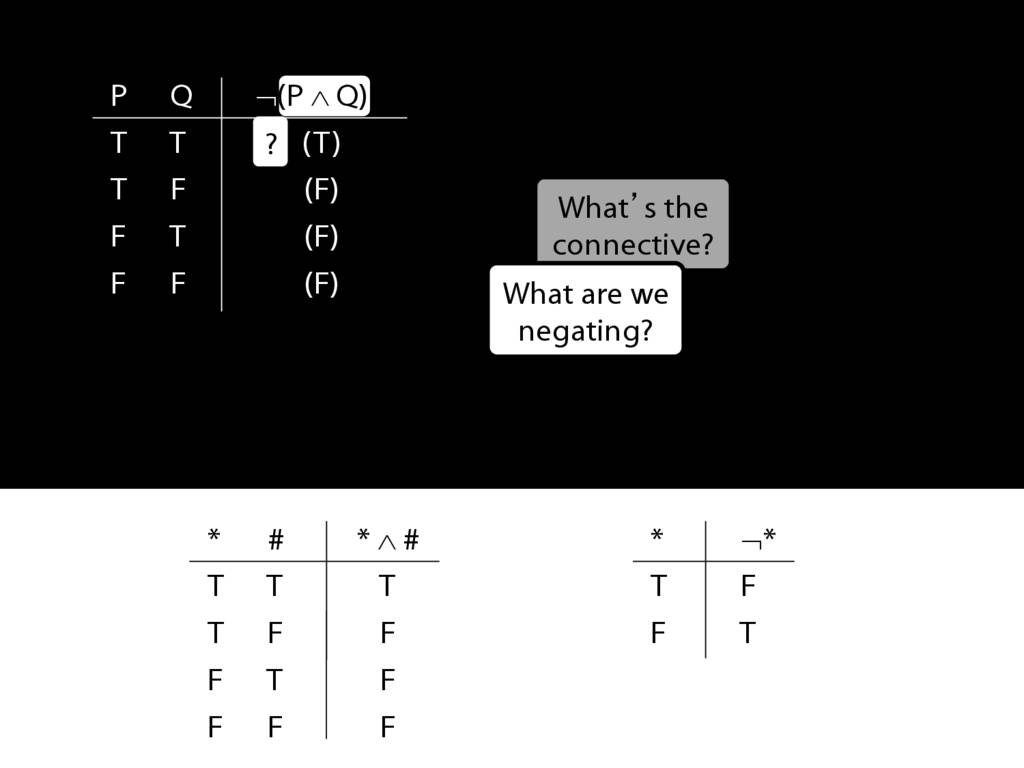
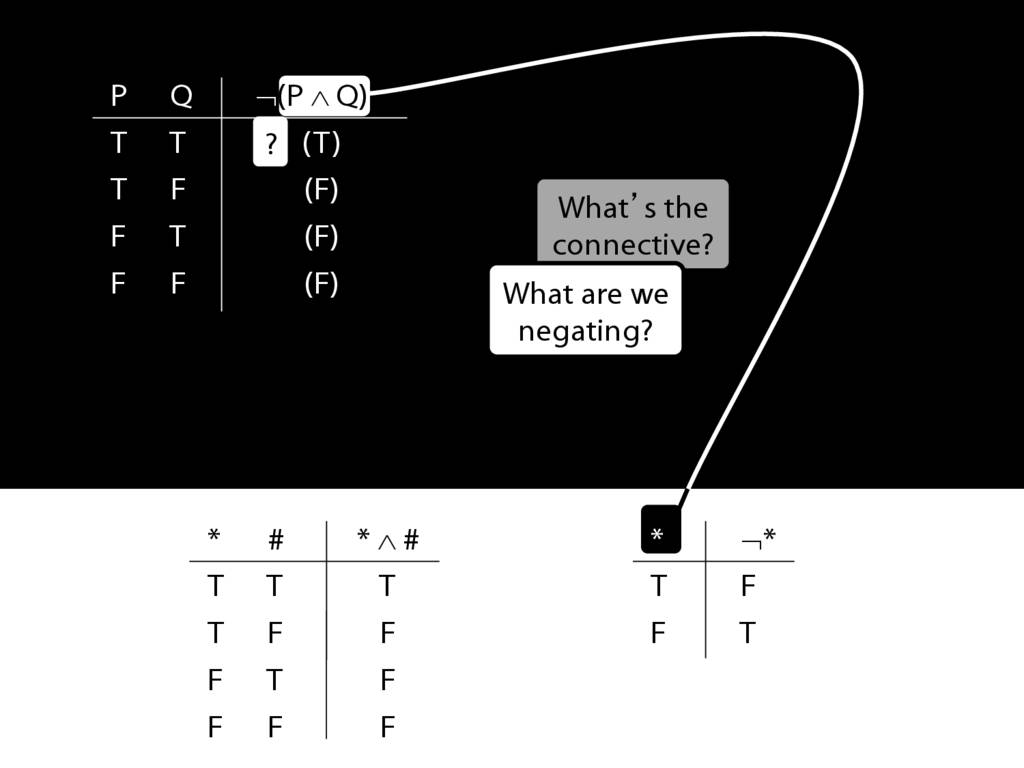
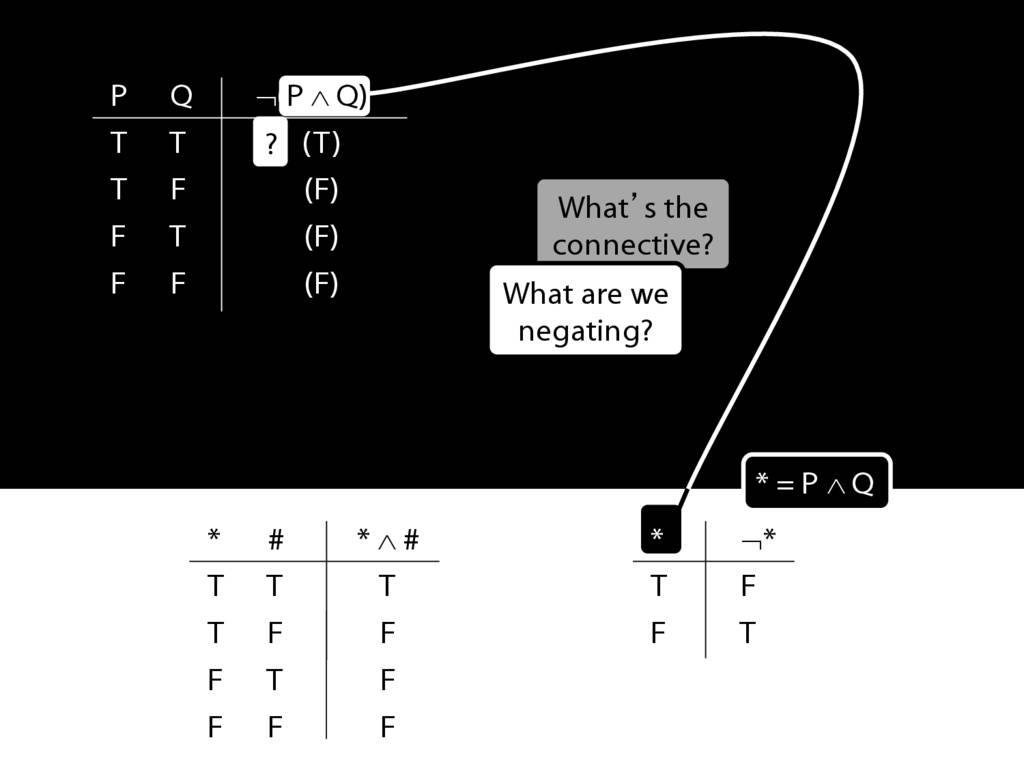
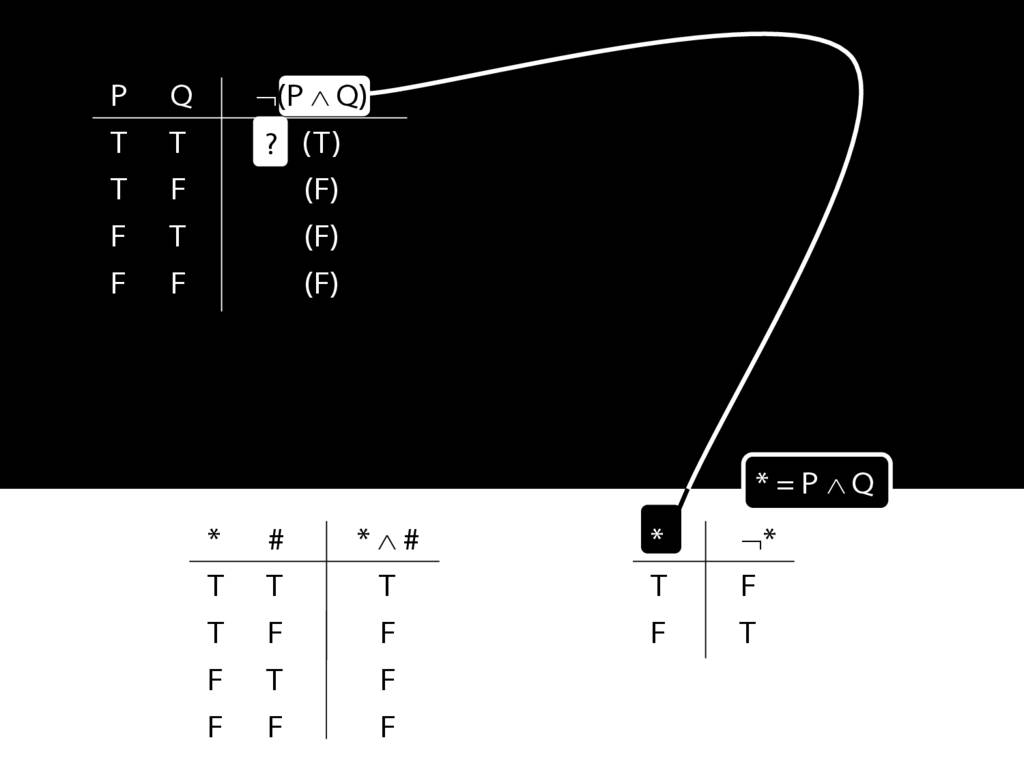
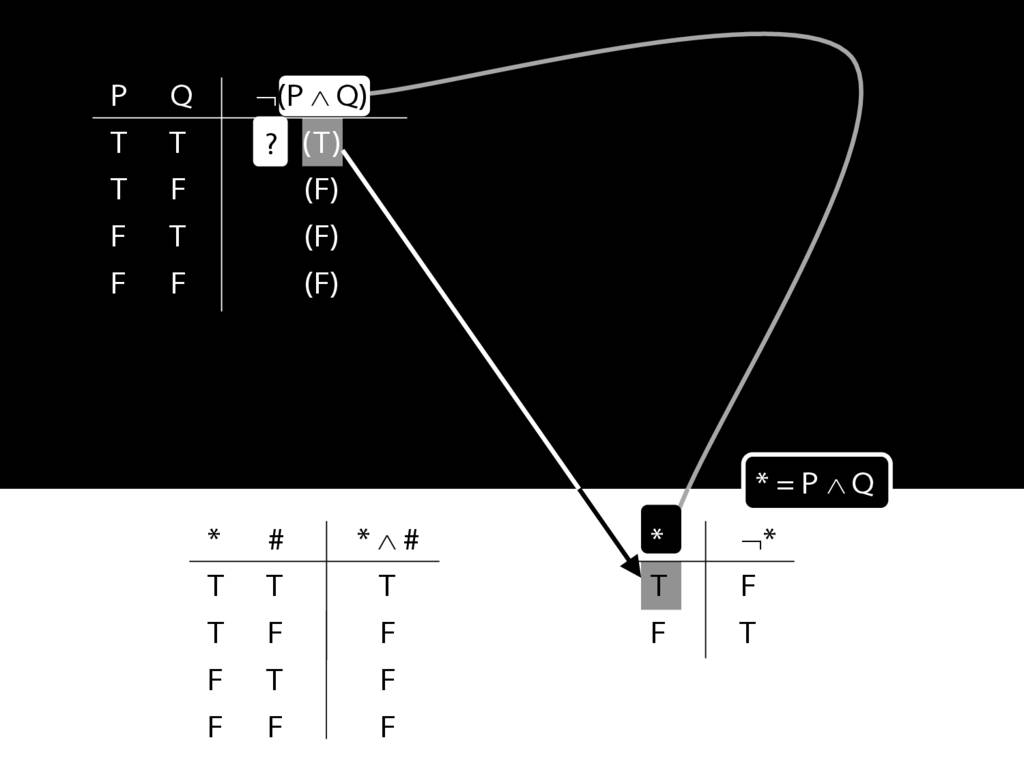
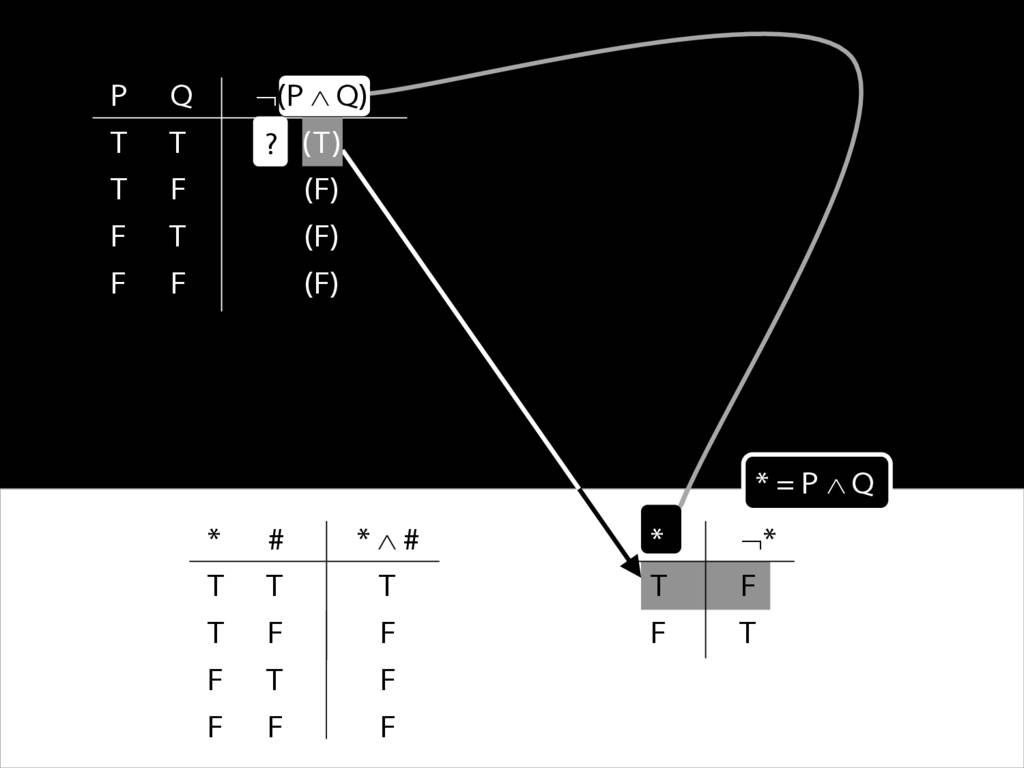
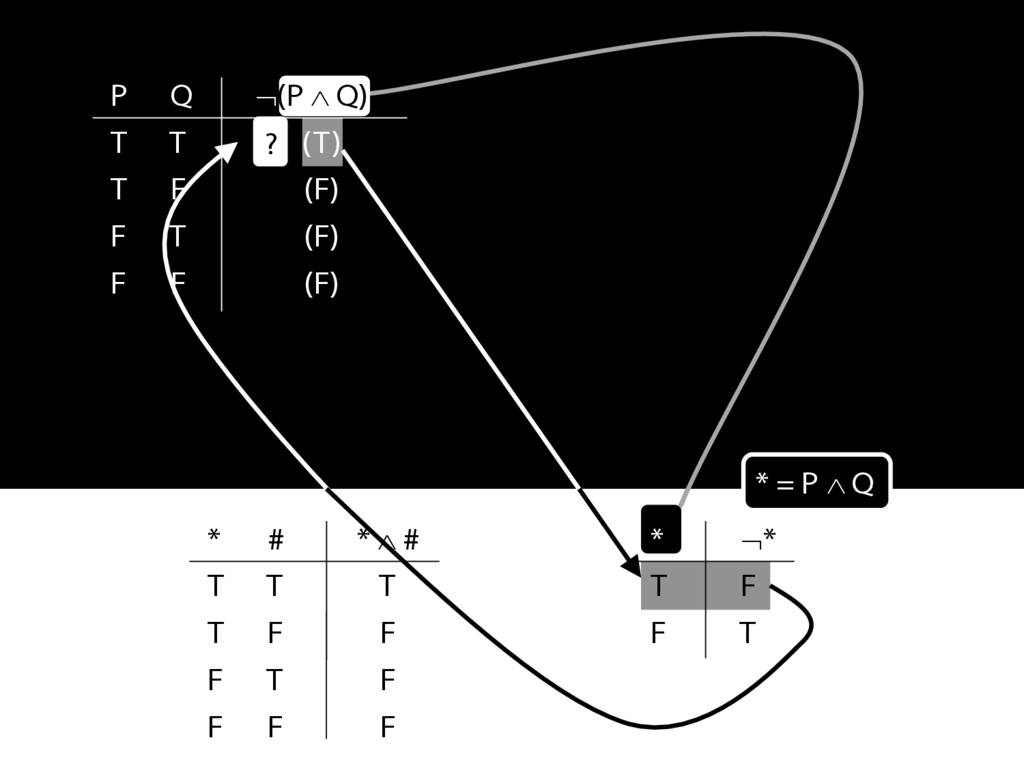
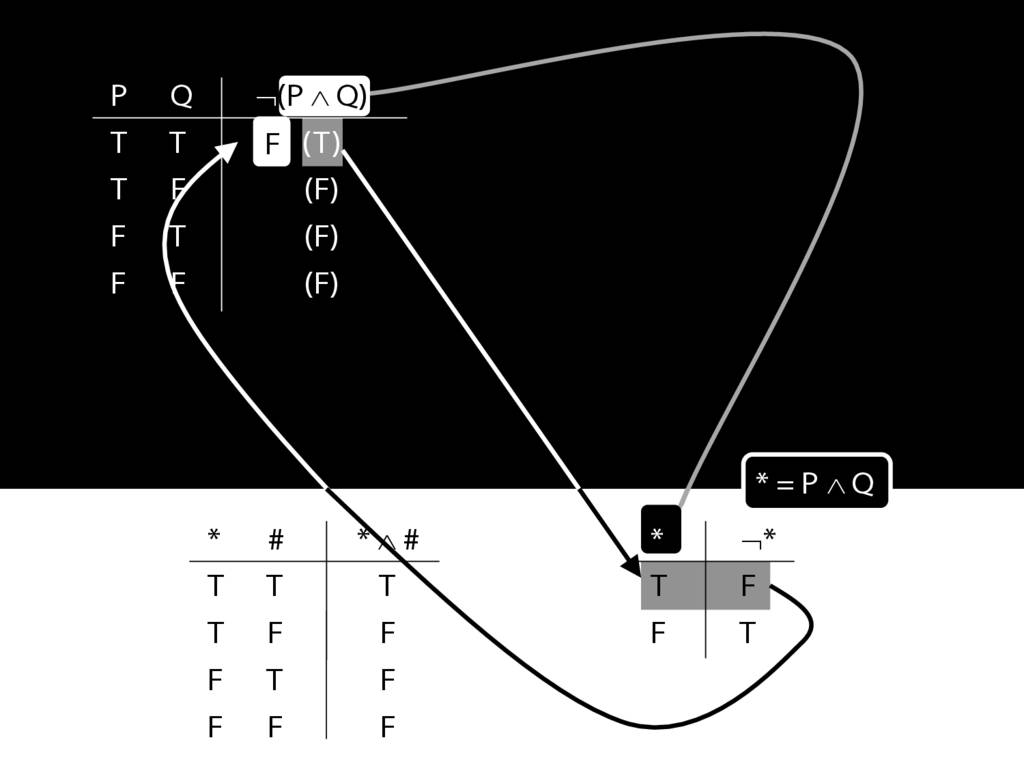
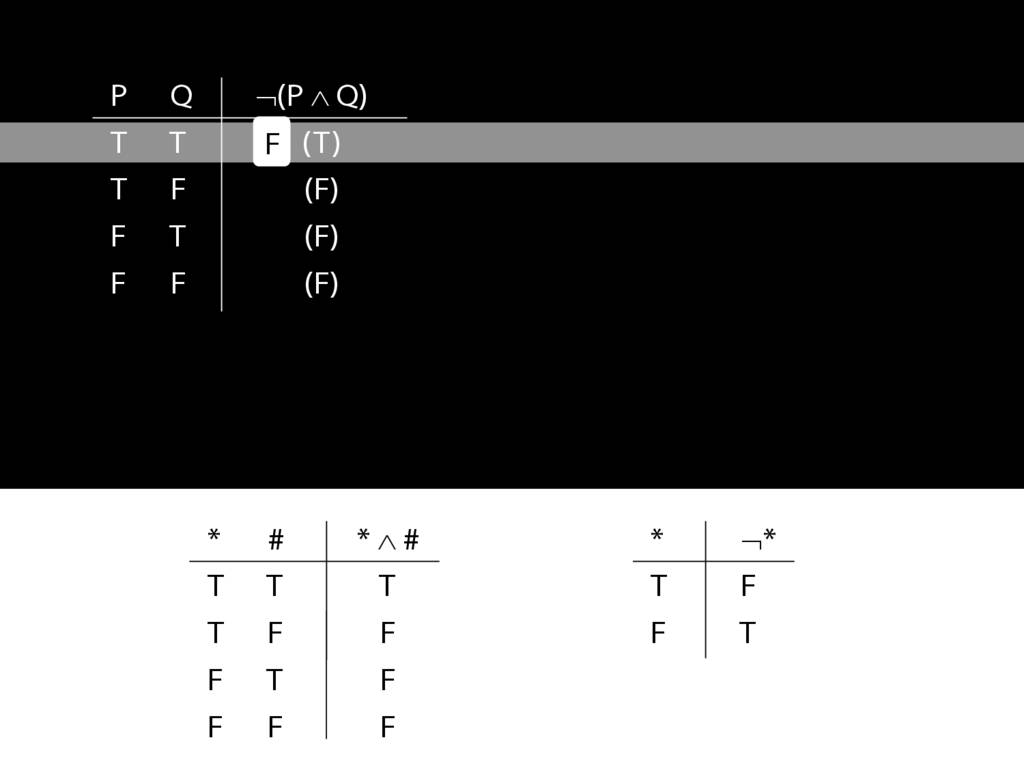
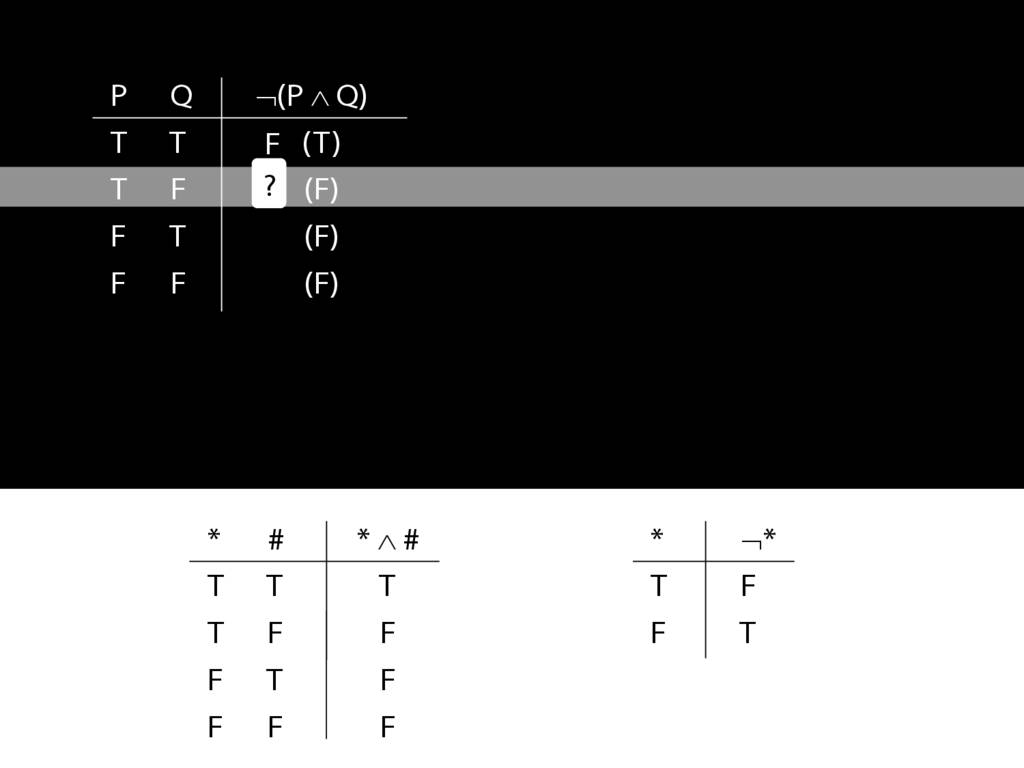
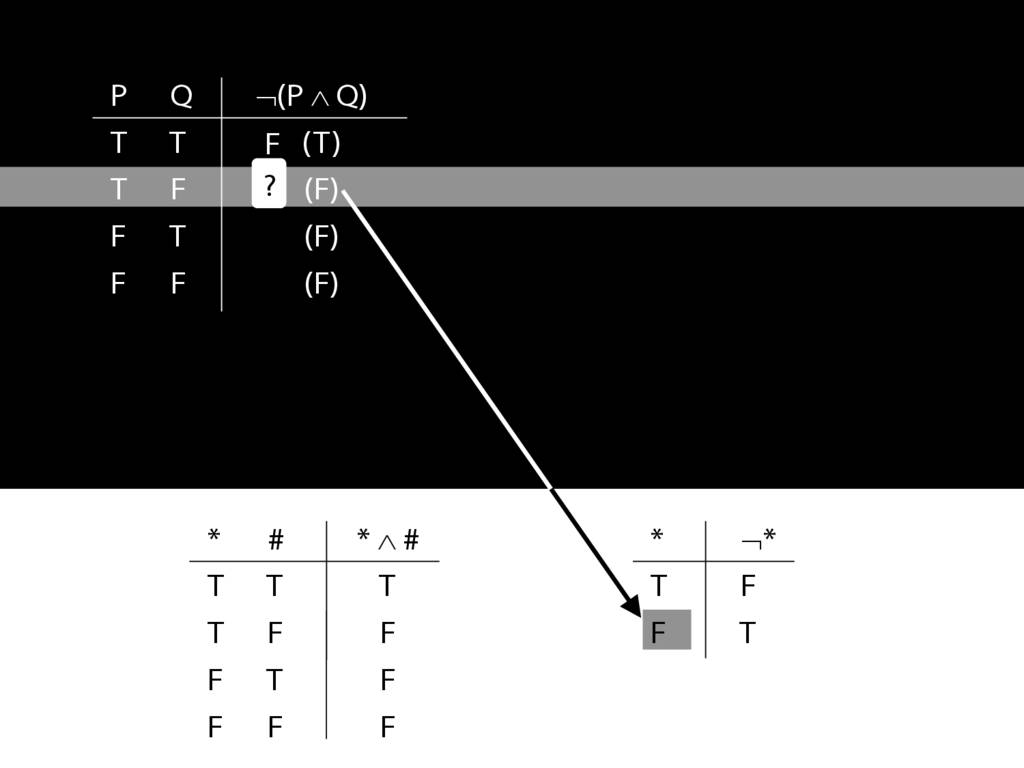
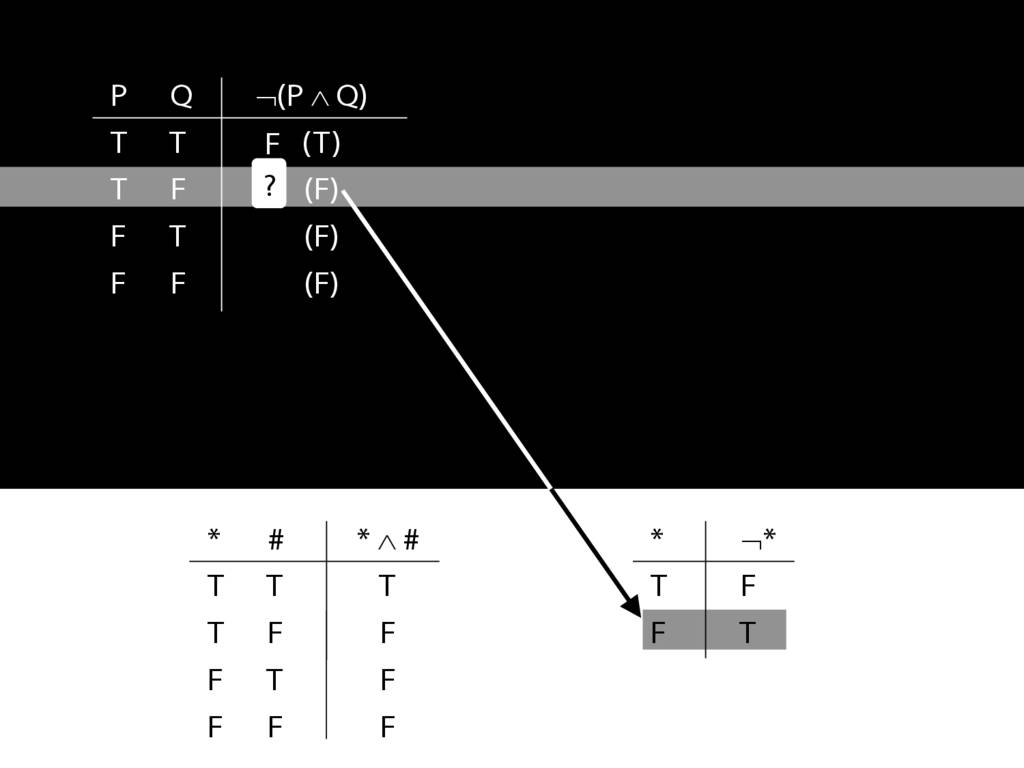
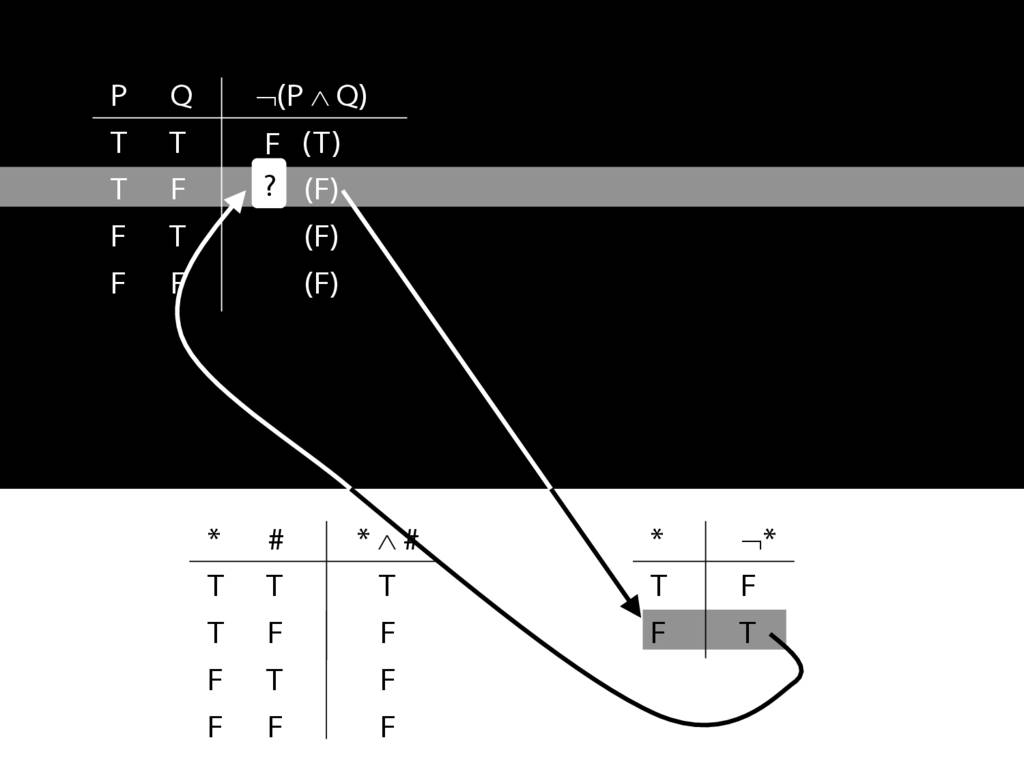
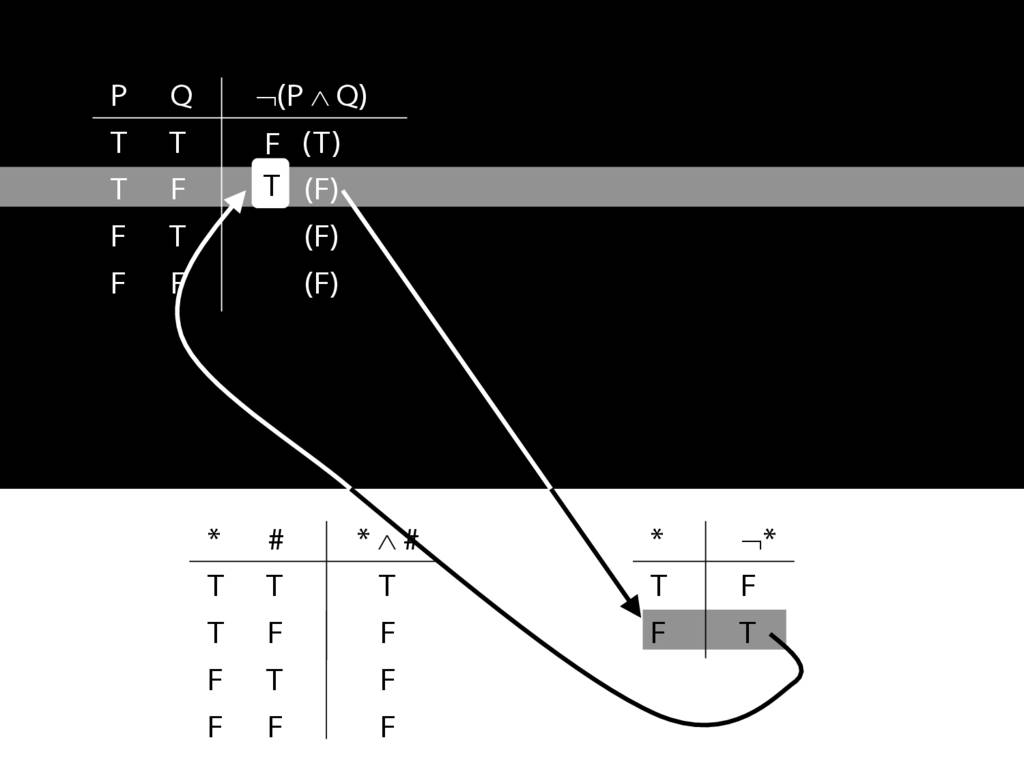
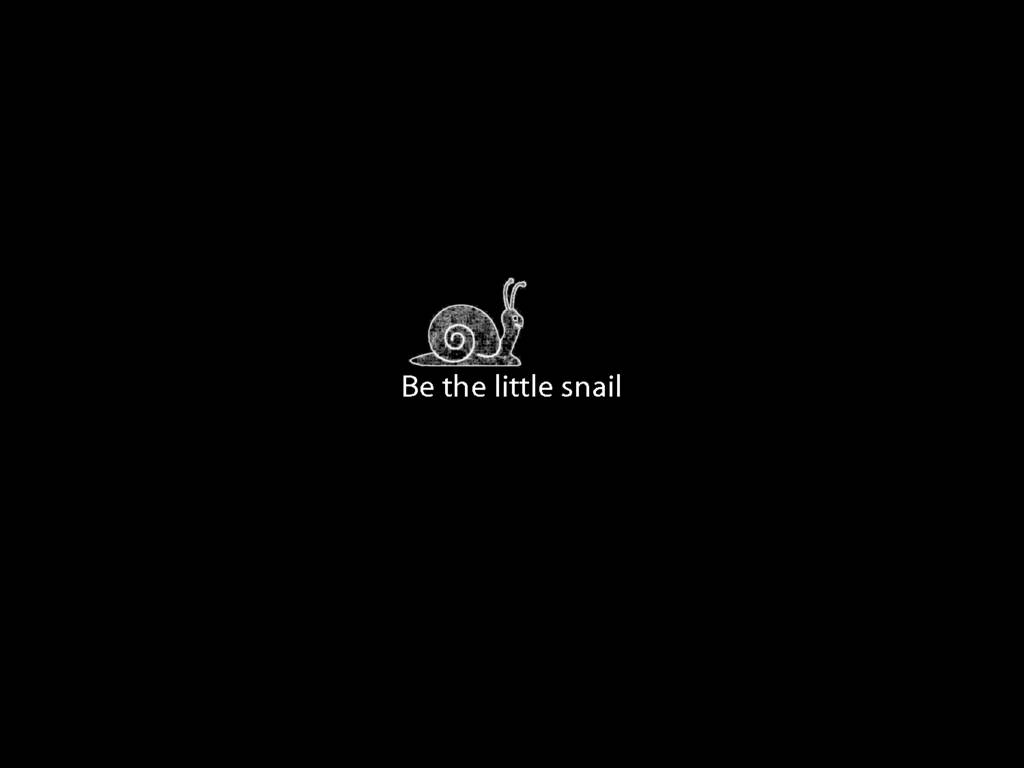
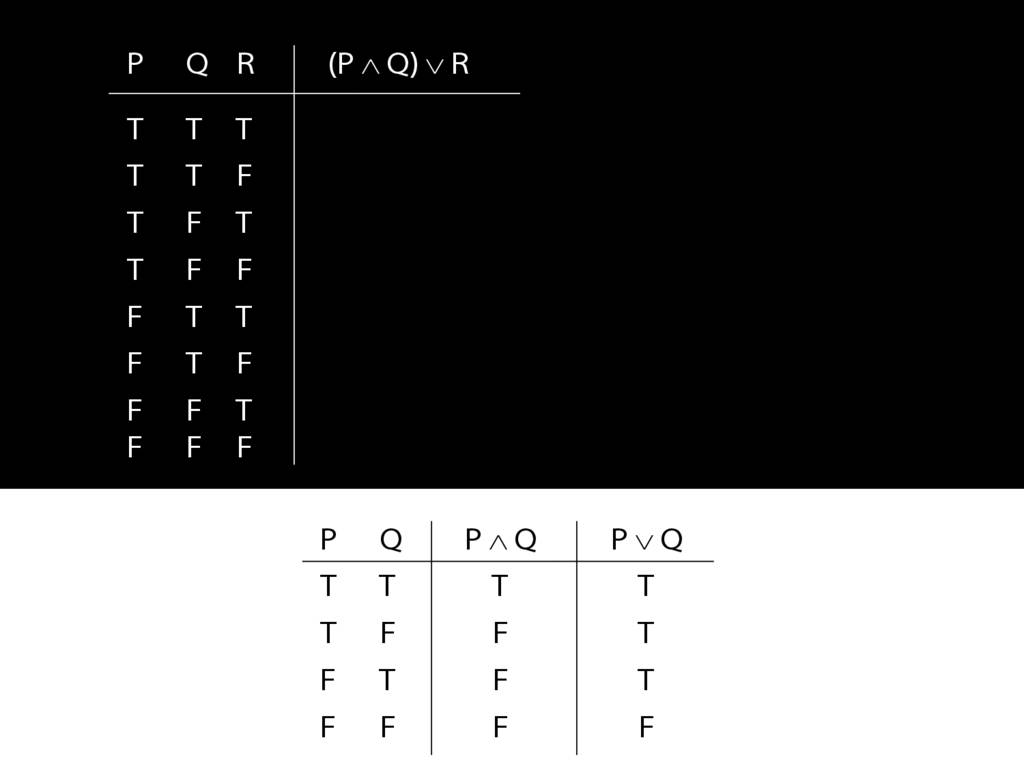
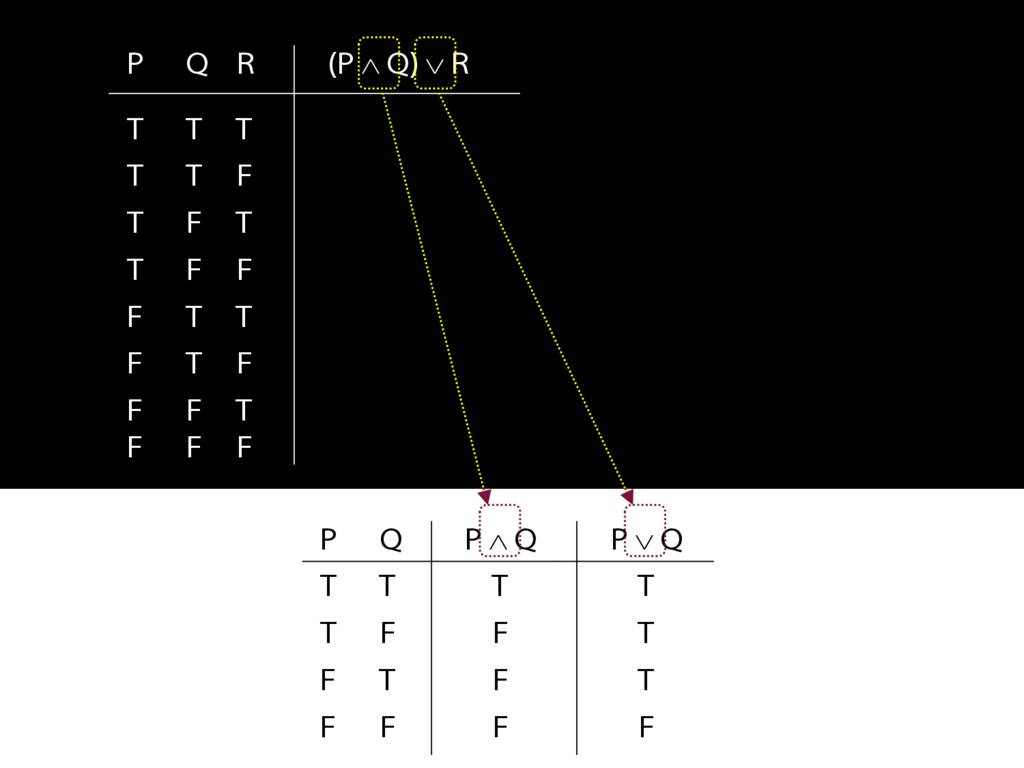

Contradictions, Logical Truths and Logical Possibilities
\section{Contradictions, Logical Truths and Logical Possibilities}
\emph{Reading:} §2.2
\section{Contradictions, Logical Truths and Logical Possibilities}
A \emph{contradiction} is a sentence that is
false in all possible situations.
A \emph{logical truth} is a sentence that is
true in all possible situations.
A \emph{logical possibility} is a sentence that is
true in one or more possible situations.
contradiction
A sentence that is false in all possible situations.
E.g.
| A | A ∧ ¬A |
| T | F |
| F | F |
logical truth
A sentence that is true in all possible situations.
E.g.
| A | A ∨ ¬A |
| T | T |
| F | T |
logical possibility
a sentence that is true in one or more possible situations.
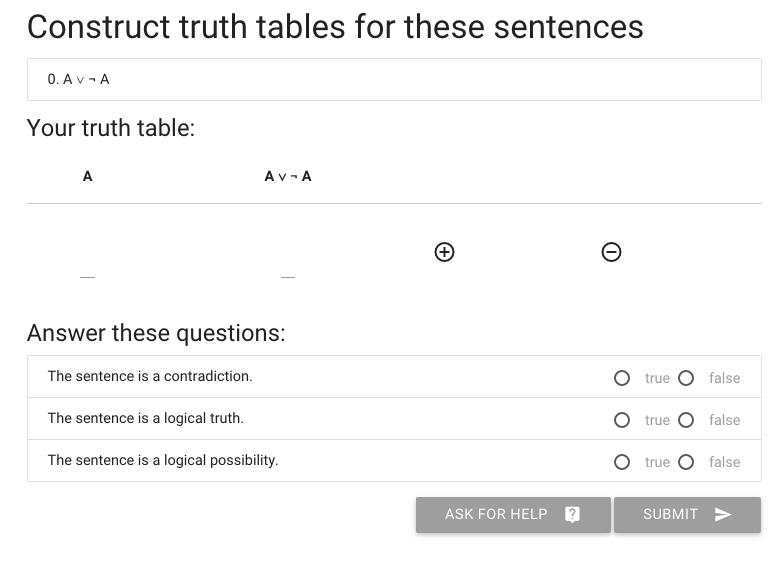
I’ll illustrate how this works in logic-ex.
Let’s say we want to construct the truth table for A or not A.
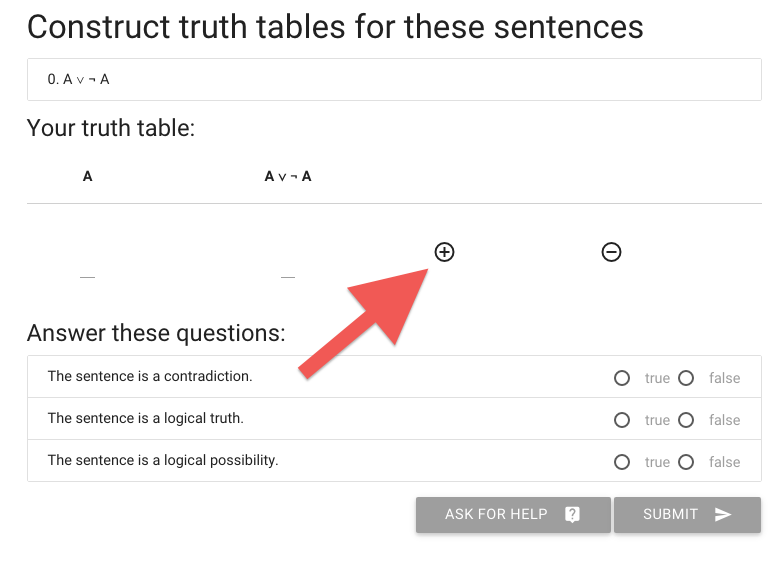
The first thing I need is more rows, so I hit the circled plus thing.
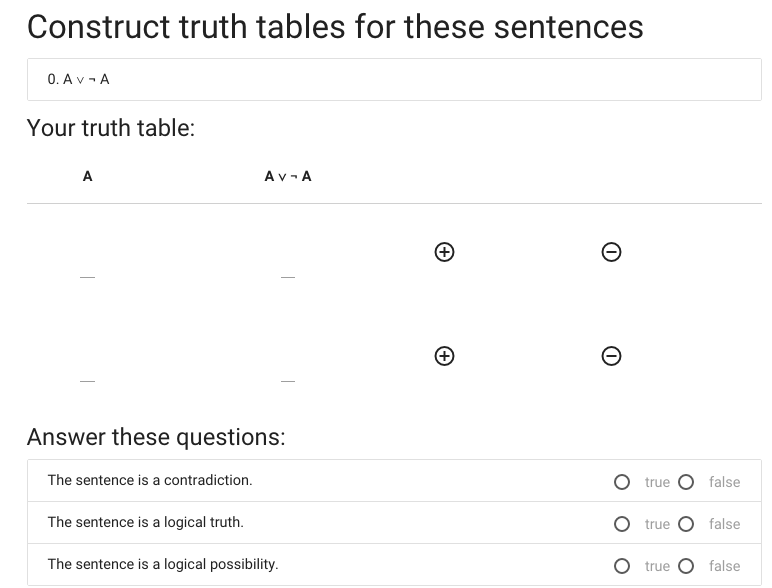
Now I’ve got a second row, and in this case two rows is enough.
Time to start filling in values ...
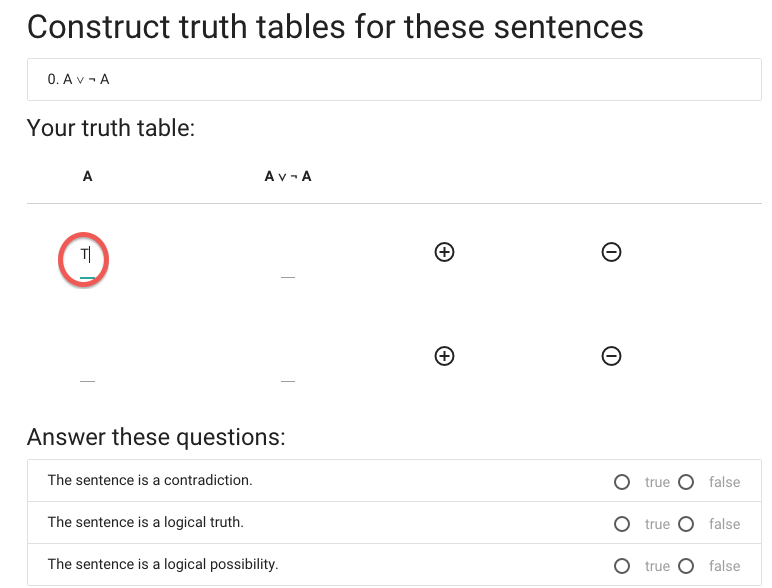
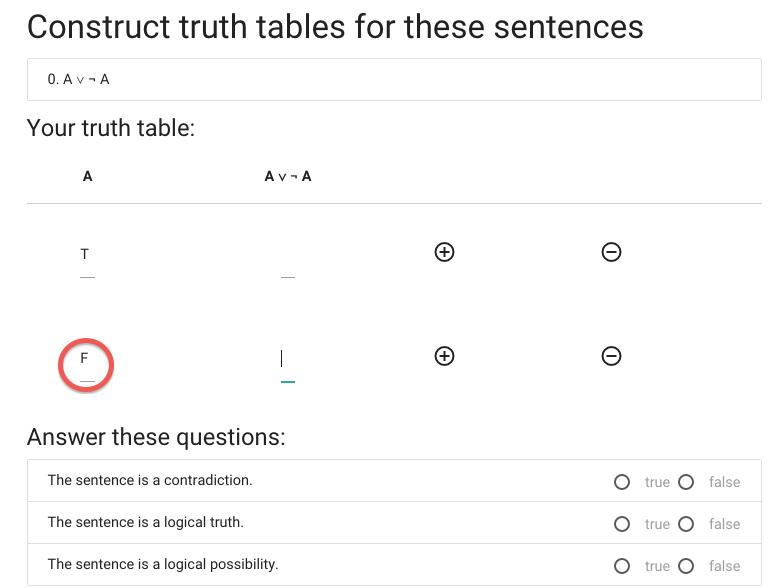
I’m doing the reference columns first because these are always the same
and I don’t need to work out what the values are.
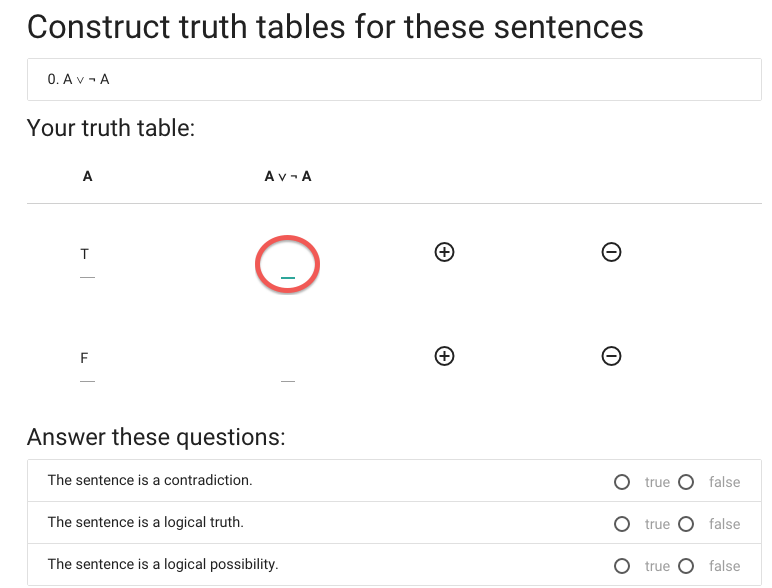
Now I have to enter the value of A or not A when A is true.
You might be able to compute this in value in your head, but
that won’t always be the case. I expect that, often, before
you enter a value in the table in zoxiy you will have taken
a pencil and paper and worked out the truth table step by step.
So what you enter will often be something that took quite a bit
of work to compute.
Or you could just guess. But this is not generally a good strategy
because I take the view that a truth table is either right or wrong,
and if you are really guessing you only have a 1/16 chance of being
right for most truth tables.
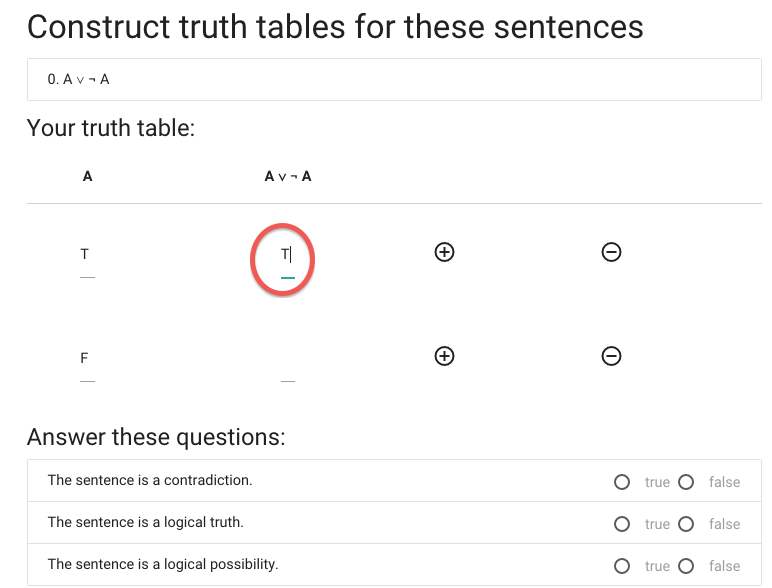
Anyway, I think it’s true.
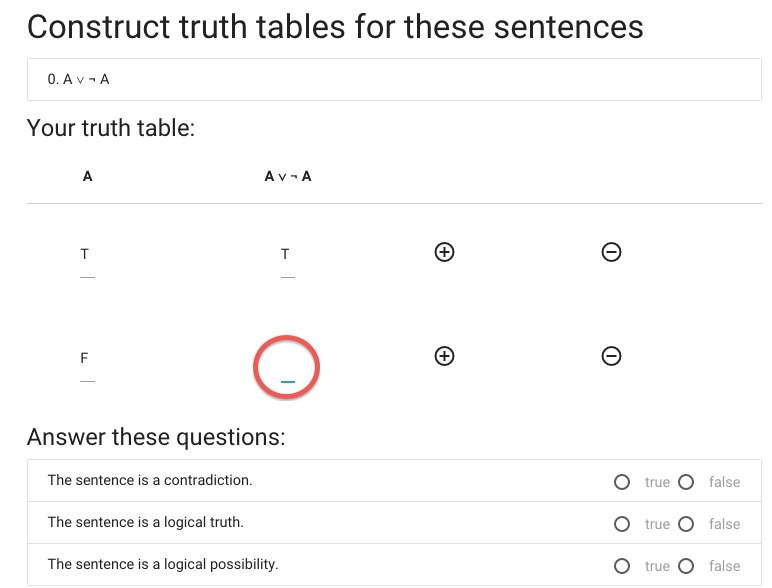
Now for the last truth value.

This is also true.
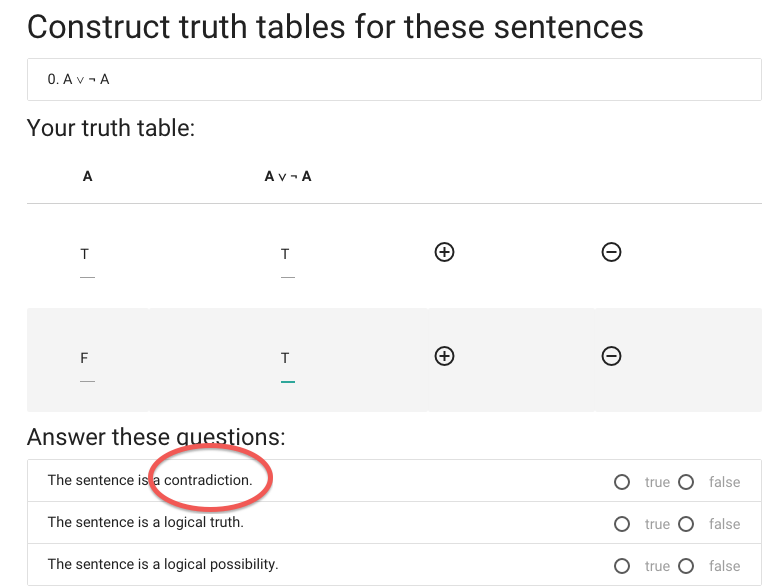
We’re not done yet, we now have to say whether the
sentence is a contradiction.
A \emph{contradiction} is a sentence that is
false in all possible situations.

This sentence isn’t
false in all possible situations ...
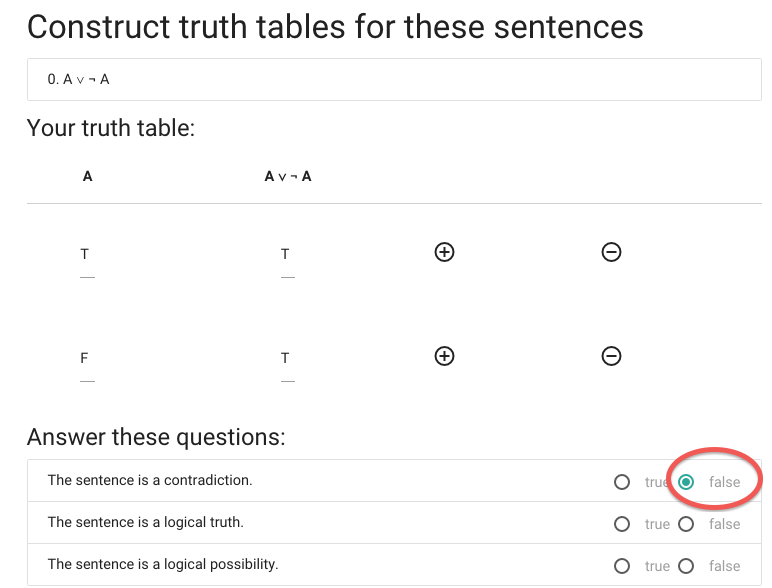
... so it isn’t a contradiction.

Next we have to specify whether ‘A or not A’ is a logical truth.
A \emph{logical truth} is a sentence that is
true in all possible situations.
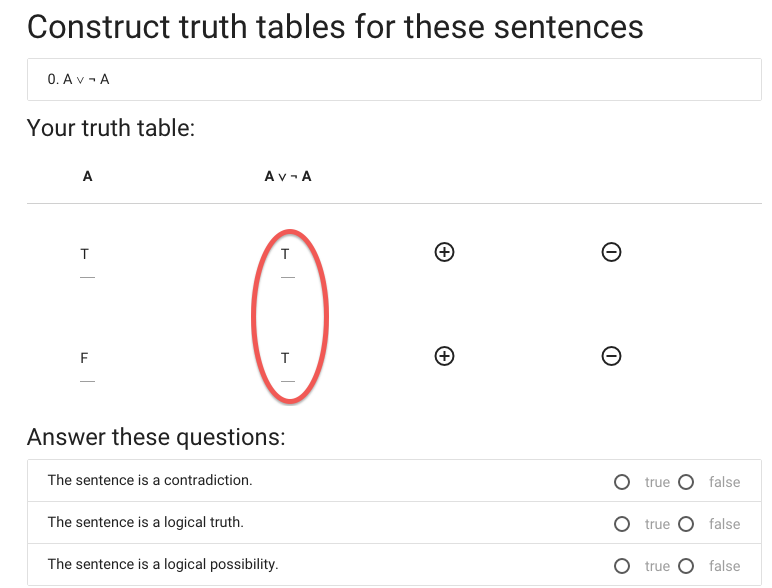
This sentence is true in all possible situations ...
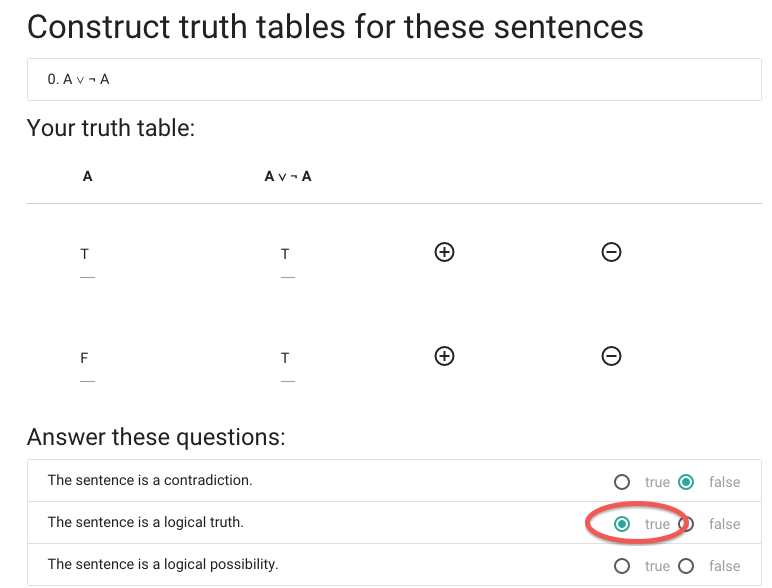
... so this sentence is a logical truth.
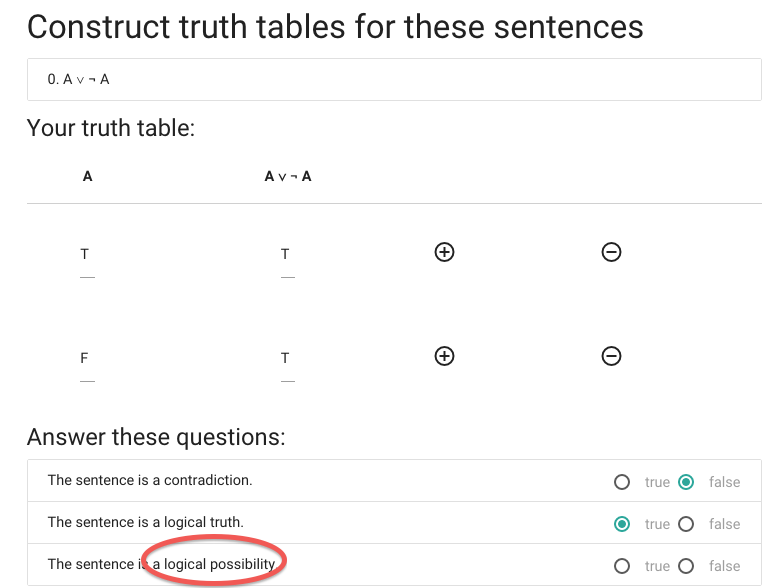
Finally, we’re asked whether the sentence is a logical possibility.
A \emph{logical possibility} is a sentence that is
true in one or more possible situations.

This sentence is true in at least one possible situation ...
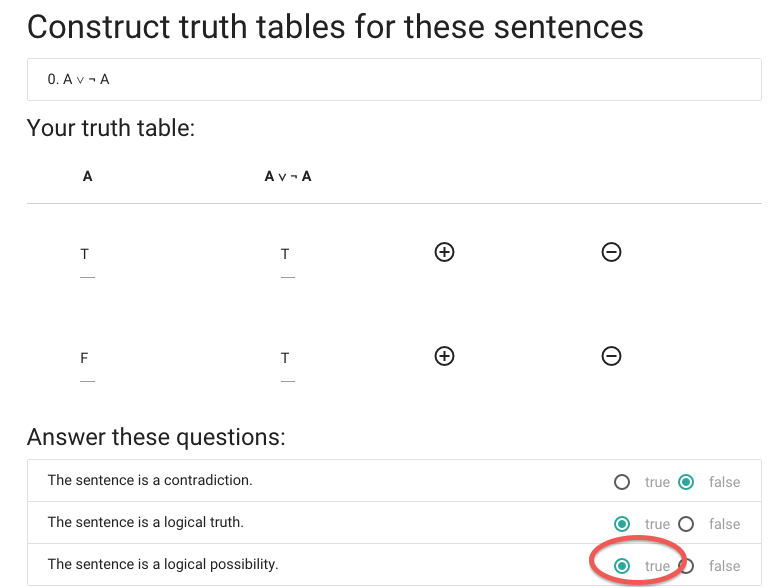
... so this sentence is a logical possibility.
2.5, 2.6